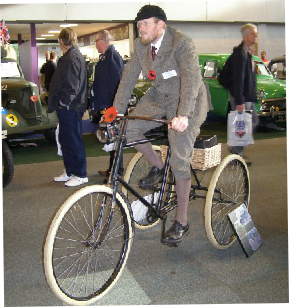10/26
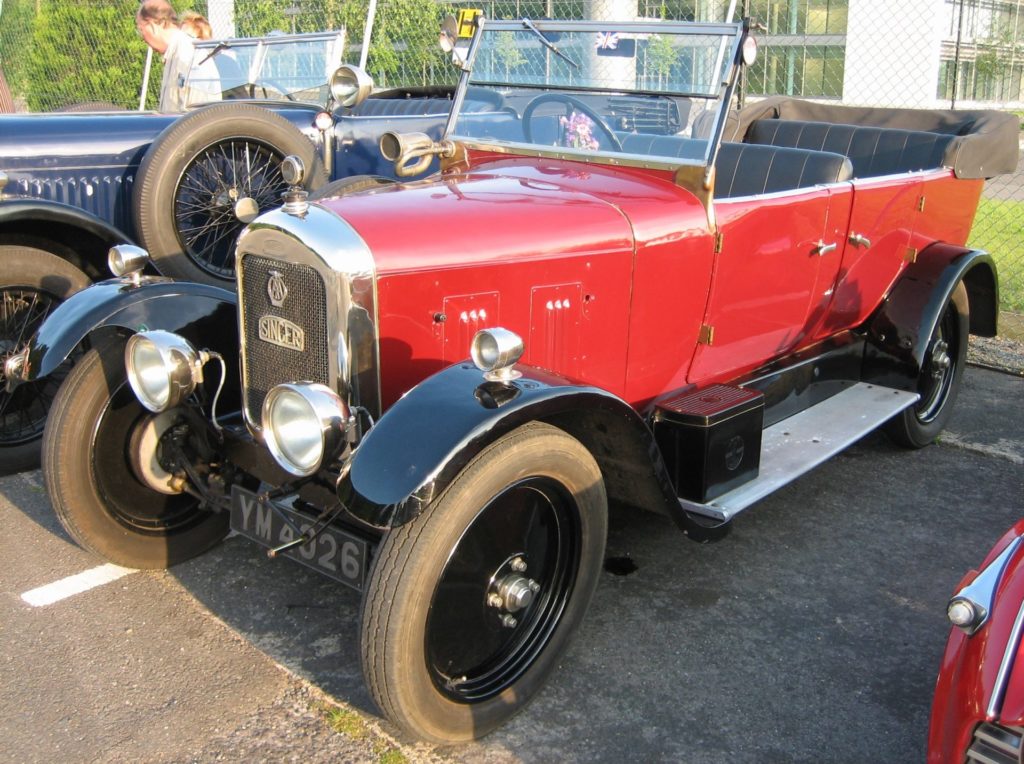
This is Roger Horsfield’s 1926 Singer 10/26 Deluxe.
My Trusty 1926 Singer 10/26 Deluxe
Reg No YM4026
First registered on 12/01/1926 it is believed to have a build date of July/August 1925 and originally came with a front axle with no front brakes. A later front axle with front wheel brakes was fitted at some time. I still have the original front axle as shown in the photograph below. YM was a London registration issued between November 1925 and March 1926 so is the original registration number. The cost brand new in 1926 with nickel plated radiator and fittings with a complete set of tools was £225 0s 0d.
There are a few peculiarities with the Singer 10/26 as it only has 3 doors, the driver has to enter via the front passenger door, it has a central accelerator and a right hand gear change. The 1308cc engine is quite advanced in that it has overhead valves rather than less efficient side valves, The 10/26 designation relates to the engine developing 10 Horse Power and 26 Brake Horse Power.
The Singer was discovered having been dumped in a farmyard at Epping since 1941. It was bought in dilapidated condition in 1943 for £6. 10s. 0d by Brian King from the Nunn brothers who owned the farm. The car was taxed in 1942 and had a war time log book in the name of Percy William Francis. The odometer reading on the speedo read 47928.
The car was red rust all over, on blocks, the five wheels in the back, the tyres full of water and corn and grass had taken root on the floor and behind the rear seat. The hood was perished and the radiator had a large hole in it. Another radiator was bought for 5 shillings which didn’t work so a new block in the old shell did the trick. The front seat and floorboards were rotten, which were replaced with second hand bucket seats and new floorboards. The air cushion in the rear seat was still inflated.
Brian King was a very enthusiastic owner who loved driving it and had a significant motoring tour every summer for which he produced detailed logs, which I have, showing the places visited, the mileage completed each day and the petrol purchased.
eg
1950: 850 mile Tour from Basingstoke to Lands End and back
1951: 1930 mile Tour to from Stamford to John o’Groats and Back
1953 2094 mile Tour London to John o’Groats to Lands End and home

Brian had a driving licence for 69 years which was clean for all that time. He became a member of the the AA in 1951 and remained a member for 61 years during which time he never had to call on their services. He owned the Singer 10/26 for 33 years and completed some 60,000 miles in it.
In 1976 Brian Saxby owned the car and actively used it with his family.
In 1989 I bought the Singer with ~148,000 miles recorded and had enjoyable motoring in it taking it to various Singer Annual Rallies and using it for two family weddings until I sold it to buy a 1947 MG TC.
In July 1997 the next owner was Rob Malcolm who in 1998 completed a 436 mile Tour to and around Isle of Man Tour and attended various Singer Rallies.
The engine was overhauled and 4000 trouble free miles then completed.
In November 2001 it was sold to Bob Andrews who is well known to the Singer Owners’ Club.
In December 2004 having located the Singer for sale on the internet I contacted Bob and viewed the Singer. My fiancé of only 25 years engagement was a trifle impetuous and mentioned that I could have the Singer back again if we got married. I liked the car so much that the next owner was me again although I do regard it as being the ‘most expensive car in the World’!!! The mileage was 152,460.
I attended the Singer Car Centenary at Coventry in 2005 and various Singer National days around the country winning the occasional cup.

I have subsequently driven the Singer on many trips in England, provided lifts to School Proms, completed two trips around Brittany and used it as a wedding car again. The present mileage is 160,837 and Covid regulations permitting I am looking forward to driving the Singer in France again this September and who knows where in subsequent years.

There are a number of folders containing a lot of early documentation relating to my Singer 10/26 including an Owners’ Handbook, sales brochures, technical information and the majority of the tax discs from 1947 to 2014
Senior As-U-Dryv Sun Saloon
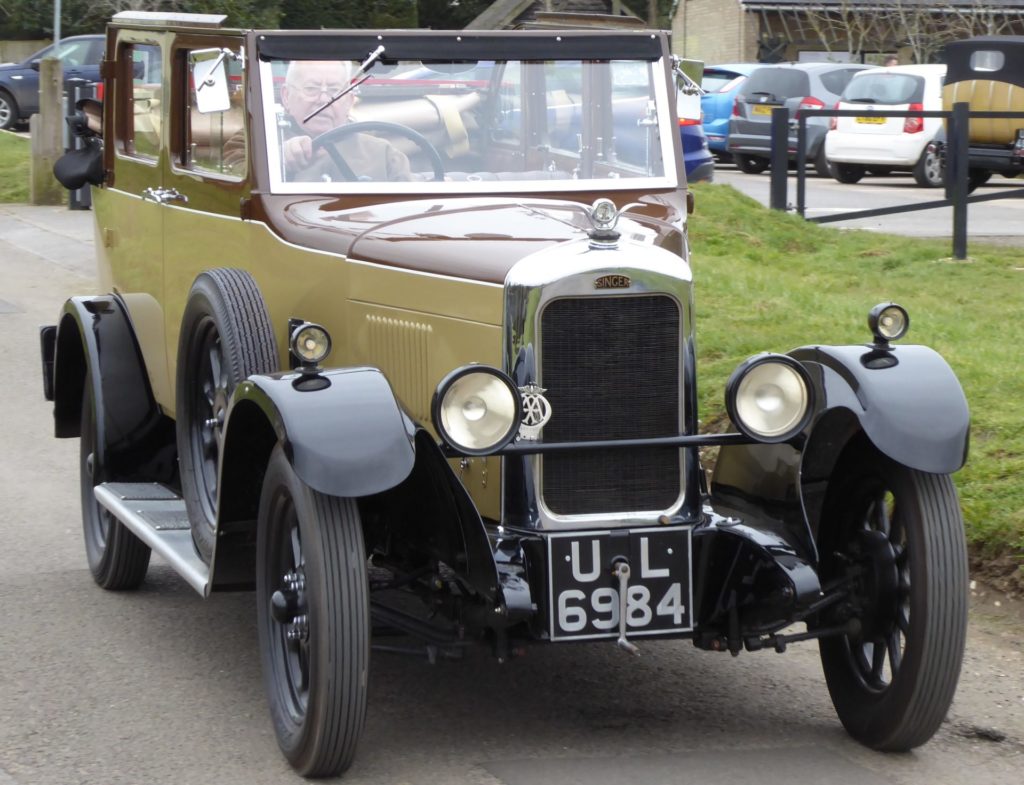
This is Brian Walton’s newly restored 1929 Senior As-U-Dryv. The picture below shows the car (left) with Simon Bishop’s As-U-Dryv. Incredibly, they bear consecutive body numbers – Brian’s is B 106 and Simon’s is B 107 .
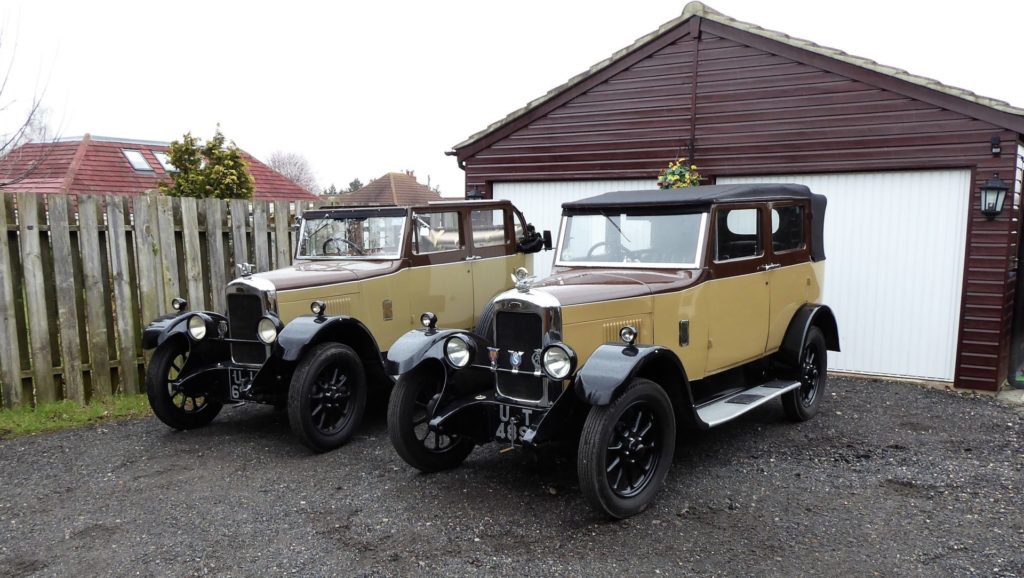
Singer Vogue MK IV Estate 1725cc
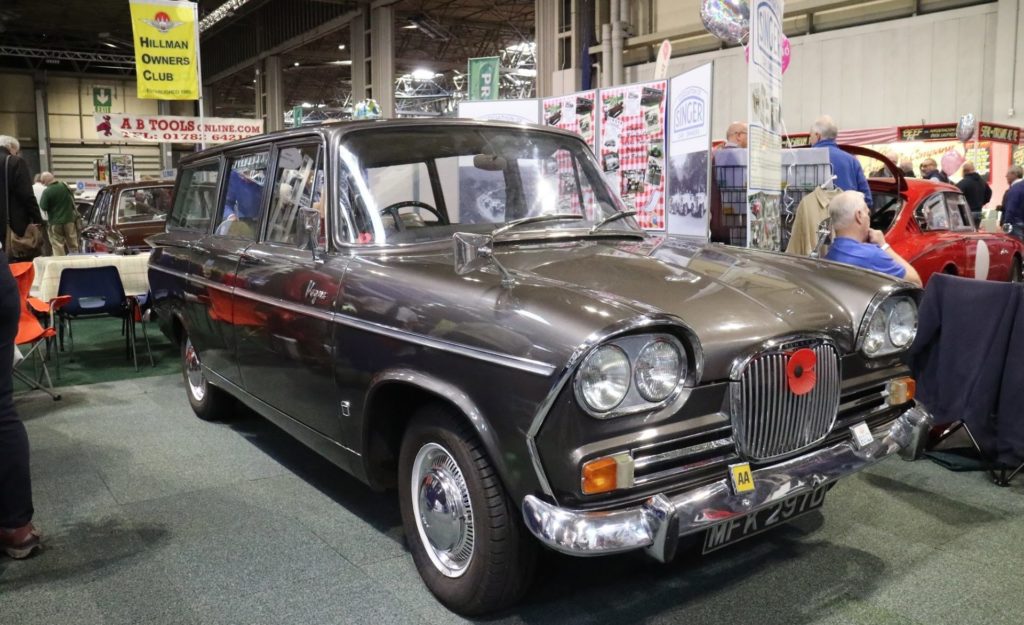
This is David Clutterbuck’s 1966 Vogue MK IV Estate 1725cc.
David writes …
‘Around 10 years ago my Dad was asked by a good friend if a mate of his could store an old car for a few weeks and after a while a Singer Vogue Mk IV arrived looking very sorry for itself. The car stayed for a year or so and eventually my dad bought it for £150, and set about restoring it.
We managed to get it running after removing the aftermarket electronic ignition assembly, fresh oil, filters, spark plugs, coil, points, HT leads, refurb fuel pump and a twin choke Weber. A local lad Paul did a lot of work fabricating panels, rear wheel arches, welding new sills etc, and preparing the bodywork to high standard for respraying.
My dad thought the car would look nice in a metallic blue but thankfully after many discussions he decided on the original Burnt Almond. It turns out that we think this is the only surviving Singer Vogue Estate or Saloon finished in Burnt Almond.
My dad did get to enjoy driving the car for a few years until he passed away in 2016, after which I inherited this wonderful car. He often said it would be a different car with an overdrive gearbox. In the summer of 2018 I acquired a scrap Vogue of the same year with an overdrive gearbox which I removed and which is now installed.
We use the car regularly for days out and various car shows. We need to get round to purchasing new carpet set next’.
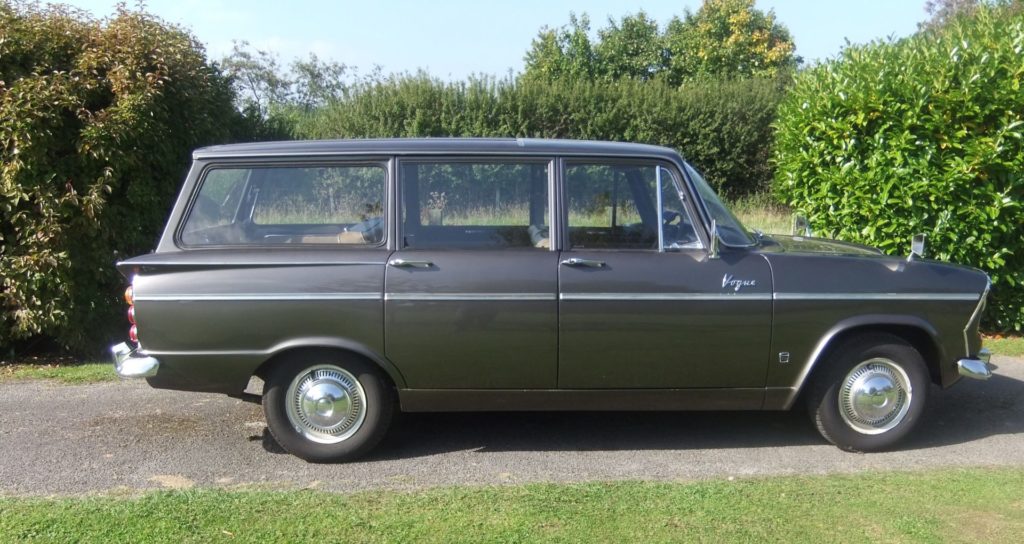
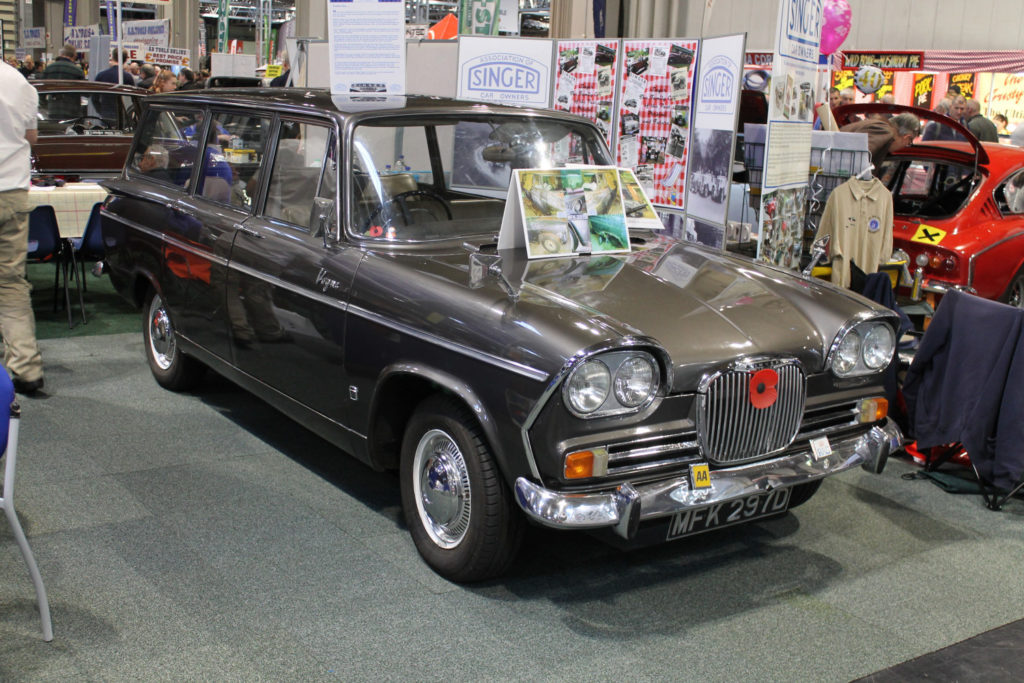
1.5 Litre Sports Saloon
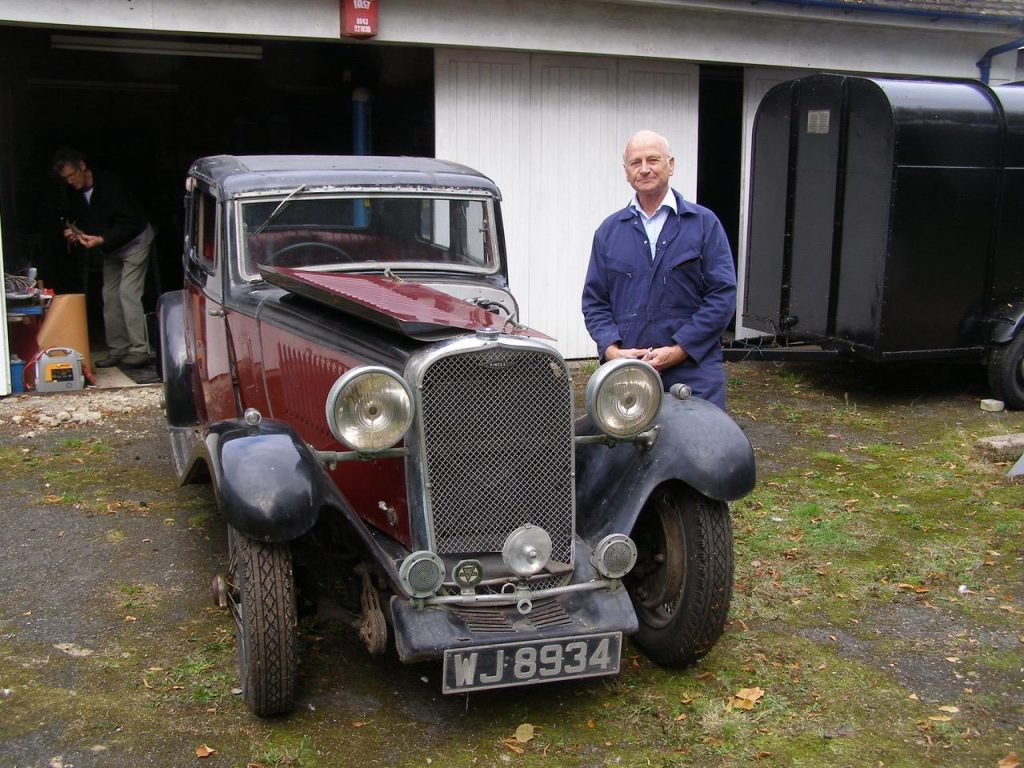
This is Peter Watts’ 1934 1.5 litre Sports Saloon.
In the summer of 2017, a lady in Canterbury put a notice on our club website to say that she was disposing of her father’s collection of old cars, one of which was a 1934 1.5 litre Singer Sports Saloon, was anybody interested in buying it? There were probably less than 200 1.5 litre 6-cylinder Singers produced about 92 of which were Sports Saloons and about 75 were open cars. However, although a reasonable number of the open cars have survived, we only know of two Sports Saloons still in existence. One of these is a 1933 model, which is different in several respects from this 1934 model, making this car the only one of its kind that we know of. Peter lost no time in agreeing to buy it, and collected it in September of that year, with the help of SImon Bishop, who was then our Chairman. As the pictures show, it is currently painted black and red, but the first owner, a lady who lived on The Wirral, ordered it with Carnation Red roof, wings and bonnet top, Ivory body sides and Ivory wheels. Interestingly, in the 1960s it had been owned by John Horne who, until his recent sad demise, was our Honorary President. In his ownership it was grey. He had sold it to another of our members, Bob Andrew, but, after he passed it on, it disappeared off the radar, until resurfacing in Canterbury.There is a lot of work to do in refurbishing the body frame, which has suffered from rot and woodworm, but the work has been on hold for a couple of years while Peter finishes the restoration of his 1949 Austin Sheerline. At the beginning of 2021, work on the car was about to start again.
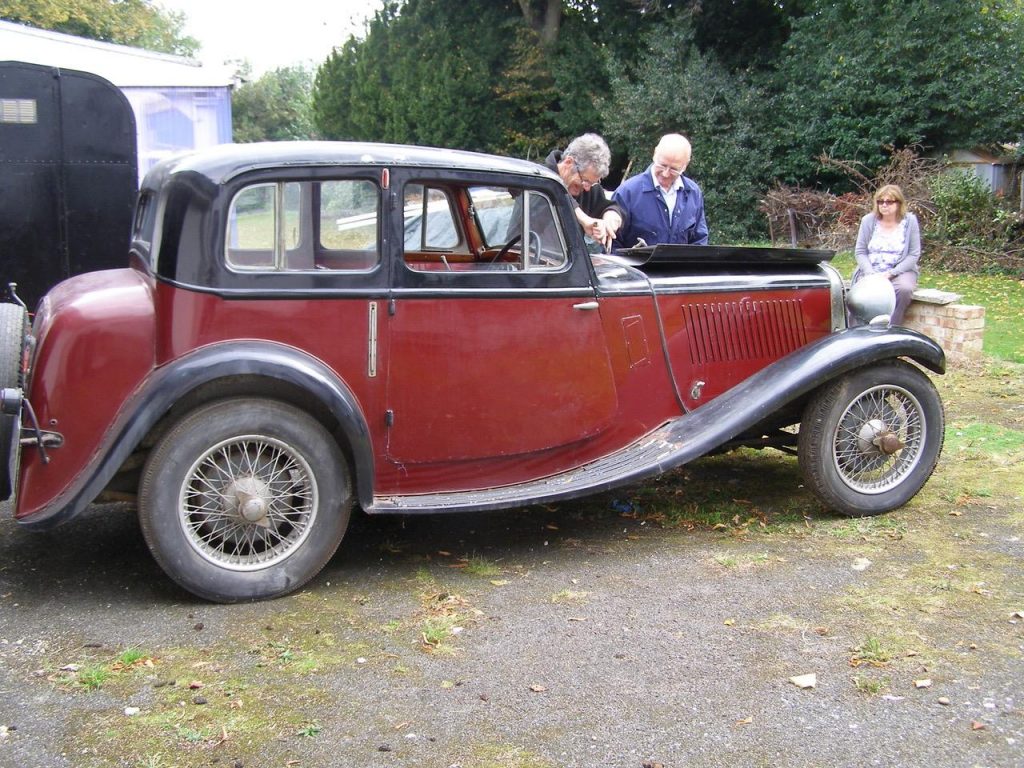
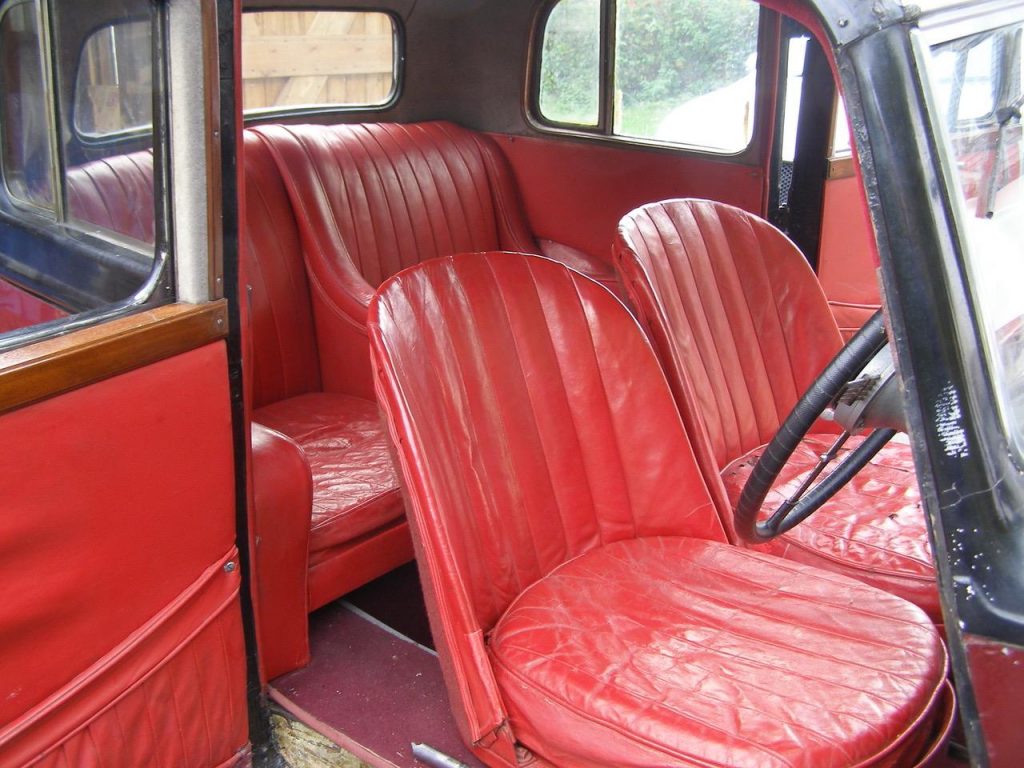
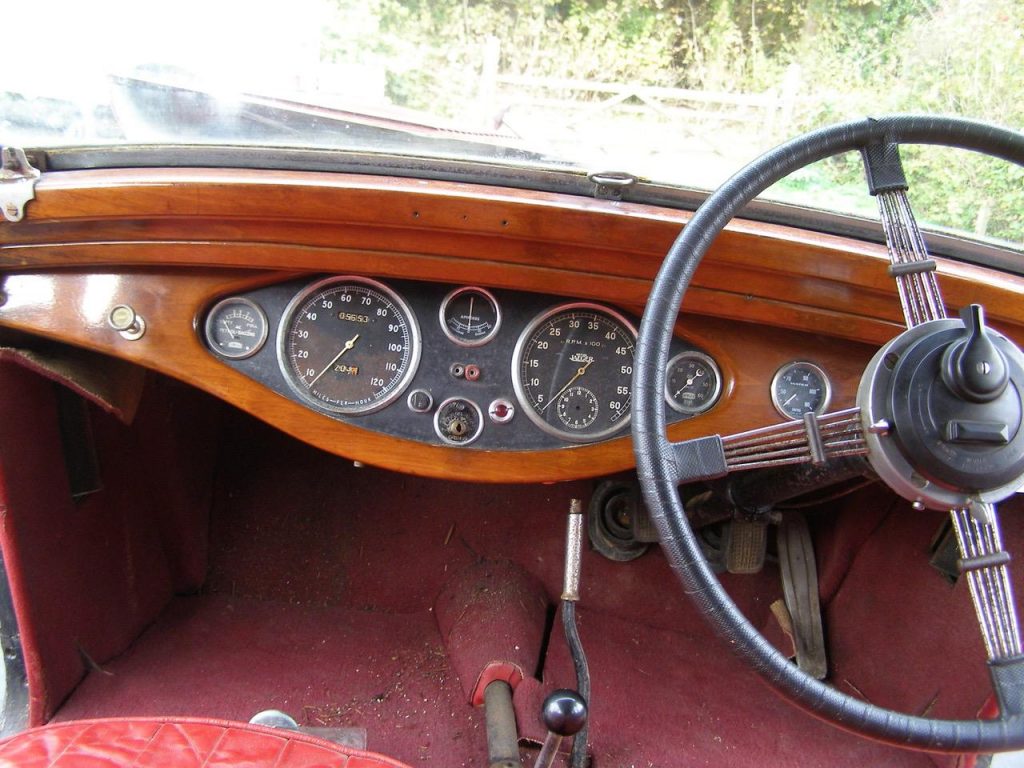
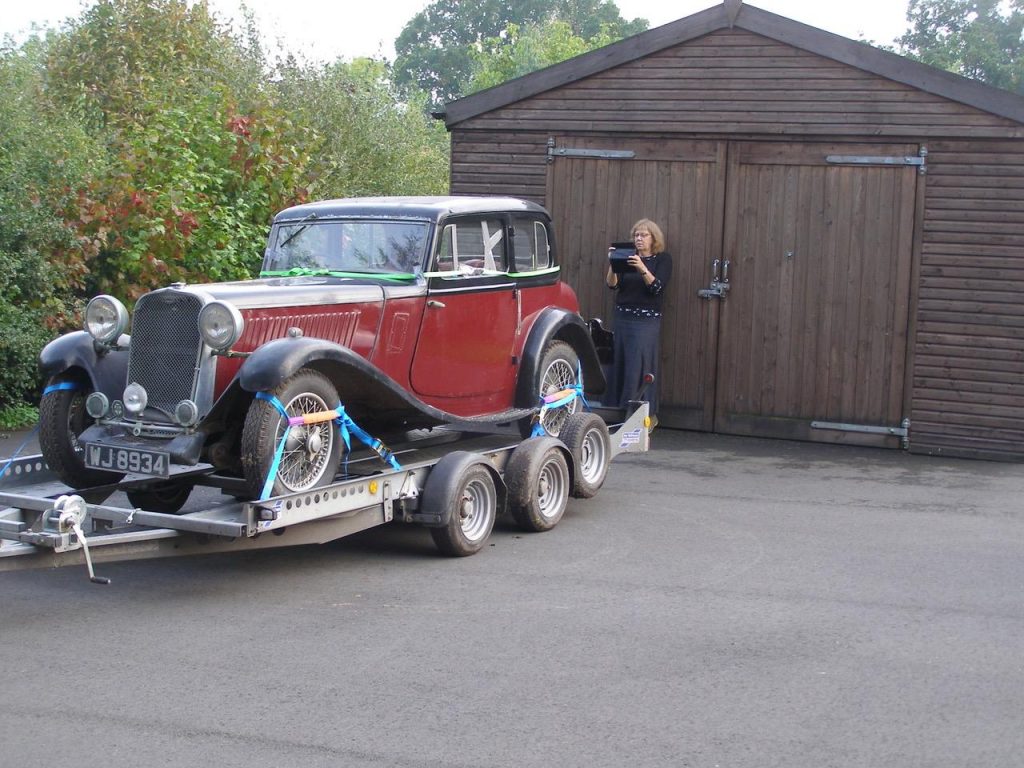
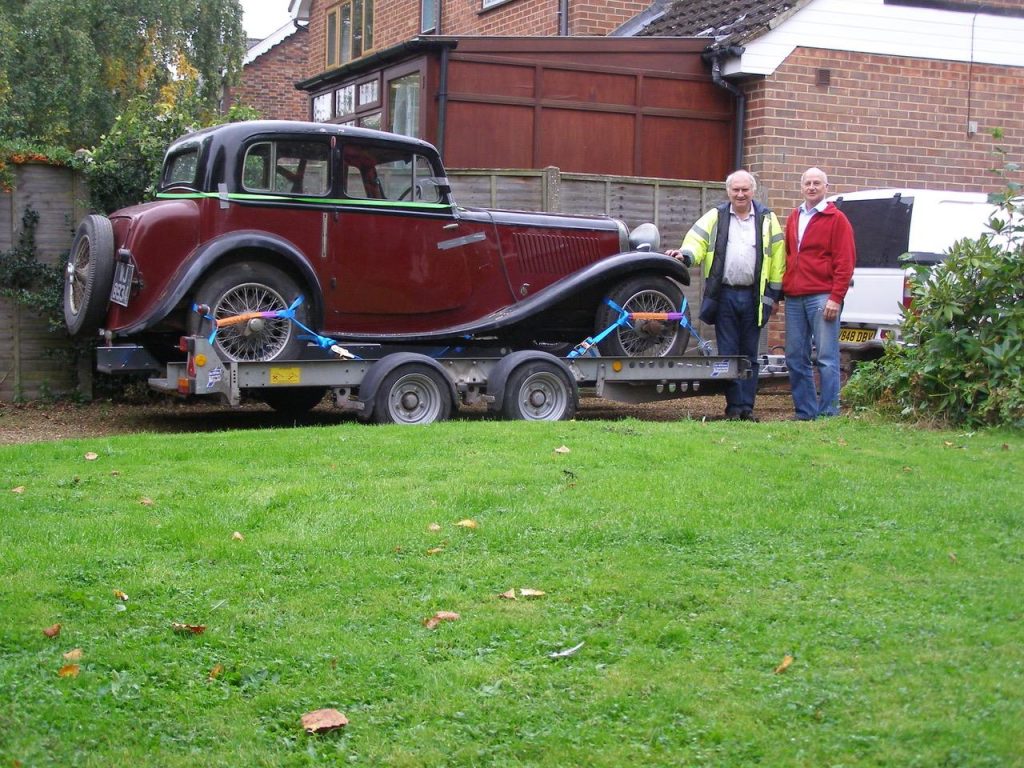
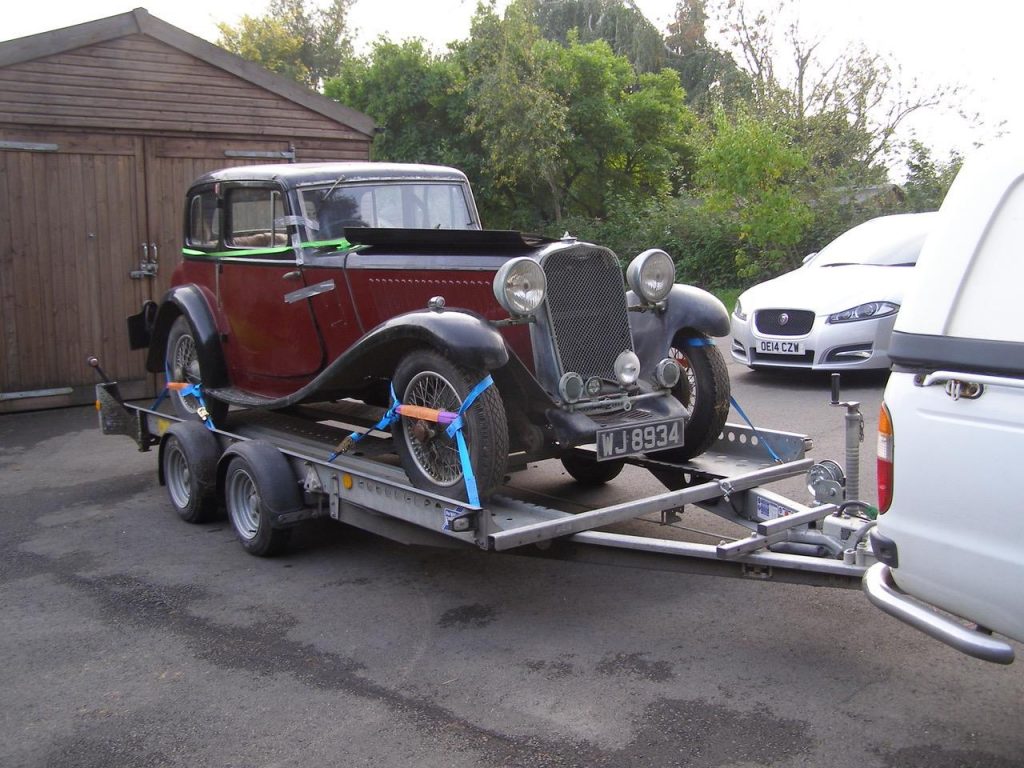

4AB Roadster
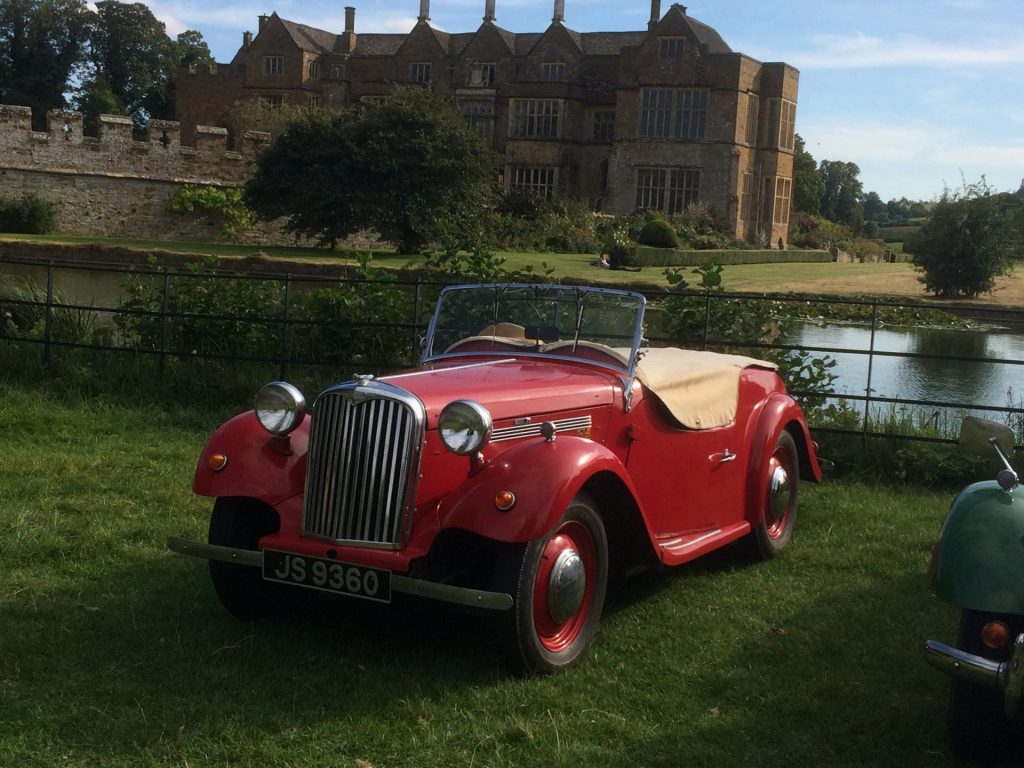
This is John Hadfield’s 1951 4AB Roadster JS 9360 which he purchased in Norfolk in 2012 having owned a 4A Roadster in the late 70s/early 80s. The apparently early 1930s registration number on a 1951 car caused puzzlement at first – surely licensing authorities had all switched to the AAA999 format by 1936 at latest? However, all was soon revealed – John’s Roadster was first registered in remote and sparsely populated Ross and Cromarty north of Inverness where cars (let alone Singer Roadsters) were clearly pretty thin on the ground in those days as the local authority did not exhaust their initial early 30s 2-alpha ‘JS’ number range allocation until 1955! Since buying the car, John has replaced a non-original homemade dashboard with an original 4AB item which was sanded down to bare wood, given several applications of french polish and then a good coat of clear antique furniture polish which displays the wood grain to great effect. At the same time it was found that woodworm had been making a meal of the plywood board under the tool deck (mysterious sawdust in footwells!) so off with the tool deck and out with the crumbling plywood remains which fortunately were still able to provide a template for some fresh plywood board, which was thoroughly treated with preservative to prevent return of the little blighters. The hydraulic front brakes weren’t too brilliant on the first outing and a lower than expected fluid level seemed to indicate master or slave cylinder problems – but there was no sign of fluid leakage anywhere and a simple top up and brake bleed permanently restored things to normal much to general relief. Apart from a fuel starvation / blockage problem which was remedied by fuel pipe replacement, tank drain-down, fuel pump cleanout and fitment of an inline filter at tank end, the car has been reliable and given much pleasure.
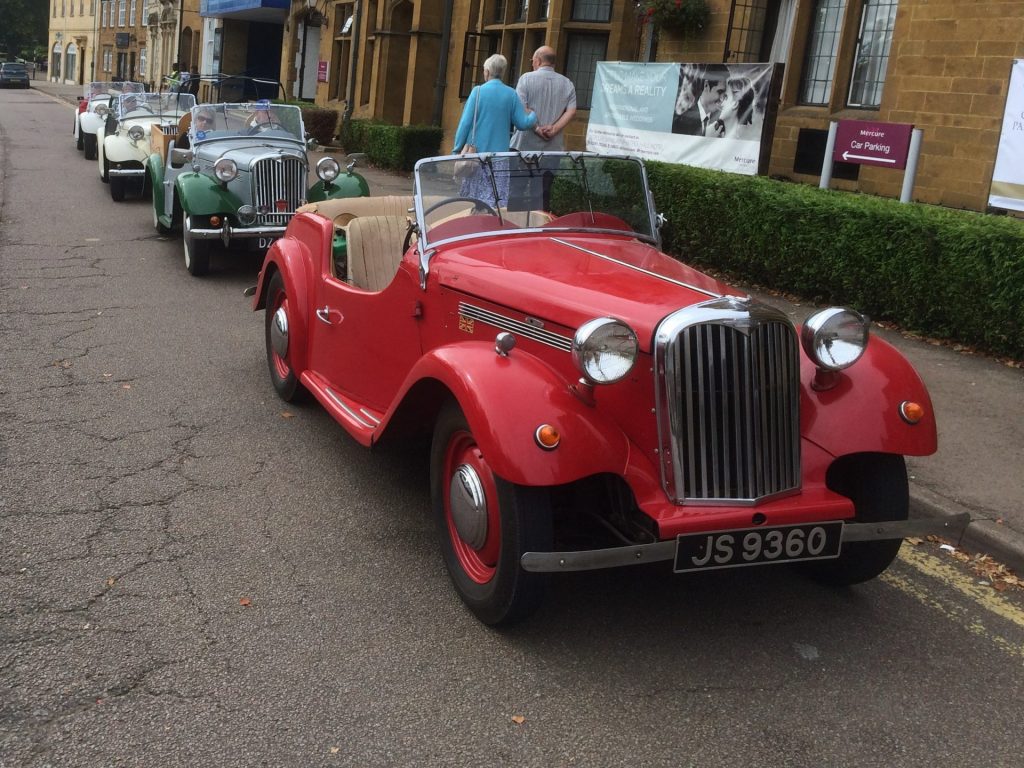
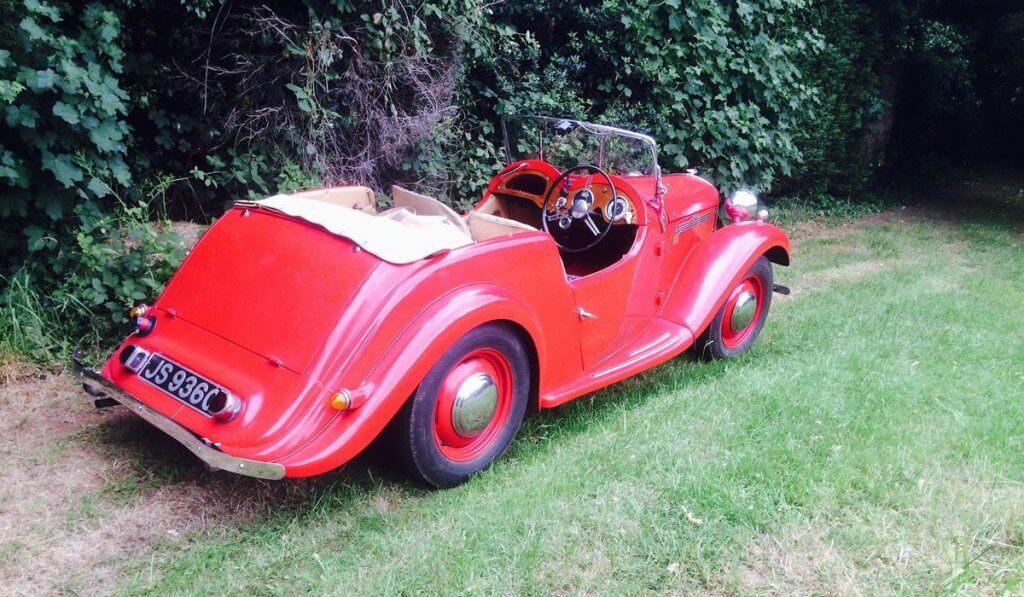
Junior Special Nine Saloon
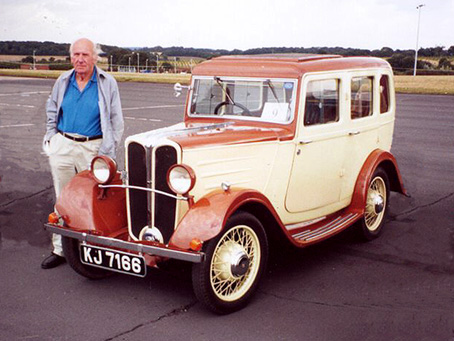
This photograph shows the late Tom Davies with his 1932 Junior Special Nine Saloon. With its “Waterfall” style radiator cowl it is sometimes mistaken for the larger Kaye Don Saloon, but that has a split front screen and low-slung headlamps. Tom acquired the car in 1965 and spent 5 years restoring it, including a full engine rebuild and repairing and repainting the bodywork. His most memorable journey was driving to Norwich for the Norwich-Felixstowe Rally in 1973. This delightful Singer is currently owned by a member of Tom’s family.
Junior Sports Special
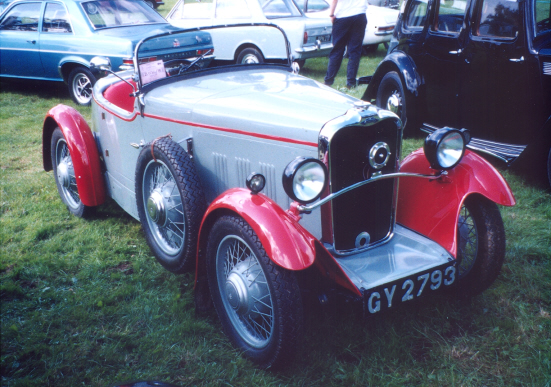
This is Mike Hyman’s 1932 Special Nine Sports Two-Seater, which he bought in a seriously depleted condition in 1993 as a retirement project. The car is called Hazel. Work was completed in1998, and in July 1999 Hazel won the concours d’élégance at the BEN Rally near Ascot. Mike has traced Hazel’s history back to 1965, when she was rescued from a chicken run on a farm in Burbage, Leicestershire, for £15 and then languished 20-odd years in Coventry because the new owner was unable to repair the badly cracked cylinder head and block. She was eventually ‘’found” outside a barn near Devizes (Wiltshire) with only the chassis and wheels, scuttle, boat-tail and one rear wing remaining. CLICKHERE for a picture of Hazel as found, and a view of her curvaceous rear and hood

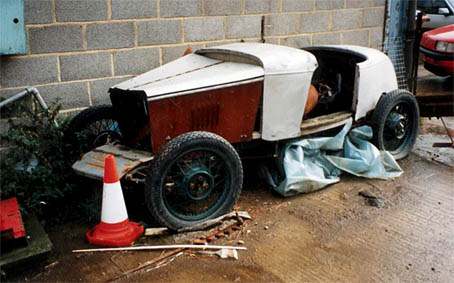
Junior Saloon
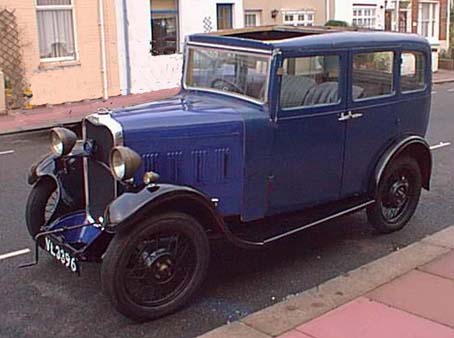
This 1932 Junior Saloon was formerly in the ownership of Steve Pegram. He bought it in January 2000 and returned it to the road for the first time since it was crashed in thick fog 35 years ago by Mr R Ashley from Lincoln.
Steve carried out a virtual ground-up restoration, involving overhauling the engine, renewing the crown wheel and pinion, replacing 70% of the woodwork incl. new bed plates, door pillars and floor, making a new fuel tank and wiring loom, grit-blasting the wings and running boards and giving them 12 coats of paint. It took Steve just 11 months to get the car fit for its MOT test.
Steve said 20% of the car was missing and he either made items, found them at autojumbles or through ASCO (now SMC)
Junior Saloon
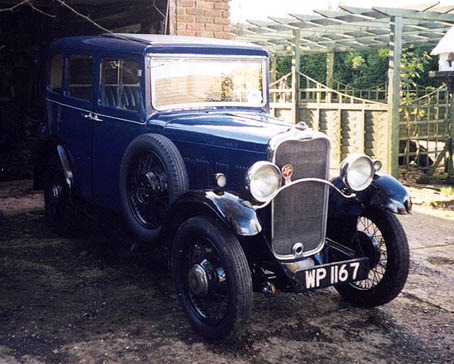
This is Jenny Croutear’s dark blue 1932 Junior Saloon, which she inherited from her late father Harry Little. Harry first saw the car standing in an orchard bought by the building firm he was working for. The owner, who had bought the car new in Bromsgrove in December 1931, told him to take it away if he was interested in it. So, Harry gave it a general clean up, freed off the clutch and brakes, put some petrol in and ran it for 12 months. The car then lay in the garage for nearly 30 years. After cleaning out the rubbish from the garage one day, Harry ‘found’ the car again and decided to restore it. After several years work it passed the MOT test-first time-on October 19th, 2000. First outing was to a local show in November, when they had a great time. Although the original owner died about 6 years ago, his wife is still alive and is looking forward to seeing the car again as she had gone with her husband when he bought it 70 years ago. There can’t be many 70-year-old cars with only two owners
Junior 8hp Saloon
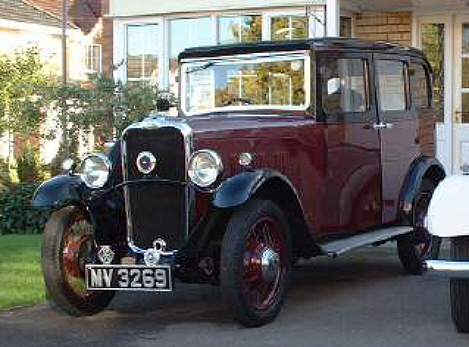
This 1932 Junior 8hp Saloon was formerly under the custodianship of Allan Jones who acquired the car in 1985. It was languishing in a council lockup, partly, but badly restored; so much needed to be done. Allan was lucky enough to make contact with another Junior owner, Ken Mellor, who lived just a few miles away, and Ken helped enormously with the engineering side of the restoration. Allan painted the car in his driveway, re-trimmed the interior and had all the chrome re-plated He was also helped by corresponding with a previous owner, John
Budge, who had himself restored the car as much as post war austerity would allow. John had used the car as his main transport through to the mid’ 60s and had done nearly100,000miles in it. Allan took the car to rallies and shows for many years and earned him “First in Class” and “Highly Commended” at local shows in the summer of 1993. However he was fairly restricted on distance in view of limited speed and power of the Junior. As you can see, the restoration has also withstood the test of time and still looks immaculate. Allan’s car featured on the front cover of the August1993 ’The Automobile’ magazine and was the subject of a five-page article
Light Six Saloon
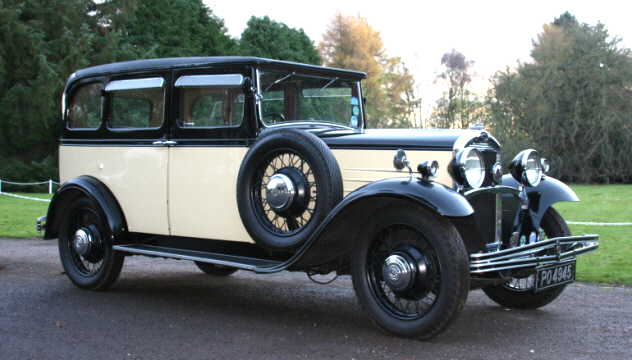
This is David Davies’ beautiful and very rare 1931 Light Six Saloon. As far as we know this is one of two surviving examples of this model – even this one didn’t appear in the Millennium Project listing.
Originally called the Senior Six, it has a 1752cc side-valve engine, which was rated at 15.7hp. With a four main-bearing crankshaft fitted with a vibration damper, the car is very smooth to drive. It is also very well appointed, with real leather upholstery and a patent flush-fitting sliding roof.
Singer Ten Saloon
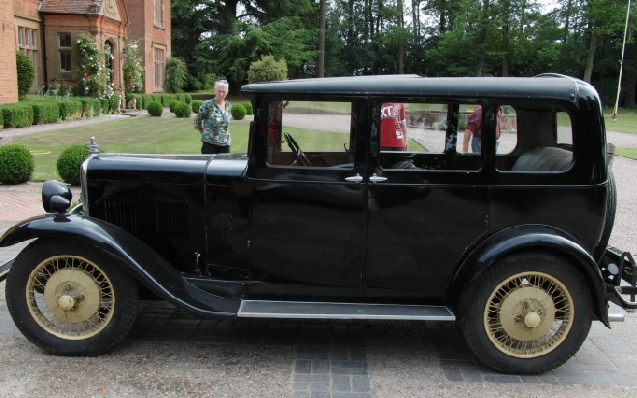
This is Sue Anfilogoff’s 1931 Singer Ten Saloon, which is the only remaining example of this model known to have survived.
It was bought at an auction in 1988, and has been garaged, but not used, for the past 21 years. However, it has recently been serviced and MOT’d by Keith Parkes in Kenilworth who drove it the 20 miles back to Solihull, where the car lives, with no problems.
Junior Saloon
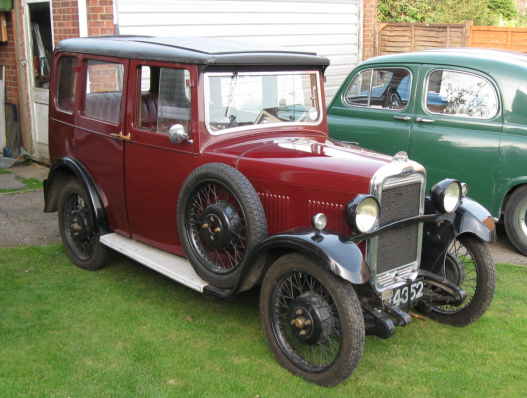
This is Kjartan Meyer’s 1931 Junior Saloon GN4532, who is called Gordon, and who now lives in Norway, He previously belonged to Mike Hyman, who had bought Gordon in 1999 in case he was needed for his grand-daughter’s wedding. He was!
Gordon had one (careful?) lady owner from 1935 to 1976, when he was fully restored, and his new owner used him as his everyday car. All Mike had to do to get him running was repair the vacuum pipe to the Autovac.
Having bought Gordon, Kjartan’s first journey was to drive him home to Bergen, in Norway. CLICK HERE for pictures of Gordon at the wedding and on his first major excursion in Norway, which was to a Treasure Hunt and Driving Test rally in Stavanger.
Junior
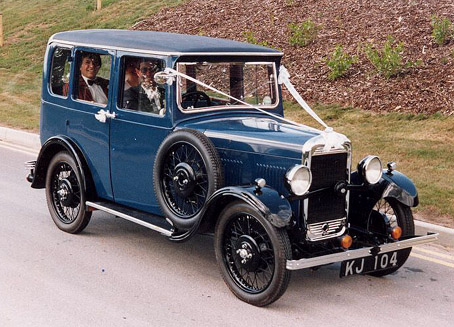
This is Lynda Penson’s 1931 Junior, which she inherited from her late father Ian Rowthorne. Ian discovered this charming little car in 1979 in a corrugated iron shed where it had been laid upon bricks for the previous 28years. It was in a very advanced stage of deterioration and Ian spent the next 10 years stripping it to its last nut and bolt for a complete restoration.
This picture is of the car on its first outing after restoration for Ian’s daughter’s wedding in September1990.
The car had been initially purchased from Anstey’s Garage in Maidstone for £150 in April 1931, but nothing more is known of its history until 1948.
Junior Saloon
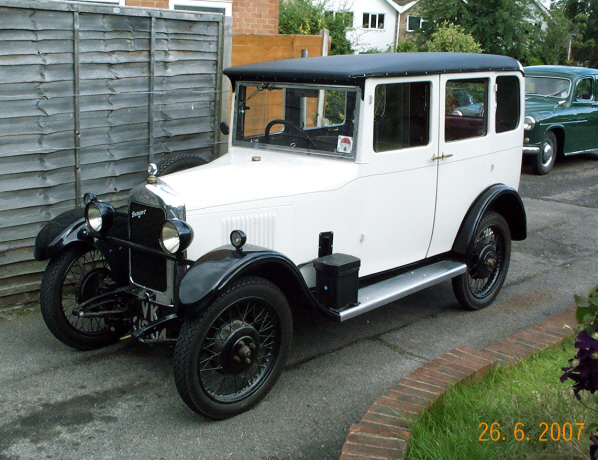
This is Mike Hyman’s 1930 Junior Saloon VK3304, called Victor, pictured on the day Mike completed his total restoration, which had been on going over the past eight years. Apart from the chrome-work, Mike has done all the work himself, including the re-spraying, trim and upholstery, headlining and vinyl roof. CLICKHERE for pictures of Victor in November 1998 as he was rolled out of David Godley’s lock-up garage near Wolverhampton, where he had been awaiting restoration for over 15 years, plus many years before that, when David took him as part payment for services rendered. Then follow Victor’s progress through his restoration process
Junior Saloon
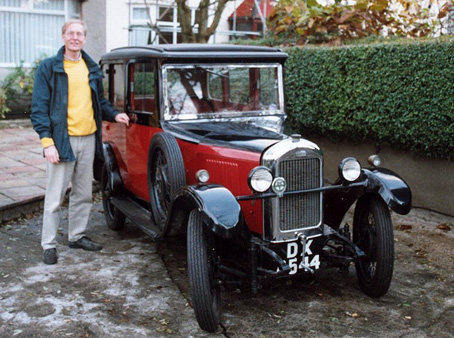
Meet “Dixie”- Alan Hillier’s 1930 Junior Saloon. Dixie is Alan’s first vintage car.
He has previously owned several microcars-1950s/60s Bonds, Isettas, a Trojan 200 and a Frisky Family Three.
The car was sold new for £160 by Egertons (Ipswich)Ltd, whose enamel badge is still on the dash. In 1972 she was bought by Sagar Richards Ltd, who made the die cast aluminium-bronze gearbox selector forks for Juniors from 1927, to celebrate their Golden Jubilee Year (1969). This was the vehicle in which the very first of their products was used-they have since been a major supplier of such forks to the Motor Industry. They restored the car and kept it in their private museum in Halifax, Yorkshire until 1987, when they sold it to Judith Sluggit, who took it to Belgium and France, where it spent the next 10 years as “Our Little Treasure, 1’as Judith and her husband Pierre called it. Alan bought Dixie in November 2000 and has already clocked up several hundreds of miles driving to Rallies and events, including ASCO’s 25th Anniversary SNCR in Burford and the SOC 50th Anniversary celebrations in Northampton.
CLICKHERE to see another picture of this lovely car.
Junior Tourer
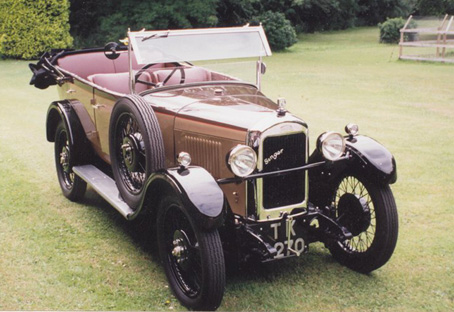
Jeff Benson’s 1930 Junior Tourer
This little car has been in the Benson family since it was new. Jeff’s great uncle bought it new when he was Mayor of Bridport in Dorset, His wife, who was a District Nurse, used it for travelling in and around the villages in her daily work, Jeffs father bought the car some 38 years ago and both his sisters used it on their wedding days. The family used the car a lot during the summer travelling to their cottage in Dorset for the holidays, having to stop often at pubs to let the engine cool down{saysJeff!) When they moved to Bristol the car was left in a barn where it stood for 23 years and was home to the chickens who laid their eggs in the hood and on the seats. CLICKHERE for pictures taken in the barn. After collecting the eggs one day in 1998, Jeff decided it was a shame the car was in such disrepair and he dragged it out to see exactly what was needed to restore her. To his astonishment, after just cleaning the plus and points, a drop of oil, water and some petrol, she started first time, albeit with a blue haze training behind! This gave him hope and he took on the job, restoring the car to its present superb condition. The engine, however, needed no further attention and still has not been touched since new. The car still has only 21,000 miles on the clock, CLICKHERE for more pictures of the restored car. Jeff also has a 1930 Junior Saloon and a 1960 Gazelle 3A.
Junior Saloon
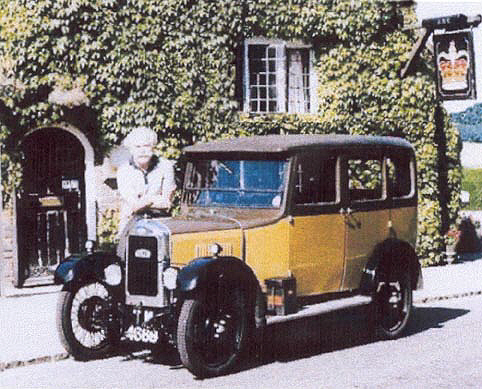
This is Neil McDonagh’s 1929 Junior Saloon, which he is currently restoring. Also in the picture is Neil’s late father.
Junior
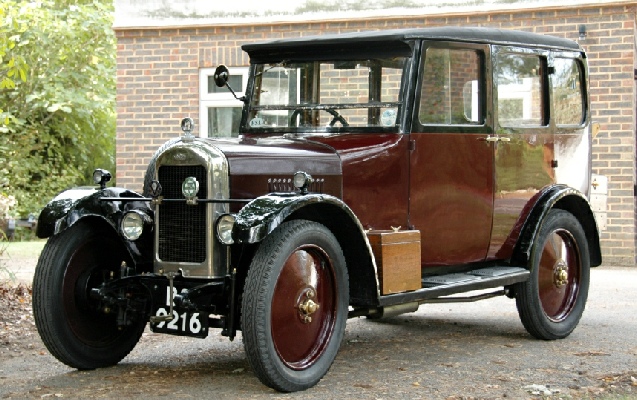
This is David Garn’s 1929 Junior. David tells us:
It was September 2004 when I saw the Singer Junior for sale on eBay. It was stored in Hartlepool, over 250 miles from home, so not convenient to go and take a look. I had thought for some time I would like an earlier car than the Bantam and this one looked very smart. I put in my maximum bid and when the auction was over I was quite disappointed to find I was the under-bidder.
About ten days later, I heard from the seller that when the new owner arrived to collect his car the engine would not start, and it turned out that the Magneto had failed. As a result the deal was cancelled. I was asked if I still wanted the car for the amount of my highest bid, less £300 to get the Magneto rebuilt. I accepted and a few days later collected my new acquisition on a trailer. I was a little disappointed that the owner had just transferred the original registration and was offering it for sale separately, but I was delighted with the car.
Within a week, I had taken the magneto to a specialist, who stripped it down whilst I was there and showed me where the coil had shorted out. When I went again a few days later, he showed me the magnificent spark from the test rig and I went home to install the rebuilt part.
It took me a while to get the timing right, but soon the engine was firing on all four cylinders. I was finally able to take the car for a run and work out the challenges of the centre pedal accelerator and right pedal brake.
I did promise my wife that this was just a bit of fun for a season, and that I would sell the car again the following year. I have now owned it for over ten years and have had tremendous fun in driving all sorts of people to a variety of different places. The Junior has attended four different weddings in that time, including my son and my daughter’s events. On one occasion the bride turned up in a 1930s Rolls Royce, whilst my Junior carried the bridegroom and best man. Parked together, the Junior attracted more attention than the Rolls and even the chauffeur asked to photograph my Junior next to his car!
One day, I will have to pass it on to a new owner, but for now I love my Singer Junior (but don’t tell the Bantam).
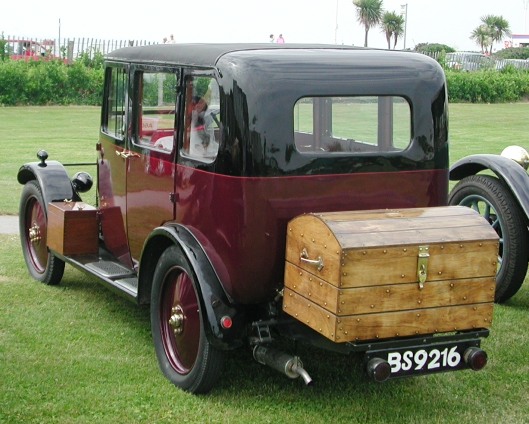
Junior Tourer

This is Roger Goldsmith’s lovely 1929 Junior Tourer, which lives on the Island of Guernsey. Roger and his wife are both retired teachers – she an infant teacher and he a teacher for deaf children, and they used to spend their leisure time on boats, as this was the way they got away from it all, hopping over to France or the UK.
As age set in and knees began to wear, they decided a different hobby was called for. So they sold the boat and sought a reasonable car to enjoy.
They looked around and found the Junior advertised in Car and Classic. It looked good in the photographs and, says David, it had so much more personality than an Austin 7.
A trip to UK was all that was needed to decide this was the car for them. It had been in someone’s collection for about 10 years, and records showed it had done only 1.5 miles per year between each MOT! They had it delivered to Southampton and ferried over to Guernsey in a container.
Junior Porlock

This is Peter Stephenson’s beautifully restored 1929 Junior Porlock. Peter tells us the car came with virtually no bodywork, so following a complete mechanical restoration, in which the engine was rebuilt and fully balanced courtesy of Ian Blackburn, I had to set about rebuilding the bodywork from scratch. At the time the company I was working for was building part of the M25 motorway, (the section around Potters Bar). I had to visit the site regularly and knew of a Porlock in nearby Kent. The car seemed original apart from the rear wings, which were unusually flared at the back to follow the shape of the boat tail. I have never seen this car since, and no longer have the contact details of the owner, who was happy to help in my quest for information. Each time I visited the site my evenings were spent measuring and copying shapes and curves until I had the information I needed to make a start.
I remember it took me four weeks to complete the ash framework, although the aluminium panelling took me significantly longer, as this was a skill that thus far had remained largely untested. The company I worked for had a large mechanical workshop and I was fortunate to be given unlimited access to a variety of machinery, such that rolling the bonnet tops and cutting louvres in the bonnet sides became a much less daunting prospect.
The finished bodywork was painted in the distinctive green and grey which was the only colour scheme available when the car was introduced in 1929. Unfortunately road use in its early years was marred by constant failure of the rebuilt magneto which failed year after year. The magneto was eventually converted to run as a distributor with a coil, which sorted the reliability problem, although she still struggles when the electrics get damp. Nevertheless, the car is fun to drive and is quite nippy for such an early vehicle.
These pictures were taken at Athelhampton House on the recent trip to Dorset for our George Singer Day and 2013 Singer Car National Weekend. The Porlock is the Sports model of the Singer Junior range, and gets its name from the epic feat on 4 December 1928, when, under RAC scrutiny, a Junior Sports made 100 consecutive ascents of the notorious Porlock Hill in Somerset. The model was thereafter called the Porlock.
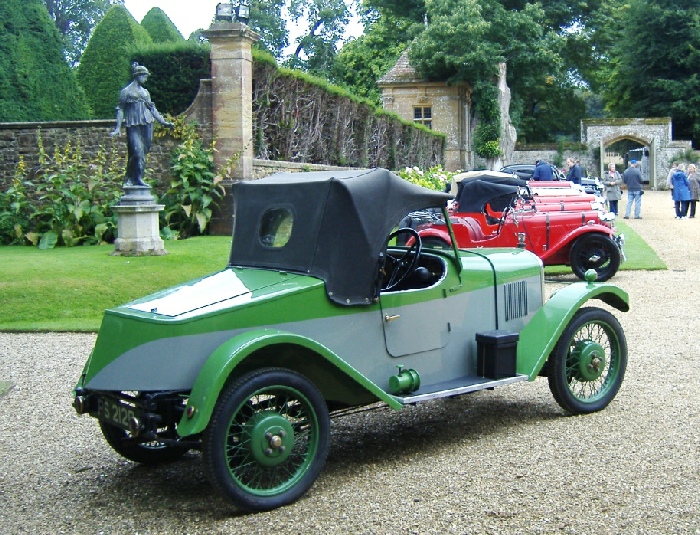
Senior As-U-Dryv Sun Saloon
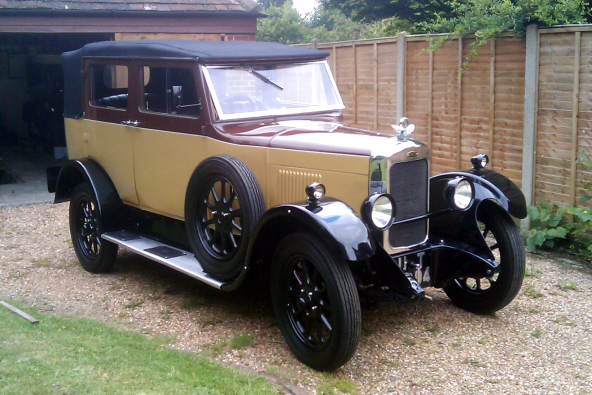
This is Simon Bishop’s beautifully restored 1929 Senior As-U-Dryv Sun Saloon. The hood retracting mechanism is operated using a handle by the driver’s seat
Junior
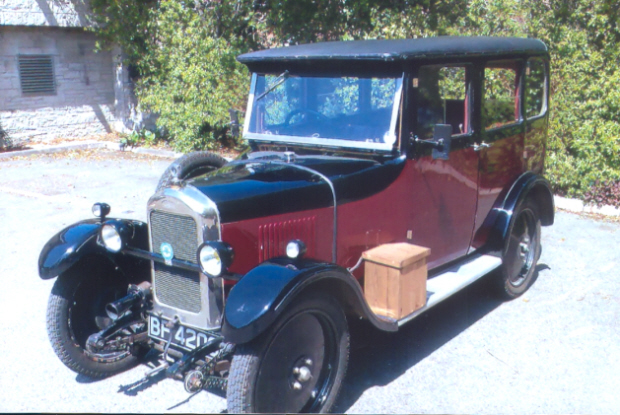
This is Tim York’s 1928 Junior, which he purchased having seen it or display on the Singer Stand at the Footman James Classic Show at Shepton Mallet in May 2009.
The car was fully restored in 1975, when it was fitted with a 1931 engine and gearbox, which being 4-speed, makes the car more enjoyable to drive than with the original 3-speed box.
Tim took the car on the 2010 Dutch SOCs 7th Lustrum Rally, driving all the way from Somerset to Arnhem, which, including the various sight-seeing drives around Arnhem, made around trip of well over 600 miles with no problems at all-A fantastic achievement.
Tim took a plentiful supply of spare oil and water but didn’t need any of it-n fact he was giving it out to various Le Mans owners who were running short!
Junior Tourer
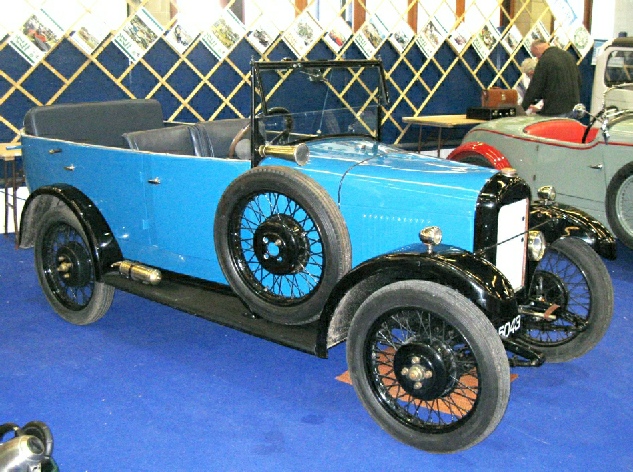
This is Nick Stone’s nicely restored 1928 Junior Tourer, seen here on display on the Singer Stand at the 34th Footman James Bristol Classic Car Show in Shepton Mallet.
Nick acquired the car in May 2011 in a partially restored state, and daughters Phoebe and Martha took to it before it was even off the trailer! Martha commented that it would be great to have the car ready for her school prom in March 2012, and as Nick said, it’s always good to have a deadline.
As you can see, after much reassembly, trimming and general fettling, Nick just about made it, although it’s a good job it wasn’t raining, as the hood was still not ready to be fitted. And much to Nick’s regret, it was still not ready in time for Shepton Mallet, but if it looks as good as the rest of the car when it is fitted, the wait will have been worth-while.
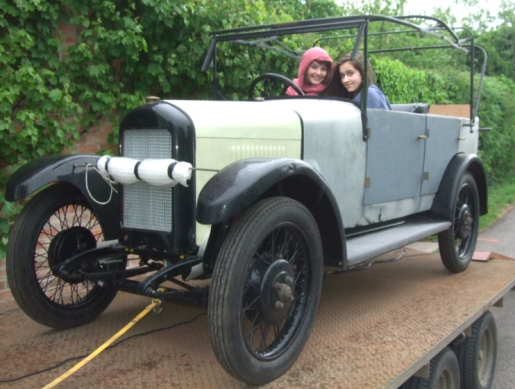
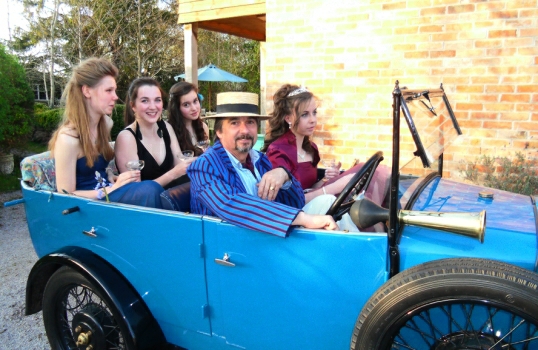
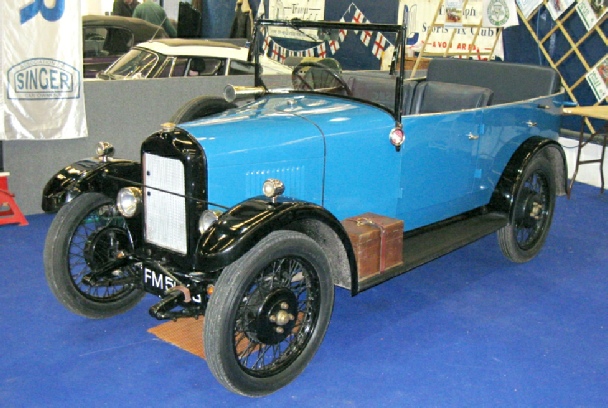
Junior Tourer
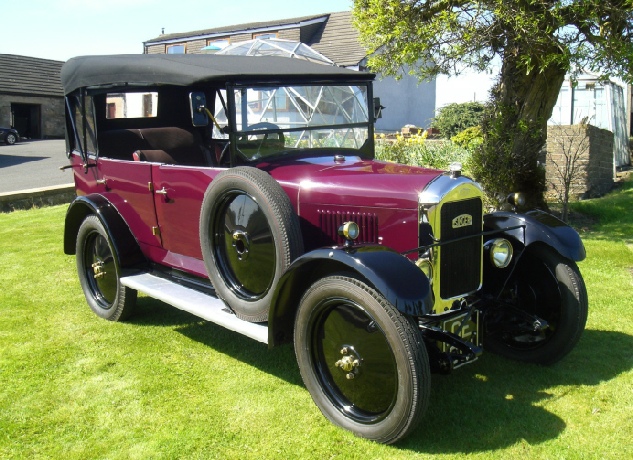
This is Ben Weston from Glasgow’s superbly restored 1928 Junior Tourer, which he acquired in March 2009. GE 601 had been off the road for about 58 years, having last been registered in Stirling in 1953 and kept under wraps in Ellie Kenny’s uncle’s garage since he bought it in about 1982 as a restoration project. GE 601 had been standing in Elly Kenny’s Aunty Joyce’s garage awaiting restoration for about 28 years, and when her husband died it was decided to sell the car. Ben told us: “I was fortunate to be in the right place at the right time and it was I who bought her. The restoration project was completed in just under two years with the help of our little group, comprising my brother and a couple of friends, who assisted with the dismantling, mechanical work and preparation of the body-work for priming.
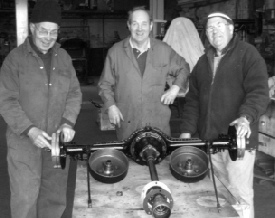
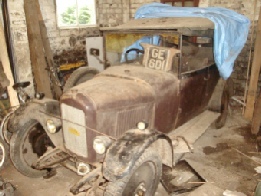
As I was rubbing down in preparation for painting, a friend called in and asked what I was going to paint it with. When I mentioned my trusty DeVilbis, he offered to bring his latest high-tech gun, which produces virtually no overspray, and to put the paint on for me – an offer I could hardly refuse! I therefore built a spray-booth in my barn, using large plastic sheets, and fitted up lighting on tripods. To say that I am delighted with the outcome is the understatement of the year! For the interior trim I used the modern equivalent of the Rexine type material originally used by Singer, and for the seat upholstery I employed the services of a local firm, Colin James.
The hood was made by a friend who lives just down the road, and the overall result is every bit as good as I had hoped it would be.
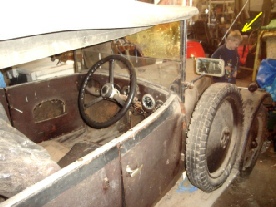
So it was in April that I contacted Elly to let her know the job was done, and she arranged a ‘mystery trip’ to bring Aunty Joyce and her son – the little fellow at the front of the car (arrowed, in the picture, left), and now the strapping lad in the centre of the group below – together with her husband and daughter, to see the car. I’ll swear there was a wee tear in Aunty Joyce’s eye when she saw their old car parked on our lawn!” Ben.
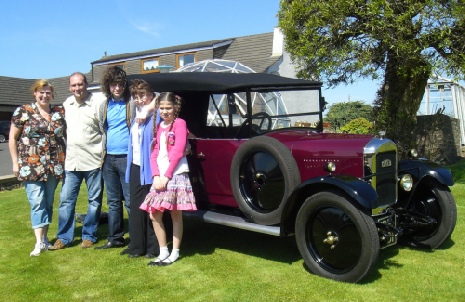
Junior Tourer
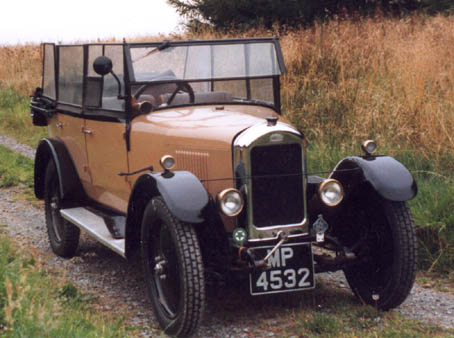
This is Alan Dignan’s 1928 Junior Tourer. Details to follow.
Junior Tourer
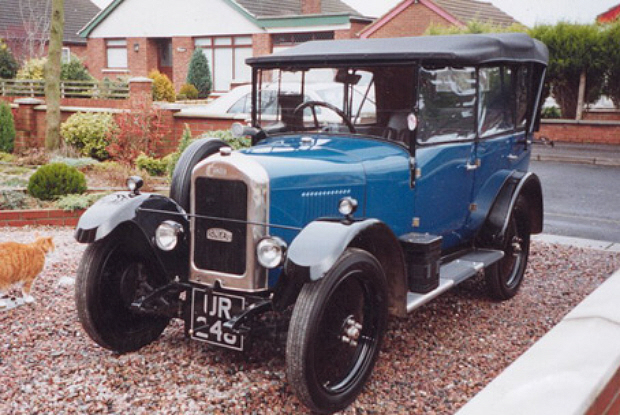
This is L Wilson’s immaculate 1928 Junior Tourer
Super 12
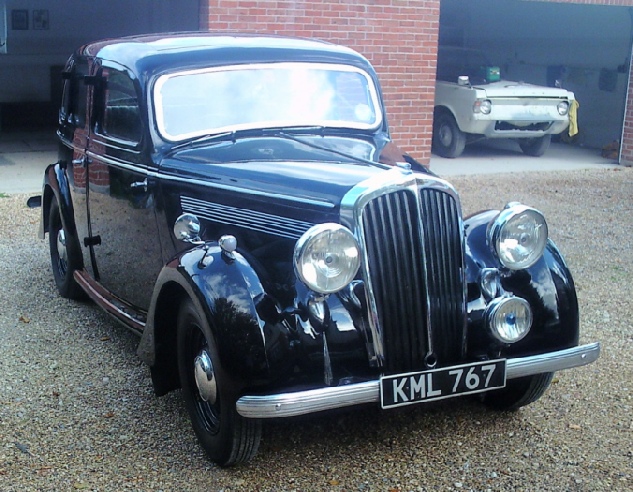
This tastefully restored 1939 Super 12 formerly belonged to Norman McKinnell.
Norman tells us:
“I have always been a car nut, and as a result have a number of ‘collectables’ acquired over the years – mostly Mercedes. Recently my passion has changed to 60s and 70s cars – must be the ‘mod’ in me.
I never realised Singer actually made cars in the 1930s until I went to an auction to purchase a Mercedes Pontin for restoration. However, the vehicle sold for an inflated price and I was left empty handed.
The next auction lot was a 1939 Singer Super 12 that had 3 recorded owners and bills showing expenditure of £5,600 in 1964. I immediately decided she was the one for me, despite no MOT, looking a bit down in the dumps and in need of some TLC. Two minutes later, I was the proud owner and couldn’t wait to get her home and tucked up in a warm garage.
With the help of a very nice Russian man at the local garage, she was steam cleaned underneath, the chassis and running gear painted with Hammerite, and the engine in some specialist engine paint.
The engine oil was white and milky, but after the engine had been flushed numerous times with the external filter removed (whatever good it is I’m not sure), my fear of water troubles were eventually unfounded. Everything that had a grease nipple was greased and everything else that should move was given numerous doses of 3 in 1 oil until eventually things appeared to be functioning again. Steering and brakes were checked, carburettor, plugs and points cleaned, and she then fired up and ran as beautifully as she was designed to do. I also decided to tidy up the wiring – I’m not sure why it still looks a mess, but at least I feel I’ve had a go!
So now it was MOT time and off I went with trepidation. On route, the wipers packed up, but I pressed on, and on arrival announced her shortcomings to the MOT man, who promptly allayed my worries by stating: “If you have driven it 5 mile , it pulls up in a straight line and the lights work you should be ok”.
“Excuse me,“ I replied in a sheepishly, “What about the wipers?” “ Windscreen opens, so you don’t need the wipers.” A wave of relief came over me – I could never close the windscreen completely anyway – more 3 in 1 I guess. She passed, I was so proud of her. A small gathering had appeared, and although they were not supposed to look at her under-belly when on the ramp, the tester permitted them – what a nice man – and what lovely curious people, who all made complimentary remarks about the condition of her underside.
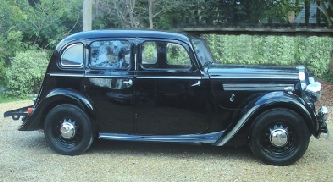
I drove away from the garage feeling 10ft tall, and all her quirky ailments such as clutch judder, a driver’s door that seemed it had come from Colditz and needed an enormous bang to open, the draught from the road as the gear box cover was missing, no power steering, an open windscreen, two front seats that had more horse hair stuck out either side of them than my other great love Red Rum, and a gearbox that occasionally needed a double declutch to negotiate a roundabout, to name just a few, were all forgotten.
The next stage was to tackle the doors. These were hanging at all angles and when closed the bottom third protruded outwards like wings. In addition, rust was clearly evident along the bottoms and creeping at an alarming rate, consuming large areas of the door. It was time for a visit to my favourite body shop, where John advised a course of action, including renewal of some timber elements.
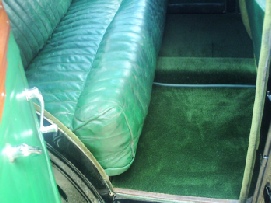
When I went to collect her it was like the King and his new clothes, what a pleasure to see. This spurred me on to tackle the interior. I decided to try and salvage the seating, after all, they had been made by craftsmen over 70 years ago and I felt it was important to recognise this. Stitching that had come apart was re-stitched, horse hair replaced, springs repaired and then all treated with leather food – the patina is lovely. New, matching carpet was fitted by the ‘seat’ man, who bound all the edges and did a great job.
I’ve now owned the car three years, and although she seems almost finished there will always be something that needs doing. The winter will hopefully allow me to tackle jobs such as painting inside the boot, fixing the hamper I commissioned, and attending to the roof lining and the sun visors. The limited paperwork that came with her, including the Shellubrication plastic wallet, shows that in 1964 at 5,992 miles a full service was carried out. The final service sheet in 1971, by which time she had recorded 13,790 miles, bears a technicians note ‘Next service 14,700 miles.’ The mileage now is 15,985 – I bet she could tell a story or two!
So here’s to the next 72 years – bottoms up and drink to a lovely old girl.”
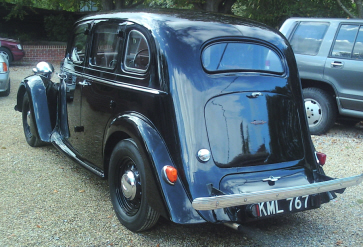
Roadster
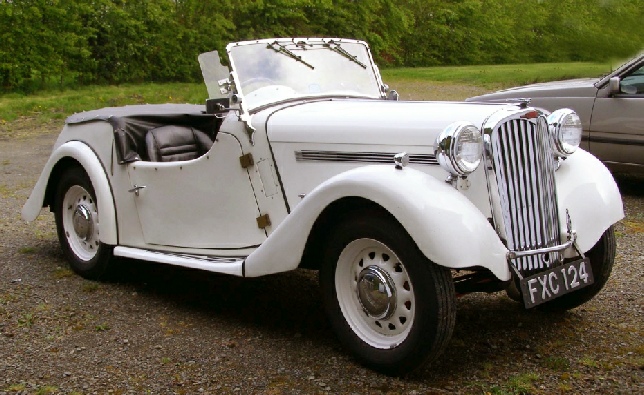
This is Peter Watts’ 1939 Roadster, which he has owned since 1971. He fully restored to its present immaculate condition 40 years ago with the exception of the running boards. This was because the bodywork under the doors and rear of the front wing had rotted away and when he eventually managed to find replacement wings and running boards they were not exactly the right ones for the car and he was unable to line them up. He promised one day he would sort it all out, and now, true to his word, two brand new, made to measure running boards have been fitted.
But as you can see in this picture on the banking at Brooklands, he had trimmed the brackets and painted them to match the car, and it looked fine.
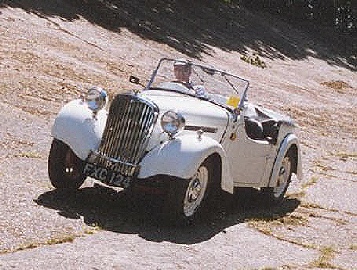
The picture below was taken at the 2012 Footman James Classic Car Show at Shepton Mallet – its first outing with them fitted.
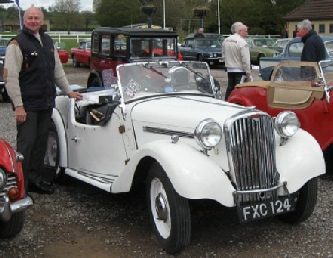
When they are not swanning around in the Roadster, Peter and Sara play music in a ceilidh band. Whilst this has nothing to do with Singer Cars, you can check on what they get up to by visiting their website – www.muchadoband.com.
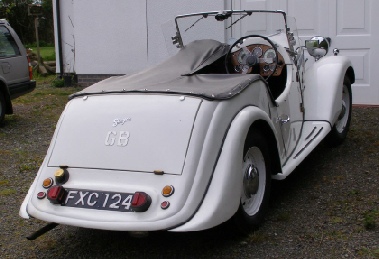
Roadster
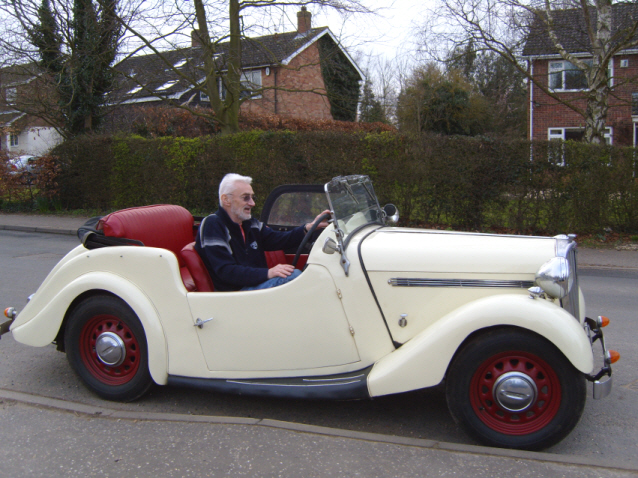
This is Ray Mann’s 1939 Roadster. Ray bought the car in January 2007, and says it seems to be in very good condition – not concours, but very useable.
The car is fitted with bumper bars front and rear, which were standard equipment for export models. It also has the betyler quality, sliding glass side screens, which were an optional extra for the UK and may also have been supplied with the export models.
The car was exported to Ceylon when new, and was re-imported to the UK in 1982, and was then fully restored.
Singer 12hp

This is Nevil True’s 1938 Singer Twelve, which he rescued after it had failed to sell at auction. It all started with a query from Hollie Coates, a trainee with a firm of solicitors dealing with a deceased’s estate which included an old Singer car, asking if ASCO provided valuations of such cars. We requested further information, and soon Hollie sent the picture below (right) and told us the car registration was EOB 190, it had done 79,000 miles and was last taxed in 1968!!
A quick check on the DVLA database told us it was a 1525cc Singer manufactured in 1938, which would make it a Twelve or Super Twelve, and this was confirmed by a glance at the picture, on which you can see where the distinctive chrome cover for the horn had been on the rh front wing below the headlamp – you can see the horn is still there behind the aperture.
A few days later I received a query via the website, from Steve Hill, asking if we were interested in trying to save a pre-war Singer saloon he had come across in a garage of a house in Doncaster, where he lived. The house was all boarded up and looked semi-derelict, but was coming up for auction on 3rd December 2012 in Leeds. He thought only a builder would buy the house due to it’s condition, and that the car may well be scrapped. It was last taxed until July 1968! Steve had a photo of it (taken through a broken window) surrounded by junk. No number plate was visible, and although it had a Singer badge, the radiator grille didn’t look like a Singer, and he guessed it was 1937-1939. As a car enthusiast Steve was delighted the car has a hope of being saved in some form, and recalled his Dad’s first car was a 1947 Singer Super 10, and that he could still visualize their journeys to the East Coast with the luggage on the drop-down boot lid!
I replied to Steve with a copy of the photo, and that ‘his’ Singer sounded very much like the one we were investigating – a pre-war Singer saloon with a Singer Badge on a radiator grille that didn’t look like a Singer, last taxed in 1968 and surrounded by junk! It didn’t take long for Steve to confirm that we were both talking about the same car! Steve also sent me a picture of the house, which is a few hundred yards north of Doncaster racecourse, and is also in a sad state. According to a previous neighbour, the couple who lived there in the 1960s with their son, were ‘a bit odd’.
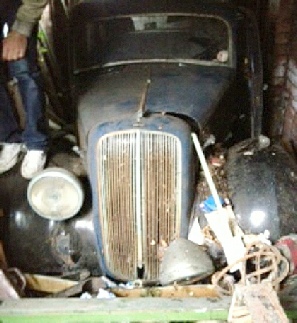
Another few days later, and another query via the website, this time from Dominic Jeffers, a freelance journalist who was preparing a story for Classic Car Weekly on a Singer barn find. His best guess, from the shape of the windscreen, was that it might be a Bantam or Super Nine, but the radiator grille looked like neither, and could he talk to someone in ASCO about the car? So I passed on to him all we had found out. I later learned from Dominic that our ‘Doncaster Singer’ had been removed from it’s rubbish-filled garage to David Mathewson’s Roxby Garage in Thornton-le-Dale’, for their Dec 2 Auction. I contacted David, who kindly sent me and the main picture and this one of the car out of it’s garage and on the recovery truck. David said the ‘rescue’ was a barrel of laughs, involving nosey neighbours, the CID, Traffic Police and a trip to A&E. (Presumably an anti-tetanus injection to protect his truck driver against lock-jaw from stepping on a rusty nail in the garage, adding that he’d had better afternoons!!
We then heard from Nevil that although the car did not attract a buyer at the auction on 2nd March, he had managed to rescue it, that the car is virtually complete and that he was planning to it get back on the road.
We wish him all the luck in the world!
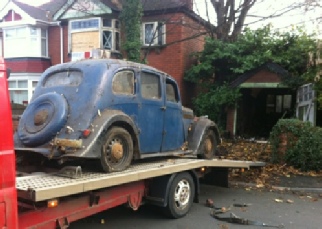

Le Mans Sports 4-seater
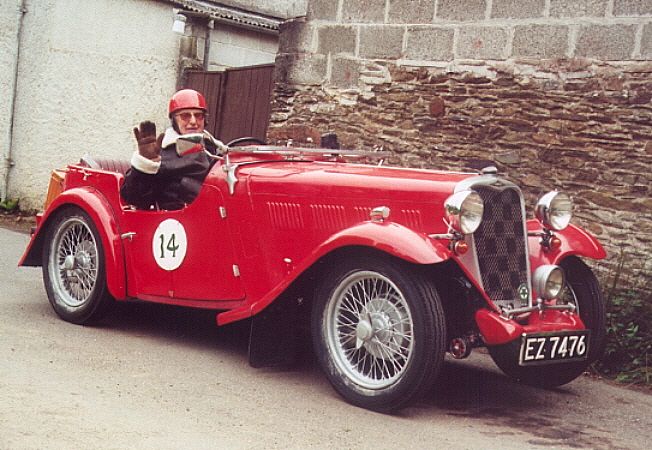
This 1937 Le Mans Sports 4-Seater formerly belonged to Terence Bickford who bought EZ 7476 in 1955 for £115, using funds saved from part-time teaching at Rutherford College of Technology on Saturday mornings, followed by selling ice-creams at Newcastle football ground in the afternoons! He used it to travel regularly from King’s College at Durham University down to the Royal Dockyard at Devonport during breaks in the college year in order to complete his Dockyard apprenticeship.
The main problem he had was that No 2 exhaust valve was prone to sticking open, so he carried a tin of Red-Ex behind the back seat. In case that didn’t work he had a hand vice he had puchased as an apprentice, which he is still using, and having lifted the valve cover and tappets, a strong grip on the vice and a quick pull and the valve was back on its seat. “It didn’t take very long” Terence says, “but you couldn’t do that on a modern car!”
55 years on and still going strong!
Le Mans 9hp
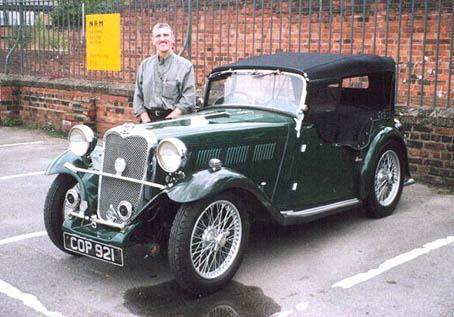
This is John Lamb with his 1937 9hp Le Mans, seen outside the National Railway Museum in York, starting point for ASCO’s National Rally in 2002, which John organised for us at the NRM and at Newby Hall, Ripon. John also organised the Club’s annual dinner at Russell’s Carvery in York.
This was the first long trip for the car after having spent 12 years in John’s garage, the SNCR being the spur to get the necessary work completed in time. John tells us that loaded with the weekend’s luggage, wife Maysell and their two children, the car went like a dream.
12 hp Saloon
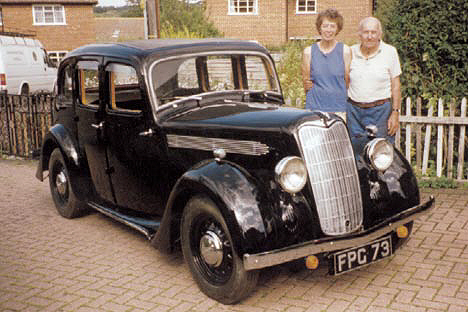
This is Tom and Barbara Davies with their 1937 12 hp saloon. Tom rescued it from a field near Brooklands Racecourse in 1973. It then stood in his shed until he retired in 1990, when he finally got around to restoring it to its present immaculate condition. Since getting it back on the road in 1995, FPG73 has won Best in Class at no fewer than 8 Classic Shows in the area, and Best in Show at 3 of them.
At the Odiham Fire Show on August 3rd and 4th 2002, Tom’s car was “requisitioned” to be the Fire Officer’s car for their Wartime display.
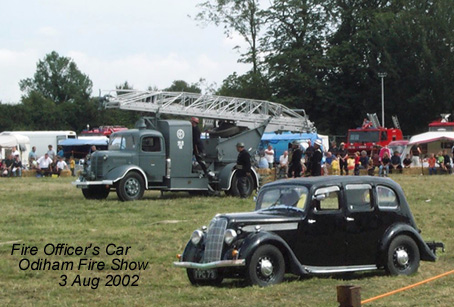
Super Nine
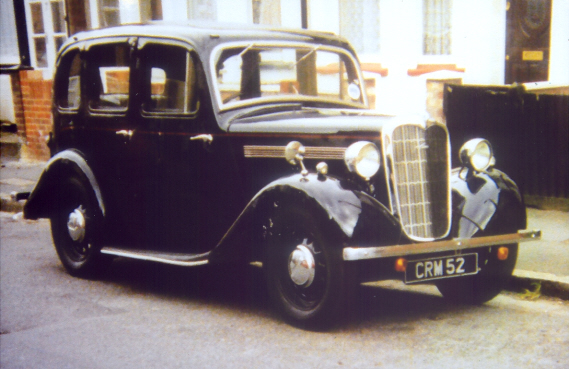
This is David Calo’s superb 1937 Super Nine, which he bought about 10 years ago, as his mother had bought him one of these for his 17th birthday. He learned to drive in it and used it for the next two years or so to commute to work.
Dave says CRM52 is in beautiful condition, and brings back many happy memories for him and that he will never part with it. Dave specialises in Veteran, Vintage & Classic cars and trades under the name DRC Motors in Chipperfield, Herts.
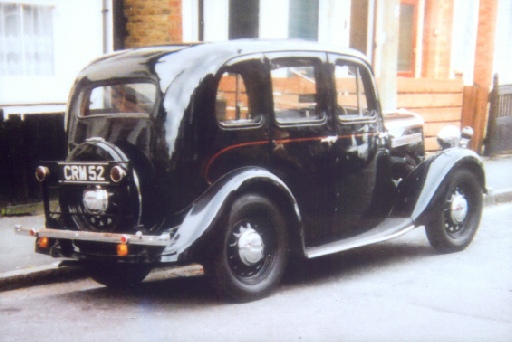
Super 9
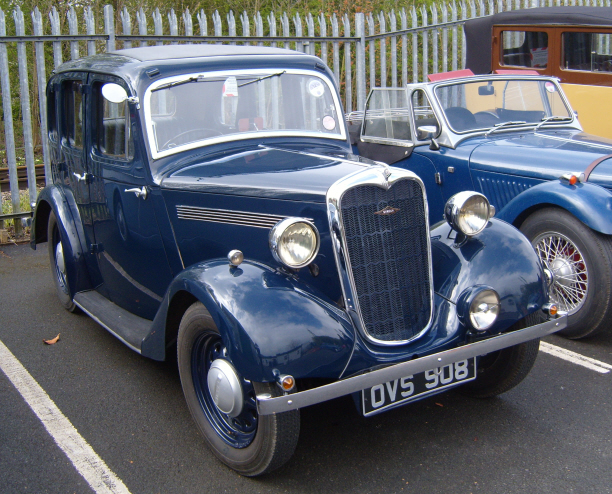
This is Richard Heaton’s beautiful 1937 Super Nine, which he has recently acquired after a long search for the right car. OVS908 was first registered in August 1937 to a lady owner in the Carlisle area, costing her £165. Mrs Edith Brown used the car until 1955, when, at the time of the Suez crisis, it was left in her wooden garage with only 25,000 recorded miles. In the mid 1980s Edith sold the car to her doctor, David Wheeler, who had the body work and some mechanics professionally restored. Regrettably the next owner only kept it long enough to transfer the original number CRM74.
Custodian from 1983 till December 2009 was Peter Eastfield of Milton Keynes.
The engine at 972cc is overhead camshaft, and the gearbox a four-speed ‘Permamesh’ crash type, with a freewheel giving a clutchless gear change.
Richard says that now he has mastered the gear change, he and the Super Nine are getting along just fine!!
Bantam 9hp

This was John Horne’s 1937 9hp Bantam. The picture was taken on the ASCO plot at the Queen Elizabeth Country Park Show organised by the South Hants Vehicle Preservation Society. John is sitting next to his car and talking to fellow Singer enthusiast Ian Rowthorne.
11 hp Saloon
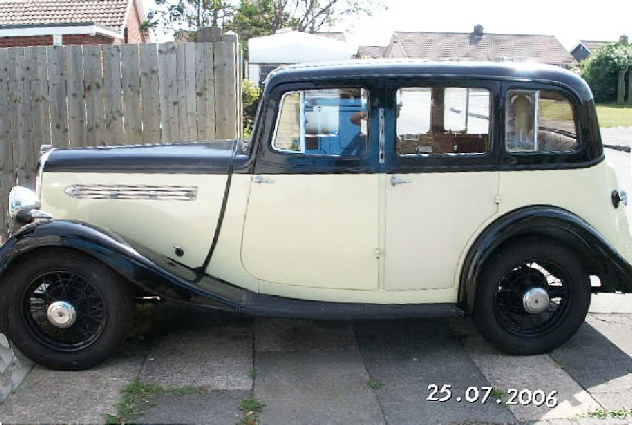
This is John Passman’s 1936 11 hp Saloon. John tells us:
“When new, the car was owned by the headmaster in the village of Hurworth. After many years he sold the car to a former pupil in Wingate, Durham. It was then sold to a friend of mine and I purchased it from him in 1966 – I cannot remember exactly how much I paid back then – I think it could have been about £25.00 – a princely sum for a 23 year-old.
I used the car was used as a run around – stockings had to be tied between the suicide doors so that nobody fell out. I even managed to get a speeding ticket! In 1975 the car went into my mother’s garage and remained there in a sad and sorry state until my 50th birthday when I decided to do a full renovation. I had the foresight to put the lights and seats in the loft, so they remained in a good condition. It was a long process – parts were then, and still are, difficult to locate.
I managed to buy the last run of brown Rexine from an autojumble in Hartlepool, and used it to recover the back seats. I renewed the wooden parts – frame and doors – but mistakenly used hickory instead of ash. I bought a thick run of brown wool carpet – as close a match as I could get to the original – and cut, hand stitched and edged it all. The engine developed a hairline crack (a real disaster) and had to be stitched. I took the bodywork back to the metal and repainted it. I relined the doors, but still have a bit of finishing off to do. The headlining was done by a local firm, Trimco.
I am not keen on going out in it in the rain, as the sun roof has a tendency to leak a bit, but I did win third prize at Hurworth show – one of the judges there said he liked to see an old car brought back to life by its owner rather than a showroom piece.
The brake cylinders seized up every year, so I had them re-sleeved and they are now perfect. I also had the steering box refurbished by a firm in London. I need to locate some king pins and bushes. I managed to get in touch with the second owner of the car as he still lived at the same address shown on the log book. He came to see the car on his vintage motor bike, and brought some hydraulic oil which had originally belonged to the Singer. He was amazed that the car was still around.
I have just sent the camshaft away to Dave Newman to have a new one made, and for the cam-followers to be heat treated.”
John thinks this project will go on and on!
Le Mans 1.5 litre Special Speed
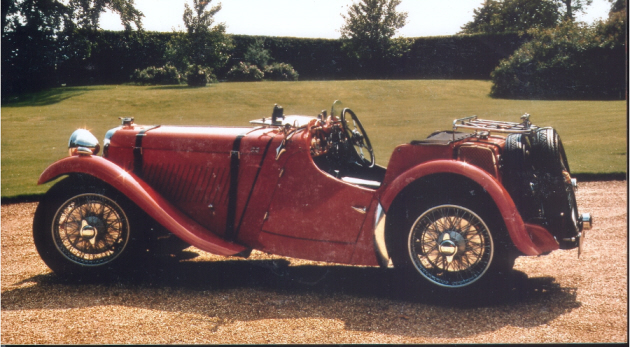
This is Danny van Audenarde’s 1936 1.5 litre Le Mans Special Speed, The engine is 6 cylinder, with triple carburetters.
The car started life with registration no CYX56, and in 1954 was bought for £100 by Bertie Gollop’s dad, who sold it a few years later – for £100 – to put down the deposit on the family home – he has wondered what had happened to it ever since. John Horne checked his records and found that CYX56 had been exported to Holland, from whence Danny bought it about ten years ago and took it home to Belgium. There it was given registration no FVJ600, which is why we couldn’t find CYX56 on the DVLA computer or in our club records.
‘Dad’ was delighted his old car was still on the road, and has found a couple of photos taken during his ownership, when the car was black. So Bertie has found her dad’s old Singer, and Danny has another piece for the jigsaw of his car’s history.
Sports 4-seater 9 hp
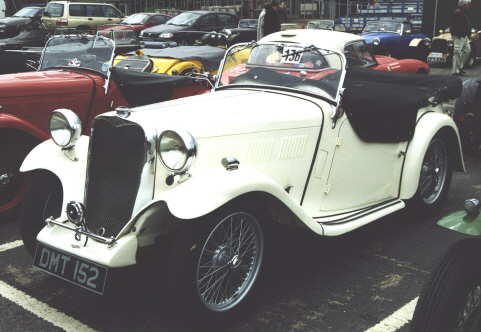
This is Chris Sharman’s 1936 Sports 4-Seater 9hp. This photo was taken at the 2002 MCC Centenary Brooklands Meeting. A great day, with the Singer successfully climbing the Test Hill.
Chris has recently cured a steering wobble problem by fully overhauling the front suspension and steering. Chris says the car now handles impeccably. Looks pretty good too.
Nine IFS Saloon
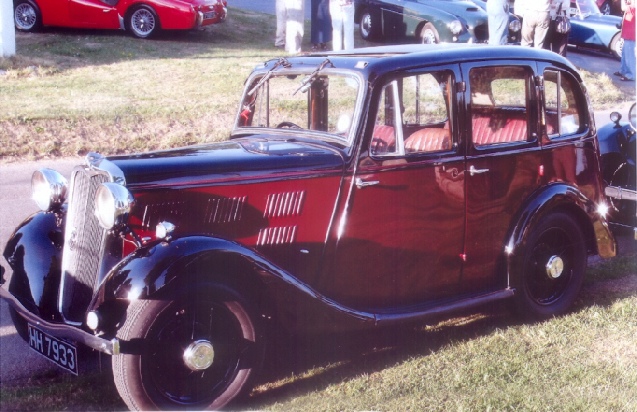
This is Mike & Mary Lyne’s 1935 Nine IFS Saloon, which they bought in 2007 from Graham & Bowness’ Garage in Carlisle, who, in 1935, had supplied it to it’s one and only previous owner. The car had never been restored, and had done only 28,000 miles when Mike took delivery.
The garage had apparently ‘acquired’ the car in 1964 when they bought a piece of ground next to their business, the car being found under wraps in a shed on the land. Mike was told that, having been given a supply of fresh petrol and a new battery, it had started first time – no surprise there, then! The garage had displayed the car in their showroom and at local shows, and only decided to sell it because their foreman, Brian, who was responsible for looking after the car, was retiring.
Since buying the car, Mike has replaced some woodwork that was affected by woodworm, and has had the rear halfshaft seals and a wheel bearing replaced, and new brake wheel cylinders fitted. The latter has made driving the car much more enjoyable, and the ‘free wheel mode’ is now a delightful and relaxing experience.
Le Mans
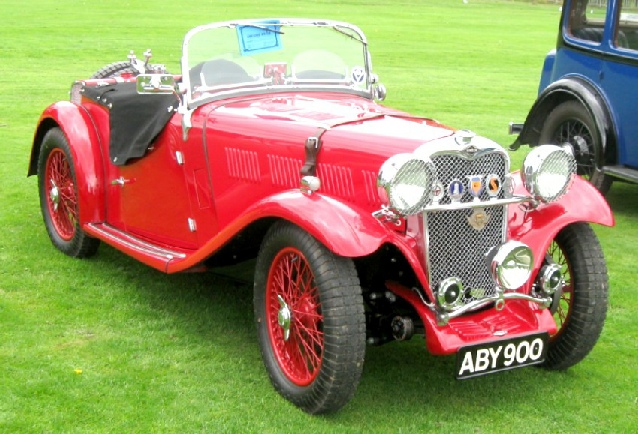
This is David James’ 1935 Le Mans.
ABY 900 was a 1935 ‘Ruddy’ team car – the Singer Red Team’, and is pictured here at the 2017 BEN Windsor Great Park Rally, where it won the 2nd in Class award.
The car was heavily campaigned by HW Johnson from November 1934, and won many First and Second Class awards, including the coveted MCC Triple.
The Car was dry stored and more or less unseen, lost to the clubs for 40 years prior to David buying it in 2010. It has lots of nice original team car features, and is visually as it was in 1935 ( badges etc ).
It has had lots of use over recent years, including Continental rallies, and was given a ‘Nut and Bolt’ restoration last winter.
Le Mans 2 Seater
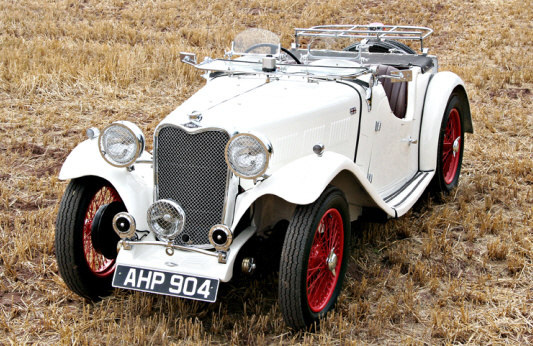
This is Gareth Thomas’ 1935 Le Mans 2 seater. The Le Mans has been owned by Gareth’s family some 25 years now, and has been regularly used and travelled often throughout Europe, across the Alps and down to Spain. Gareth has been busy bolting a few parts on it, a proper Lucas CW1 wiper motor, decent new King of the Road wing mirrors, an original spec Jaeger Temperature gauge (to replace the non spec Smiths one which had been bugging him for the last fifteen years) and is looking forward to running the car up to Newby Hall for the 2007 SNCR.
Le Mans 9hp
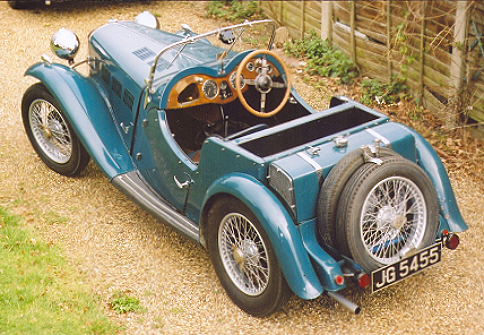
This is Simon Bishop’s 1935 9hp Le Mans
Simon bought it from an old friend who happened to mention at a family wedding that she was thinking of selling the car after many years of using it for rallies, general transport and shopping, only stopping when her two sons grew too big for the car. She asked Simon if he knew anyone who might be interested. Simon has no intention of buying another car, but, he says “you know how it is!”
Twelve years standing in a lock-up had taken its toll, but after renewing the brakes, water manifold, several tyres, the clutch and all sorts of other little jobs, the car is back on the road.
Le Mans 4-Seater
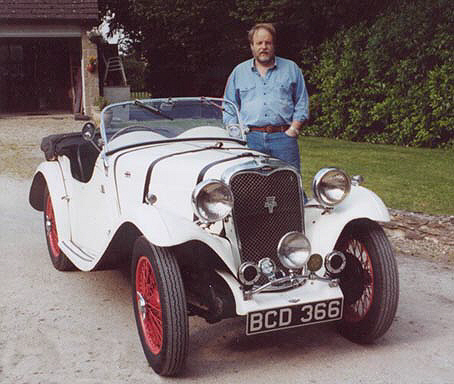
This is Nick Warren’s 1935 Le Mans 4 Seater, Nick bought the car in 1996 from the estate of a Singer enthusiast who had restored it in 1977.
The Four Seater Le Mans were sold between November 1934 and October 1935. Approximately 500 were made, of which about 25 still exist. Nick is compiling a register of all the cars (past and present) and if you can add to this information or photographs, he would be pleased to hear from you.
Nick is the SMC South West Area Representative and you can contact him
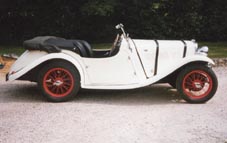
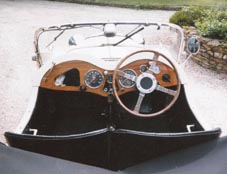
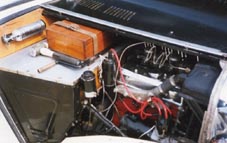
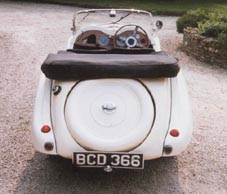
2 Litre Sports 4-Seater
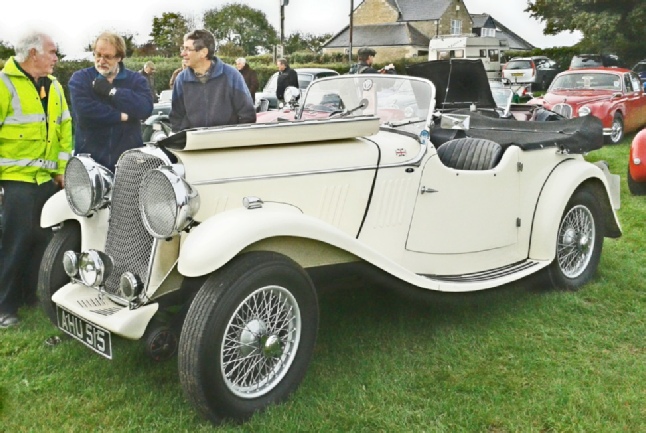
This is Nick Warren’s 1934 2-Litre Sports 4-Seater. Nick says he has hankered after a 1.5 or 2-Litre Sports for about 20 years. The problem was that Singer made only about 120, and only 13 of these are known to have survived. But his chance came in April 2014, when a friend rang him saying it was time to get his cheque book out, as Pierre-Michel Singer’s 2-Litre Sports was to be auctioned by Bonhams on 7 June in Oxford.
The car was originally a 1.5 Ltr, but when its engine became unrepairable in the 1980s and no 1.5 Ltr Singer engines were available, an Austin Healey 100 engine was fitted. In 1993 this was removed and a 2-Ltr overhead-valve engine from a Singer ‘Silent Six’ installed.
Michel, his wife and the car had retired to Monaco in 2002, but due to ill health he decided it was now time to part with his favourite car, which had been re-registered in Monaco as X934 from its original UK registration of AHU 515.
Nick and Trish went to see the car on the preview day, and it was everything he had lusted over. So the next day they retraced their route to Oxford, and by the time Lot 27 came up, Nick was sure his pounding heart could be heard miles away! The bidding between two parties was slow at first, but when one of them dropped out, Nick decided to bid. A new party bid him up about a couple of thousand, but then, suddenly, all quiet …bang!! The hammer came down and the car was his.
AHU 515 is now legally back on the road, and Nick & Trish are enjoying using her. Nick says ‘her’ as they always give their cars a name. He asked Michel what they called her – ‘The White Car’ came the response. But that was very confusing, as Betty, their LM Longtail, is white as well, so after much family discussion, AHU has been christened ‘Grace’, as she is a Princess from Monaco. And Pierre-Michel approves!
Le Mans Long Tail
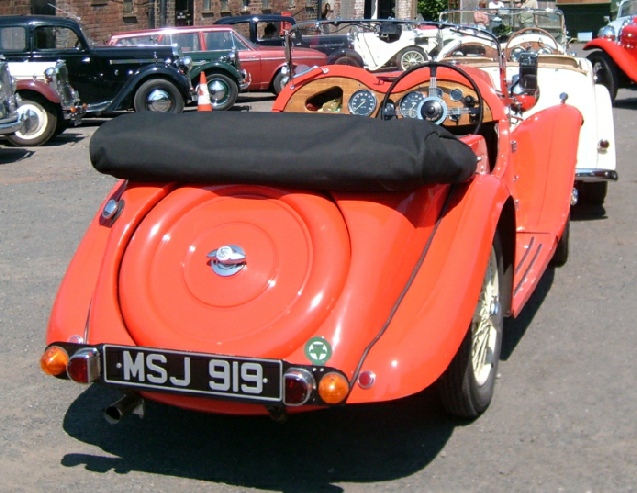
This is Jim Pegram’s very attractive, 1934 Le Mans Longtail, seen here at the Blists Hill Museum on our 2012 SNCR Weekend in Ironbridge. Jim tells us:
“My car, chassis no 63217, was delivered to Cook and Palmer, London on 28th Nov 1934 and sold to F Cox of North London on 2nd Dec.1934. It was originally black with red wheels and interior. (Although the interior is now brown, where it has had heavy use the brown has worn off, exposing red underneath.)
I know nothing else about the car until sometime in the 1970s, whenI think by then it was registered LSU 911. In 1998/89 it was stripped of that number and given MSJ 919, which is not transferable – at least it can now retain it’s identity. At this time somebody made a mistake with the paperwork, and the car is lumbered with the Vin No. of a modern car, very possibly the one that took the reg no. I have spoken to a previous owner who tried to put this right, but got so bogged down with the DVLA that he gave up. I regard it as part of a very chequered history, and am happy to let sleeping dogs lie! I gather the number LSU 911 is now on, would you believe, a 2005 Porsche 911 Carrera 2S.
I acquired the car in 2007, and tried very hard to live with a plethora of mechanical problems that I hoped to steadily get on top of. After a couple of years throwing money at an engine that was not likely to ever be capable of the distances I had in mind, I began to face up to the idea of converting to a BMC engine and gearbox, and fitted a 1275cc engine and box from a
Morris Marina.
The performance and reliability are now transformed, although I still have a long list of things to improve with regard to my installation. The car is now getting the sort of use I had originally intended.
The car covered 1400 miles from purchase to Marina engine in the winter of 2010. It has covered 2400 since.”

LM 1.5 Sports Special
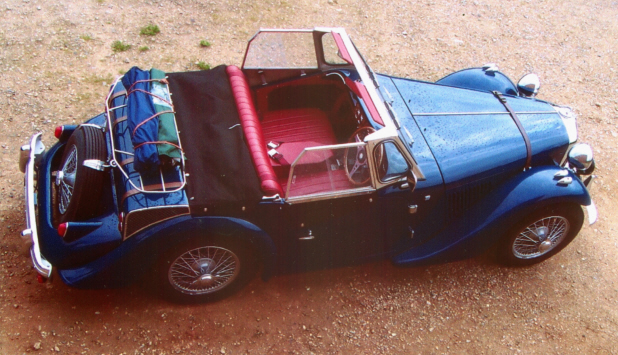
This 1934 Le Mans 1.5 litre Sports Special BKE185, with 13″ drums and 22 gallon tank was formerly owned by Colin Mills. .Its chassis no is LM10 (Mk1, using the 9hp chassis) and was purchased by Colin in July 1956 for £127 (8 weeks wages).
An accident in 1956 wrote it off. The chassis and axle were straightened and a new body was begun in 1958. Rebuild work slowed due to marriage, ceasing altogether in September 1963, when the car was garaged on blocks for 37 years.
Work restarted in 2000 after 5 children had left home.
‘When I bought the car in 1956 it looked like this, with the cycle wings already in place. After the car was written off in an accident in 1957, I decided to rebuild it and introduce a few changes to features I disliked and to meet future needs. I designed a new ash frame around new rear wings in 1958 and made this in 1960, with four modifications to the bodywork.
1 – I disliked the cramped cockpit and made the interior body 12″ wider.
2 – The space behind the seat was required for a future carry-cot, so the tank went back about 8″.
3 – The radiator grille was lowered 4″ to avoid looking along an up-hill bonnet.
4 – The spare wheel would be sloping, with an enclosed skirt and bumpers to protect all my new work.
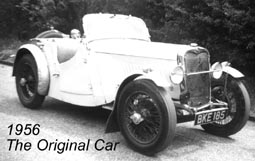
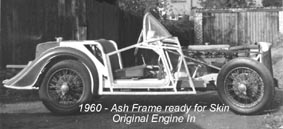
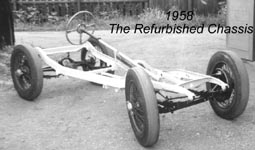
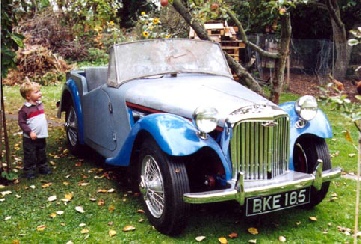
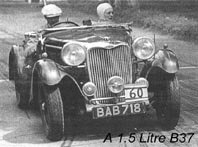
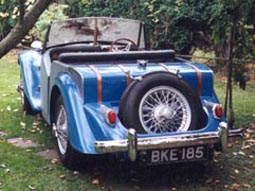
Because the radiator was to be shorter. it had to be wider, so I had one made. This was installed further forward for more engine room. No Singer grille was now wide enough for the new radiator, the widest available, and similar in looks to the Singer B37, being from a MkV Jaguar. While I had no Singer alternative for the grille, I did try to use Singers parts where possible. For example, the front wings and headlights are 1947 Roadster. The original 6-cyl 1493cc, non-cross-flow, 2-carb engine was reburbished in 1958, but as I had always had trouble with this, for example, cracked block and low oil pressure, I decided after 40 years of consideration, to replace it with a more modern alternative – with an oil filter, water pump etc. and capable of motorway use. I sold the engine (no 2133) to another Singer owner with car and boat and installed a Triumph Vitesse 1.6. In 2002, after getting it in with much difficulty, as everything fell foul of the steering column and pedals, a little used Gazelle 1592cc engine became available.
On this engine, the carburettor, exhaust, starter motor and clutch slave cyliner are all on the near side, away from the steering column and pedals, so it was out with the Vitesse and in with the Gazelle, now unleaded and running. Not clear from the pictures, the new wider body protuded sideways some 6″ beyond the fuel tank each side, so as to retain the continuous body line edge, tank extensions were added – see rear view – with additional straps covering the joins. Looks more like 32 gallons now than 22!
Wider wheels suited the bulkier look and these fitted well on the 52mm dia splines – again looking like a B37. I’ve included a picture of one for you to compare with my front end as it looked last year. There is still some work to do, including the windscreen, which was only temporary and will not be used. Now I hope there are not too many purists or concours fanatics out there, as they may be shocked at my rebuild, which did not dulicate the original car. However, I knew the car would never be sold, so I thought it was better to modify it to suit my requirements rather than scrap it.
That was my choice – the car still has the original chassis, both axles, steering linkage, petrol tank, suspension, dampers, brakes and sidelights. The (minor?) changes to the body shape now suited my physically wider girth, so it must have been premonition 45 years ago when I started the rebuild!’
Le Mans
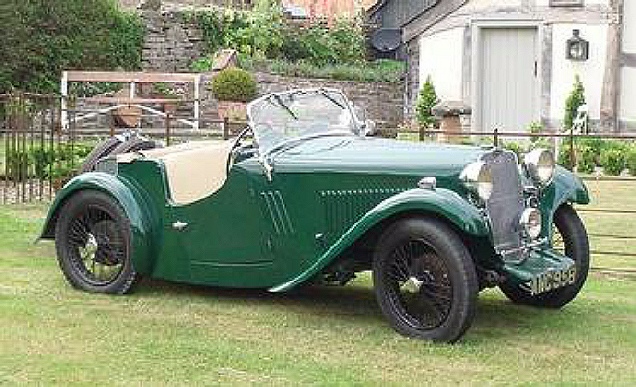
This is Dave Thompson’s 1934 Le Mans. Dave tells us:
I’d been looking for an interesting old car to tinker with for some time – it had been at least 20 years since I had time to indulge in vintage motoring. Then I spotted a Le Mans for sale on E-bay. I’d always fancied one – more so since being a close neighbour of Reg Cleaver, who I’m sure many will remember. I’d let the opportunity to buy his slip by before it left the country for Switzerland some years ago. I spoke to Reg before viewing, and his first words were: “What do you want one of those for?” “Good for 70 mph aren’t they?” I said. “Might be if you can put up with the vibration,” was his reply! This was the last time I spoke to Reg before his tragic death. Undaunted, the next day I did the 340 mile round trip to view. As soon as I saw ANC 958 I knew she was to going to be mine.
The chap I bought her from had owned her for about 14 years, during which he’d spent a lot of money, mainly on the body and chrome work. Mechanically it was a different story. Nothing had been done in that time, although the previous owner (Walter Harris I believe?) had done some engine work.
The chassis, engine and gearbox looked sad. Oil pressure was low. The clutch rattled. There were the odd oil and water leaks. Lashed up floor, fitted scuttle area etc. But I wanted to tinker – a challenge perhaps – nothing concours, but usable in the true spirit of ’thirties motoring.
A deal well below the asking price was struck, and this included enough spares to fill the back of the Land Rover. The car was collected by trailer the following week.
Time now to really evaluate what I’d bought, tentatively doing a few fine local summer evening runs. Only running on one carburettor. Can’t hear myself think over the rattling clutch. Brakes pull violently to the nearside. Rev counter U/S. Same for temperature gauge. Oil pressure 10 psi. No charge showing. Draught from the floor boards wrapping the apology for a carpet around my legs. Suspect and discover leaking petrol tank. Despite all this love it to bits!
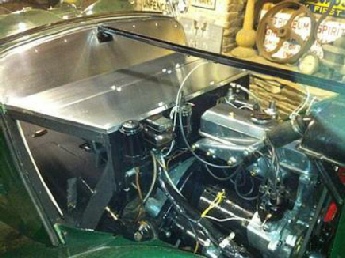
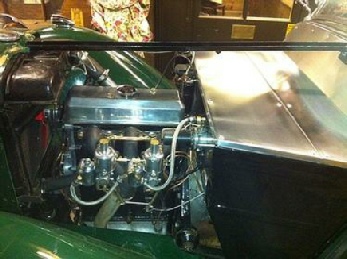
Many long cold winter days spent stripping and rebuilding engine, which was discovered to be good, with obvious new pistons, liners and camshaft. Fitted new rocker shaft, valves, oil relief, gaskets, and cleaned the years of accumulated crud out of the sump. All painted and polished to look the part.
With floor boards out, all accessible chassis cleaned and painted. Rear shockers refurbished.
How should the floor be? It was such a bodge, with the support rails cut short and split around the handbrake, so I decided to make new ones. There were no real clues, but the question put to John Horne of ASCO soon produced answers, along with some drawings to work from. Many thanks to him. Surprising also, the amount of infomation on the good old internet. A new tunnel from Dave Hardwick completed the job.
The next area to tackle was the scuttle and toe board, eventually getting the angles about right on the second, or was it the third, attempt! Fellow Le Mans owners who have done this will probably know what I mean. I’m a big believer in doing everything myself, but was a bit apprehensive about the new aluminium needed around the scuttle. How do you get a fold on a curve without a wheeling machine? But it’s done. Again not concours, but it’s all my own work.
Oil/Temp gauge sent to Speedy Cables for a quick and reliable refurb. The rev counter unfortunately sent to a man who thought he could do it, then deciding, when chased two months later, he couldn’t! Tried again with Speedograph-Richfield, quick return but unfortunately faulty. Now awaiting it’s return, hopefully sorted.
Indicators fitted to rear on plates attached to number plate (didn’t want to drill any holes) and front side lights converted to double filament for the flashers.
The big moment….turn it over. No oil pressure – should have primed the pump! Success now with good 25-30 psi, but leaking behind oil pump. Strip to rectify – not once but three times! Could do it in my sleep now!
Looking good now apart from the painted radiator surround and previous owners DIY seating, both jobs for some future date. Can’t wait for those summer evenings around the Shropshire lanes.
Whilst not perfect, its My Le Mans, and it gives me a certain satisfaction every time I look at it. Obviously I’d love to hear from anybody that remembers the car.

Le Mans Sports
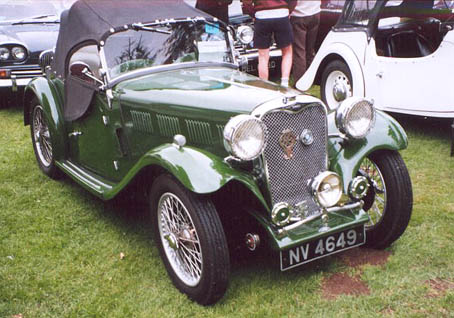
This is Derek Smith’s 1934 Le Mans Sports Details to follow, but this car is as tidy under the bonnet as it is outside, and was winner of the Johnson Memorial Cup at the ASCO National Rally held at Newby Hall, Ripon.
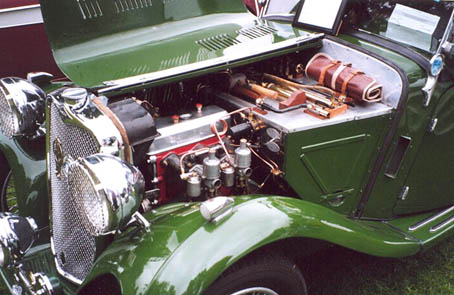
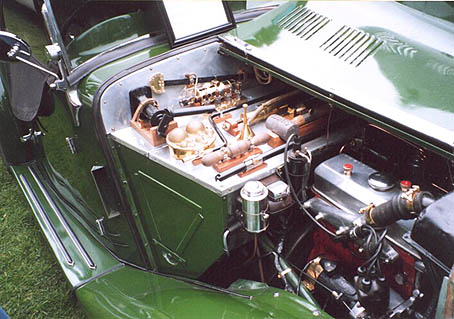
Nine Sports
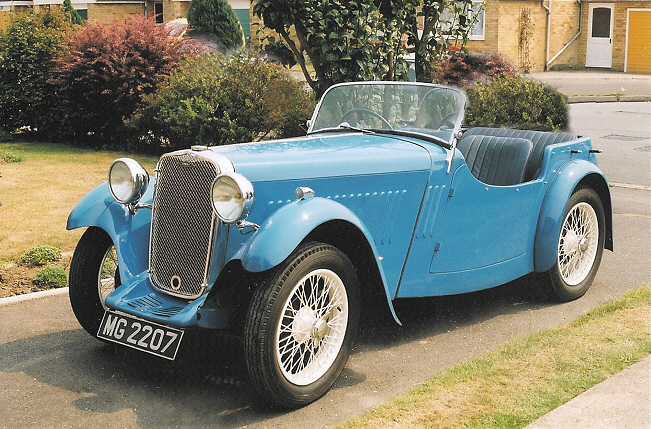
This is Margaret Gardner’s 1933 Nine Sports. Her late husband Mike was given the car in 1975 by his ex-boss at Austin-Rover, who wanted to dispose of it. Not only was he given the car, it was transported to his house on the works Land-Rover and trailer. The picture below shows the car on Mike’s driveway as delivered. It was then that Mike realised the registration number was MG 2207, which is not only original, but a personalised plate with his initials.
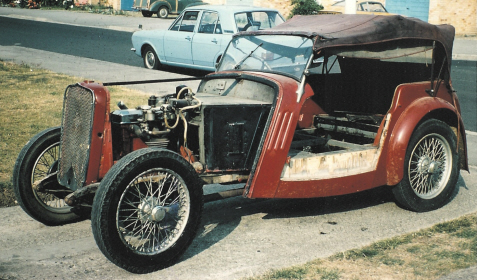
The B & W picture is of the car in its glory days on the 1933 London – Edinburgh Trial – (somewhere in the Yorkshire Dales?) with its Rally No 241 as detailed in the programme.
The Autograph on the bottom of the picture if that of Stirling Moss.
Mike also has copies of he original programmes for the June 1933 Brighton to Beer Trial; the October 1933 Buxton Trial; the December 1933 London to Gloucester Trial and the December 1933 London to Exeter Trial, but has no history of the car between 1934 and 1975.
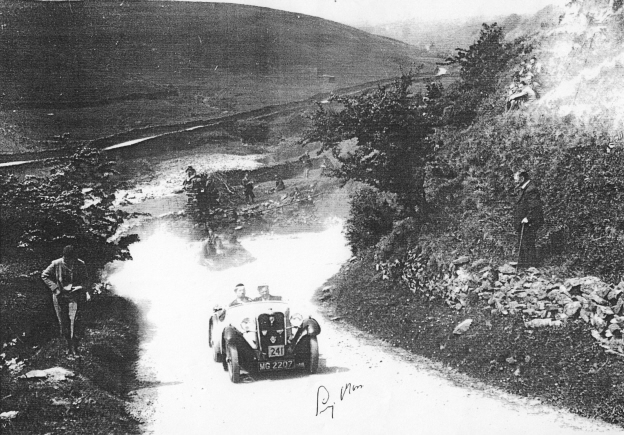
Brooklands Racer
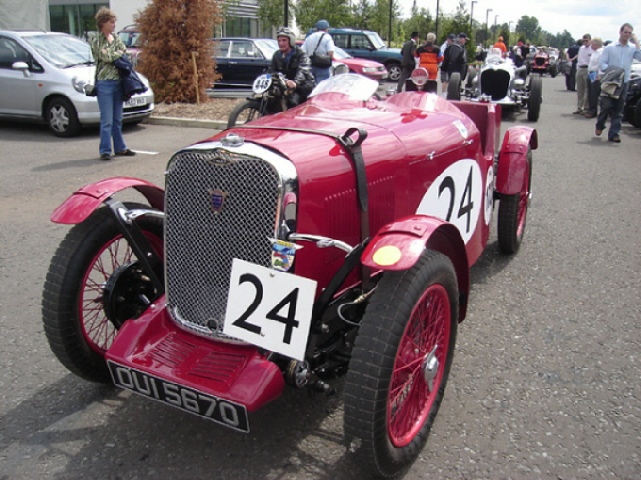
This is David Swann’s 1933 Brooklands Racer OUI 5670. The car is a recreation of KV5670, which was the red car of the red, white and blue team cars built by the Singer Competition Department shortly after it was established in April 1933. These cars competed in the Light Car Club Relay Races held at Brooklands in 1933 and 1934. The red and blue cars also raced at Donington Park in August 1933.
David’s interest in them stems from his discovery of the white team car (19B) in June 2004. Following his unsuccessful attempts to persuade the owner to part company with 19B, and it’s temporary loan to the Brooklands Museum, David’s attention focused on tracking down the red team car. He found that shortly after finishing the 1934 Relay Race, the red car was sold to the One Tree Motor Co., Huddersfield. Their Sales Director, J.D. Middlebrook, raced it later that summer at Donington Park.
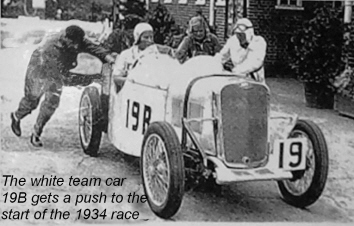
In May 1935, KV5670 appeared at Green Bros in Leeds where it was purchased by Rex King-Clark. Later that month Rex traded in the Singer for an MG J4 at Allens Motor Mart in Bradford. The last recorded owner, George Sherwen, owned a garage on the same road as Allen Motor Mart. According to DVLA records, KV5670 is believed to have been scrapped in 1946.

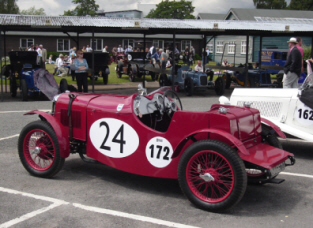
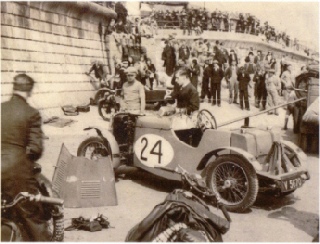
Inspired by Rex, the oldest surviving member of the BDRC and one of two pre-war Brooklands drivers left, David set about recreating the lost ‘Brooklands’ racer in April 2005. The basis of his project came from one of the very first production 9 Sports, chassis 45063, registered ten days after the 1932 Motor Show, and using pictures from Rex’s meticulous photograph albums and diaries, which yielded many previously unseen pictures of KV5670, David completed the car in April 2007.
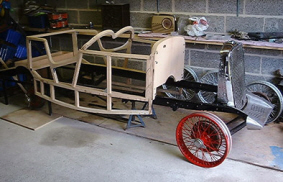
Wikepedia tells us that Rex King-Clark MBE, MC was a British Army World War 11 pilot, racer, photographer, author and diarist, who once headed the Army Air Corps. He served in the Manchester Regiment from 1934, and in Palestine fighting Arab guerillas from 1936 to 1938, for which he was awarded the Military Cross. Outside his army career he raced cars, driving a Monoposto MGK4 at Brooklands in 1936, as well as achieving 59mph in a Lombard and racing a 1933 Singer 9 at Filey Sands. That Singer 9 was, as you can see from the photo, KV5670. Its recreated twin was the only Singer at the Brooklands Festival on 17 June. He was fortunate to be included in the special display of Brooklands cars. Highlight of the day was the short sprint on the original Byfleet Banking, and John Cobb’s 24-litre Napier-Railton pulling up behind him on his return to the club house enclosure!
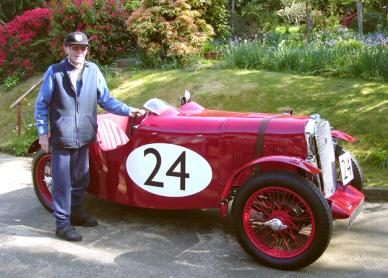
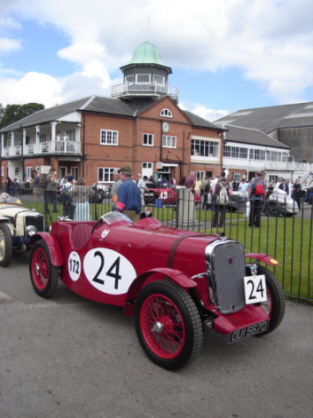
Super 12
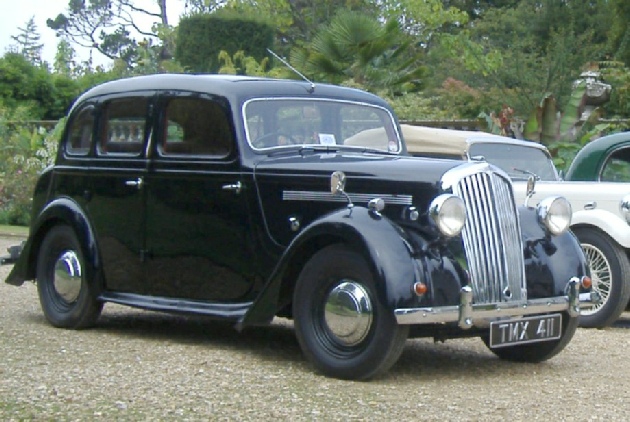
This is John Bramwell’s superb 1949 Super 12.
This picture was taken at George Singer Celebration at Kingston Maurward College on 13 September 2013.
The car was first registered on 11 Feb 1949, but as far as John can ascertain was last on the road in 1960, probably because the owner could not get it started, as it was abandoned with the plugs removed, such that when John started to restore it some 30 years later, two of the cylinders were so badly rusted they had to be relined, although as far as can be gathered from the documentation, it had done only about 13,000 miles.
John spent 16 years (on and off) on the restoration. The bodywork was so badly corroded the door pillars had to be welded up before the body could be removed for the extensive welding needed, and to fit new sills. Now, with a new coat of paint and the interior reupholstered, the car is back on the road and used regularly to take to shows
Roadster 4ADT
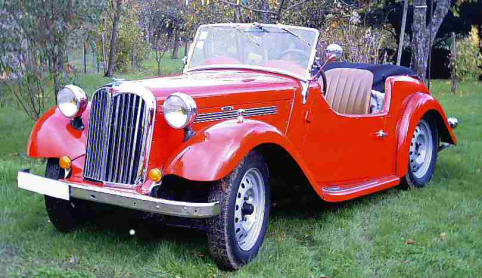
This is Guy Larpent’s immaculate 1955 4ADT Roadster. Guy bought the roadster in October 2002. It was fully restored and Guy needed only to do some fine tuning and settling. The car is Left hand drive because Guy lives near Bourges in France. Below is a front view of the car at a rally in L’Anjou in 2003 – the rally plaques reads:
“26th Randonnee Jean de Berry”.
Guy has now created his own website for his car – it is in French, and Guy hopes it will help “bridge the gap” for Singer owners in France.
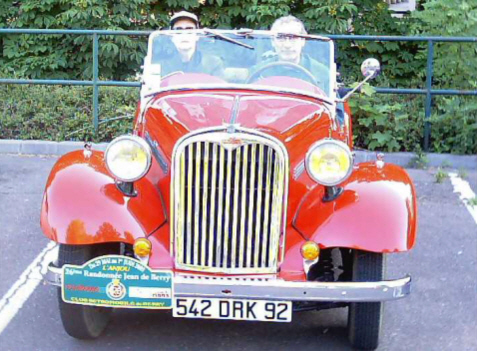
SM1500
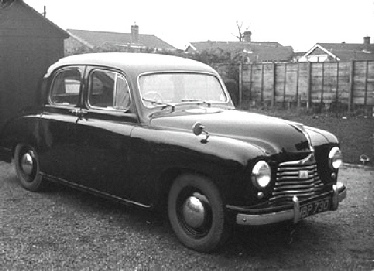
This was Barry Paine’s 1952 SM1500, but it is now in the Museum of British Road Transport at Coventry.
Hunter Deluxe
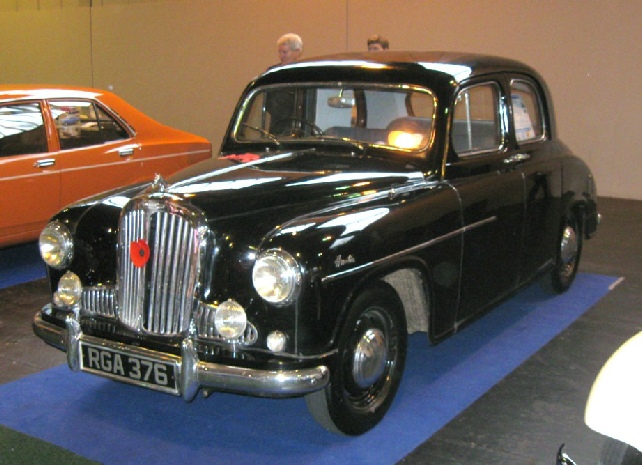
This is Angus Glen’s 1956 Hunter De Luxe, which he purchased from Bob Andrew, who had meticulously restored it for the second time after his daughter Lucy had finished using it whilst studying at Bournmouth University, having been given the car as a 21st birthday present.
Bob had rescued the car in around 1986 from someone in Birmingham for the cost of collecting it. He spent the next year or so making it presentable and useable, and his four eldest children all learned to drive in it. After some 120,000 miles, a minor engine problem resulted a mechanic refilling the sump with a modern, 10-30 detergent oil, with disastrous results, but fortunately Bob had a spare engine, which was duly overhauled and installed, so they carried on using the car.
In around 1996 Bob asked a well-respected metal worker to inspect the bodywork, which at first didn’t look too bad, so work started on tidying up the sills and rear wings, when it was found that the rear of the chassis was severely rusted, so in true “I’ve started so I’ll finish it” mode, everything that resembled rust was replaced, repainted and rust-proofed, everything chrome was rechromed, the headlining renewed, the whole car resprayed – even the clock was repaired – and there wasn’t even one ‘advisory’ on the MoT Certificate!
In 1994 the car featured in the April issue of ‘Popular Classics’ in an article by Nick Larkin in his ‘Driving’ series, and in 2010 Bob wrote an article for the Mascot which sums up the car admirably – to see Bob’s article, CLICK HERE
Hunter
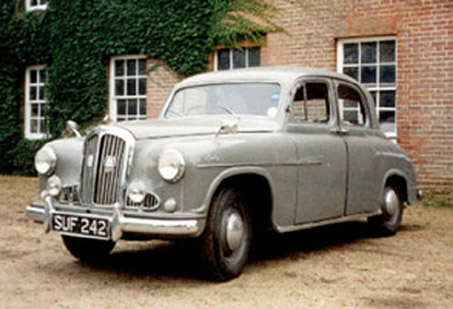
This is Tim Mann’s 1956 Hunter. Tim bought the car from former ASCO Secretary Barry Paine, a close neighbour, in 2007.
It was one of the last Singer & Co cars to leave the factory following the take over by Rootes.
Hunters were made from late 1954 until 1956 and were basically updated Singer 1500s. They were a well engineered car, with a 1497cc ohc engine and comfortable accommodation for up to six people, with good roadholding and performance judged by the standards of their day. This particular car was purchased by its previous owner in 1973 with a mere 19,000 miles on the clock and has been used for work and family transport for many years.
Hunter Deluxe
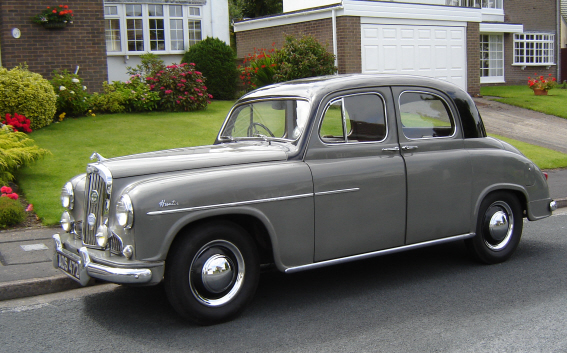
This Bill Tull’s beautiful and virtually original 1956 Hunter Deluxe. He purchased it from Colin Wright, who had owned the car for 32 years.
The car was first registered in April 1956 in Stranraer, and bears its original Wigtonshire registration. It has had only two previous owners.
Colin Wright bought it from the executor of the first owner in 1977, when the mileage was 42,000. All it needed was the paintwork “T-Cutting”, some repair work to the rear wings and a general clean up, especially underneath, so the whole of the underside was scraped down and rust treated, painted and wax-oiled.
During Colin’s ownership the car went to Scotland and the South of England many times, completed in three Norwich Union Classics and was driven round Silverstone and Castle Donnington circuits.
It also featured in Classic Car Magazine, and was exhibited by request at the Peugeot factory in Coventry at one of the company’s open days, as an example of their inherited history.
The Hunter was the last Singers to be made before the Rootes take-over at the end of 1959, and was built by Rootes staff when they took over Singer’s Birmingham factory. The car has a separate chassis and a 1497cc OHC engine, which Rootes continued to use for two years in their new Singer, the Gazelle. It is a very smooth performer and will cruise all day at 55/60 mph. The car was destined to be one of the new Singer Hunter ’75’ models, with a twin OHC engine producing 75bhp. Two chrome dots on the boot lid where the ’75’ badge would have been reveal this, but the ’75’ never went into production, although the engine was used by HRG in their sports car.
Shortly before Bill bought the car, the engine was fitted with new valves, new clutch, new brake hoses, and wax-oiled again, so hopefully it will last for a long while to come.
SM1500
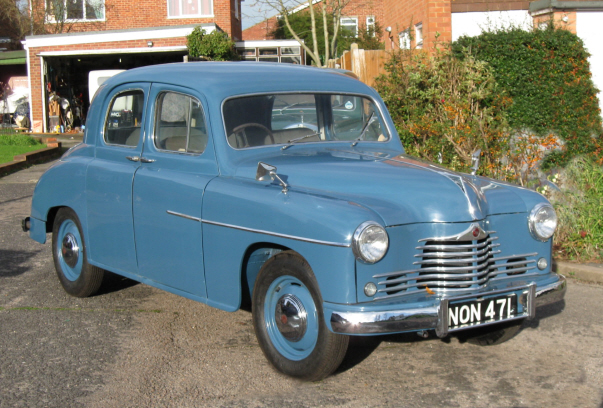
This is Ray Philips’ 1954 SM1500, which he purchased from Keith Payne, who had bought it from Mike Hyman, who had restored it and got it back on the road again after being laid up for the best part of 46 years. In 2004 Mike took over the restoration from John Spellacy, who had spent about 4 years removing the body and rebuilding most of the underbody and inner sills before deciding to emigrate.
The car had been collected new from the factory in November 1953 by Derrick Bedwell, who drove it for over 140,000 miles, taking it off the road in 1963. It then stood for 20 years until David Green bought it and got it through an MOT test, following which it did about 1500 miles before being taken off the road again, after which it stood for a further 20 years.
In May 2009 Mike, Simon Bishop and Bill Haverley drove NON 471 down to East Sussex and re-united Derrick with his old car at the Bentley Wild Fowl Trust.
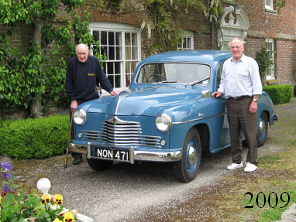
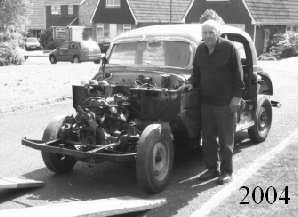
4ADT Roadster
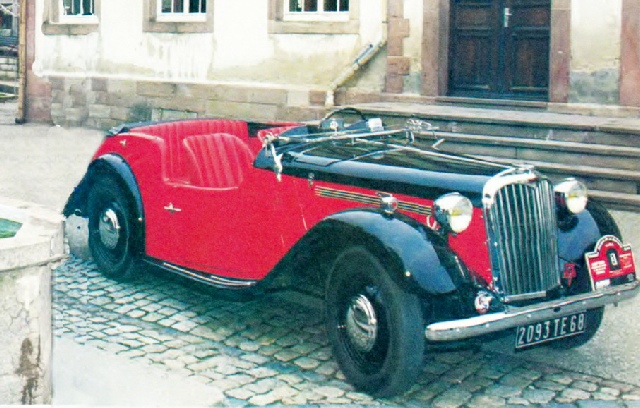
This is Eric Cassimatis’ 1953 Roadster 4ADT, who both live in Bourg des Comptes, France. The car was purchased new by the French writer Françoise Sagan, and was restored in 1985 by M. René Eberwein.
Eric sent us a copy of an article by Marc Joly, with pictures by Didier Denis entitled:
“Singer SM 1500 Roadster: Sagan’s Story”, which had appeared in the French Magazine ‘British Cars’ around 1986. This was translated for us by Chris Hayward and appeared in the April-May and June-July issues of the MASCOT, and you can see the whole article by clicking on the link below:
Singer SM 1500 Roadster – Sagan’s Story
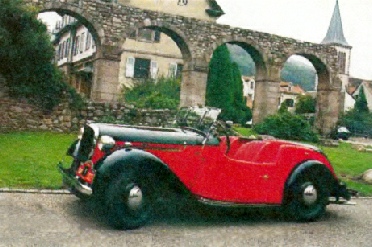
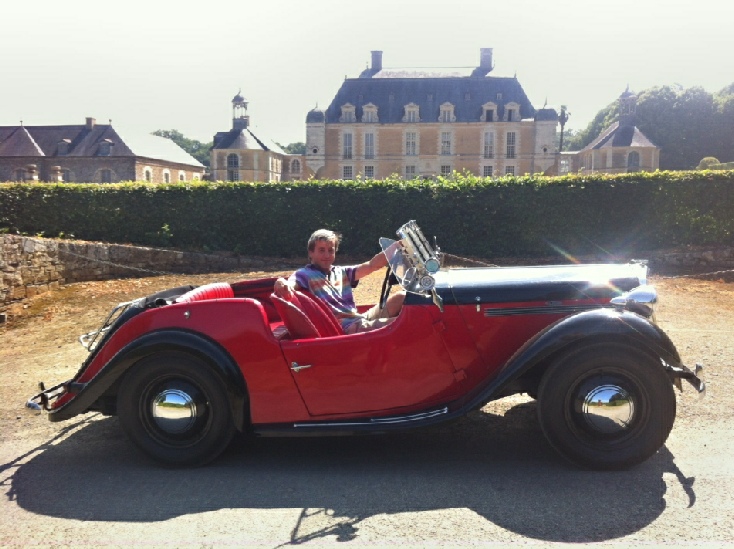
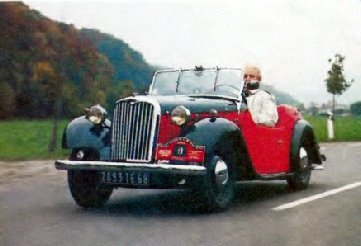
4AD Roadster
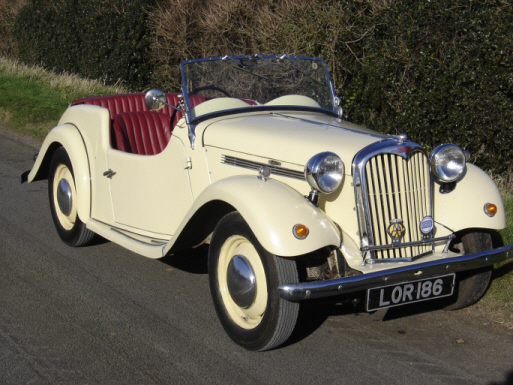
This Nigel Foster’s 1953 4AD Roadster, called ‘Lorna’ – which he purchased in Jume 2005, fulfilling a childhood dream to own a classic convertible. The roadster was first registered on 31st July 1953 to an owner in Winchester (hence the Hampshire registration index letters OR). Originally black with red interior, the car was resprayed in “Triumph Honeysuckle” at some point in the late 1950s/60s. Nigel acquired the roadster from a work colleague (at that time also an ASCO member), who had in turn purchased the car more than 20 years earlier, in May 1983. Prior to that, the Log Book shows that the car changed hands on a regular basis in the 1960s and 1970s. The semaphore indicators were disabled at about this time, and flashing indicator lamps installed at the front and rear, in replacement.
Lorna is in very good condition – when Nigel acquired her, the car was sound mechanically and structurally, having had some repair work carried out to the chassis in the late 1990s. The only restoration Nigel needed to carry out was purely cosmetic, made easier by the availability of spares and manuals through ASCO. Nigel drives her on a very regular basis, and can be spotted on sunny days negotiating the lanes of South Warwickshire, where she can still easily attain 60mph.
4AD Roadster
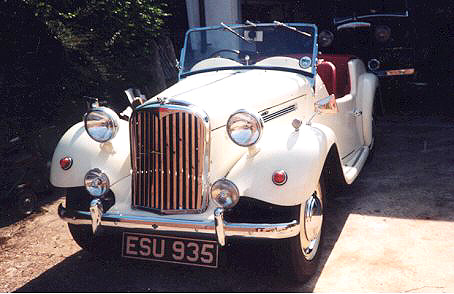
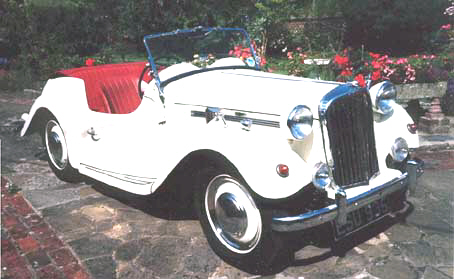
This is Bob Bryson’s 1953 4AD Roadster, which he bought from the New Forest.
The previous owner had written for information on the car’s history, but the only thing he found out was that it had been featured on a chocolate box in the 1980s. (White chocolate, presumably)
Roadster 4AD
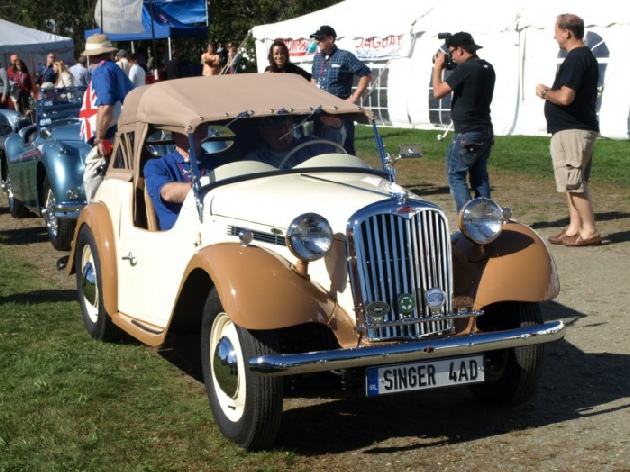
This is Craig McLaughlin’s newly restored 1952 Roadster 4AD. Craig lives in California, and told us: “I truly enjoy the Singer crowd. I’ve shown my restored little Singer three times now and already have five awards – three First in Class, one Best of Show, and one 2nd in Class, to show for my efforts.
How do you get five awards from three shows you may well ask?
Well, we took home two First in Class awards from the British Invasion at Stowe, Vermont. One was ‘Pre-65 British Sports Cars’ (yes, my Roadster was considered a sports car!), and one was in their Competition of Colors, where we won ‘Best Two Tone Paint’. Then we took First in Class at the British Car Day in San Diego, where the class was ‘Still British’, meaning it was for cars that weren’t Rolls, Bentleys, Jags, Aston Martins, Healeys, Triumphs, MGs, etc, and then Best of Show as well, so we took two awards home at each of our first two shows and then the 2nd place at La Quinta near Palm Springs two weekends ago.
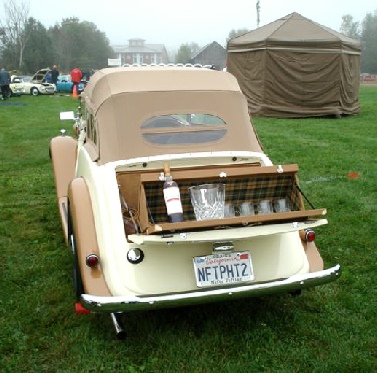
The 2nd in Class was to a car that showed at the prestigious Pebble Beach last year and was one of only 9 cars built of that type.
And there’s no shame in losing to a ‘Pebble’ car!”
Roadster 4AB
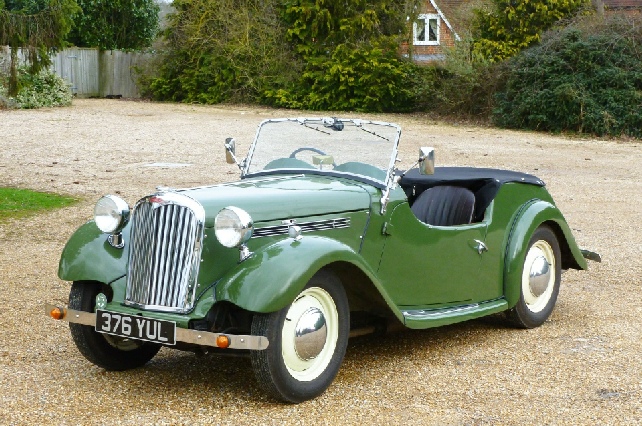
This is Geoff Rogers’ 1951 Roadster 4AB. It is his first Singer, which he purchased in August 2017 from Mike and Mary Lyne in Oakham.
The car was restored in around 2012 and, due to it having been off the road for some time, an age related registration number was issued.
Geoff is enjoying using the car and, following a winter engine rebuild, hopes to use it more during the 80th year of the Roadster – and beyond.
Roadster
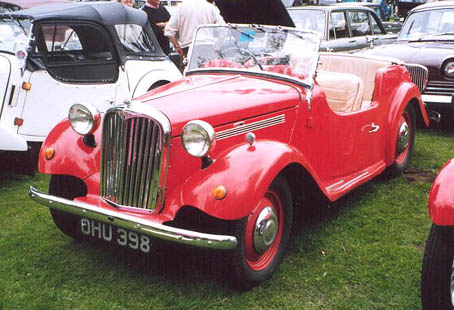
This is John Sykes’ 1951 Roadster seen here at the ASCO National Rally at Newby Hall, Ripon
John bought the car in London in 1972, when he was living in Devon. It had been advertised in “Exchange and Mart” for £60, which is what he paid for the car. It came as a total “wreck” needing a complete restoration which John undertook from 1972 to 1975. This was difficult, as he did everything himself, apart from the machining of new parts. Needless to say, he had to learn many new things!! The car is as restored, apart from replacing the engine with a restored one about five years ago. Again, apart from the machining, he did his own restoration work, learning more new “skills” and technical matters. The car is used mainly for pleasure, generally in the summer months. The bodywork was brush painted and much of the ash frame was also replaced.
Roadster 4AB

Ian and Jo Rees are the proud owners of this 1951 Singer Roadster 4AB. Jo has nicknamed the car Ella (after Ella Fitzgerald!!)
Ella was was first registered in Gloucester in 1951. Ian & Jo bought her in July 2010 from someone in Derbyshire who had her a short time but had not had the time to work on her. According to the tax disc she was last on the road in 1981. She was trailered back to S Gloucestershire, since when they have made her more attractive and comfortable. Ian & Jo got her back on the road in 2011, and are having great fun driving her frequently in all weathers!
The photo was taken outside their house (dream on!) before she was resprayed. Ian thinks the gates are somewhere above Horton village in Gloucestershire.
The car has a BMC 1500 series B engine fitted – amazing torque! Ian thinks it must have been put in just before the car was taken off the road in 1981, as the fitting was so bad there is no way it would have run in that condition!
Ian & Jo would like to find out more about Ella’s background, so if you know anyone who has any knowledge of her, get in touch via the MAIL US button. Any information will be welcome.
‘4AB’ Roadster
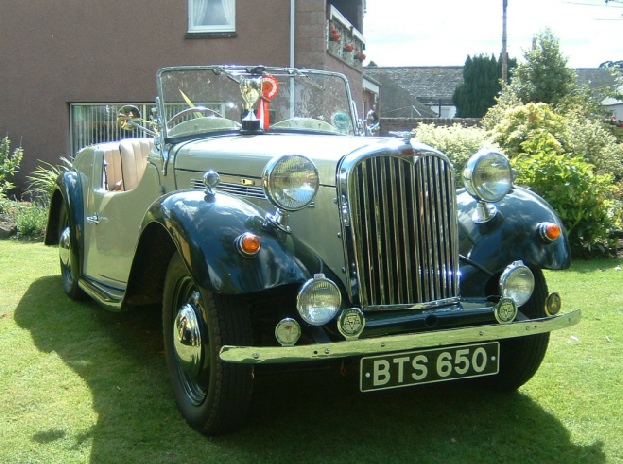
This is the late Bill McBain’s prize-winning 1950 4AB Roadster, affectionally known as ‘Ella’ – another great Singer! The trophy is for winning its class at the Scottish Vintage Vehicle Club Extravaganza Rally held in the grounds of Glamis Castle.
Another highlight was when Ella took her rightful place – in front of a Rolls Royce Silver Cloud – leading the town’s Gala Day Parade, carrying the Gala Day Prince and Princess – both primary 7 school children.
‘4AC’ Roadster
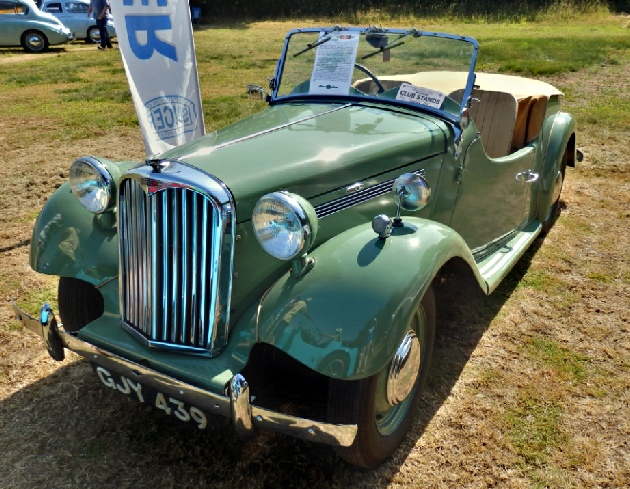
This is Martin Newey’s superb and very rare 1951 4AC Roadster, seen on the Singer Stand at Powderham Castle in July 2013.
The 4AC model was an experimental run of about 13 cars fitted with a 1200cc, sleeved down version of the SM 1500 engine, ostensibly to be eligible for the 1200cc Class which existed in many competitions around that time. However, when Martin was overhauling his engine he found it was not sleeved, but bored to the nominal 65mm rather than the 73mm of the 1500cc version. (Why go to the expense of sleeving if the bores clean up nicely without?)
The 4AC was more powerful than the 4AB and would have been an attractive little car had it not been overtaken by introduction of the 1500cc 4AD models.
‘4AC’ Roadster
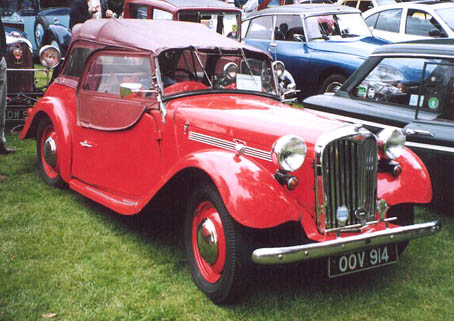
This is Ashley Crosland’s 1950 4AC Roadster, first off in the experimental run of about 13 cars and having chassis number 1. The 4AC Roadsters were intended to have 1200cc engines, and some did exist with this size engines, but this car received a standard 1500cc twin carb SM engine and so at first glance is almost indistinguishable from a standard 4ADT. Made in 1950, Singers gave this car regular face-lifts and as far as we know was the “Show Car” at the 1953 Earls Court Motor Show. Singers then sold the car to their Works Manager in 1954, (so it’s registered as a 1954 car) and it passed through various hands until Ashley bought it in 1980. It was then in bits, and Ashley was able to put it all back together, aided largely by the fact that he already owned a 4A Roadster.The car has one or two “hand built” features compared to a production 4AD Roadster, primarily in the chassis area with the X section reinforcement across the middle of the car reinforced with fillets, much indeed as can be found on the chassis of the even rarer SMX Roadster, formerly owned by the late Bill Haverley but now also owned by Ashley. Apart from the addition of flashing indicators for safety (on the headlamp stalks), the car is very original. Ashley took about 4 years to restore the car, and after relegating their 4A, Ashley and his wife Pat used it as their second car. The car has been very reliable in daily use, except once when returning from a weeks family holiday at the coast in 1991 the crankshaft broke on the motorway. Fortunately it was not too far from home, and the 4A was pressed into service with 6 months road tax whilst repairs were done. Over the years, the 4AC has been seen at numerous rallies, and Pat and Ashley have found it an ideal car for them and their 2 children. Incidentally, the photo shows the car with the driver’s door open, so it’s not actually a bad fitting door.
‘4A’ Roadster
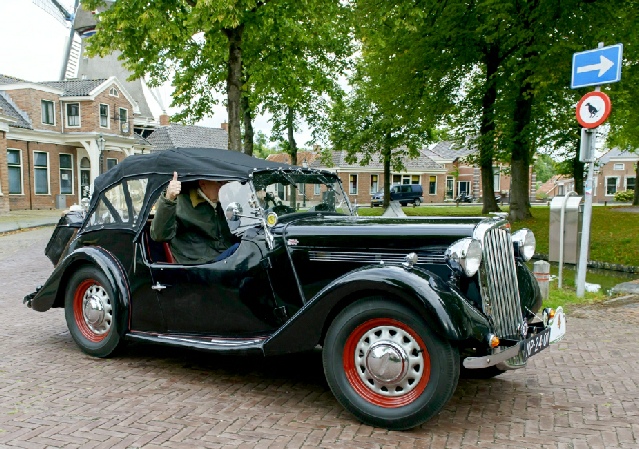
This is Geert and Sietske Warris’ 1950 model ‘4A’ Roadster, which lives in the Netherlands, hence the windmill!
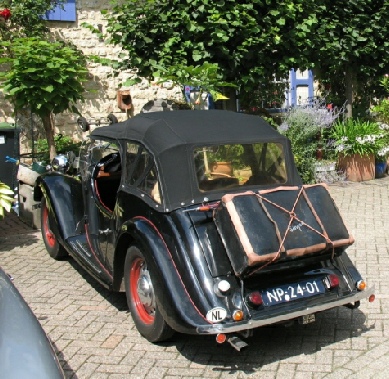
‘A’ Roadster
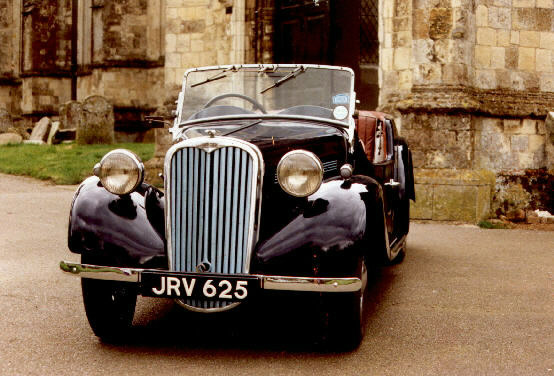
This a 1949 ‘A’ series 9hp Roadster with 1074 cc ohc engine and beam axle. When it left the factory in 1949 it went to Sri Lanka, then known as Ceylon, and in the early fifties was brought back to the UK by a naval officer. It was bought by the current owner, Barry Paine, in 1963 for the sum of £20, and has been used intermittently ever since for various purposes, including a holiday in France.
4AB Roadster
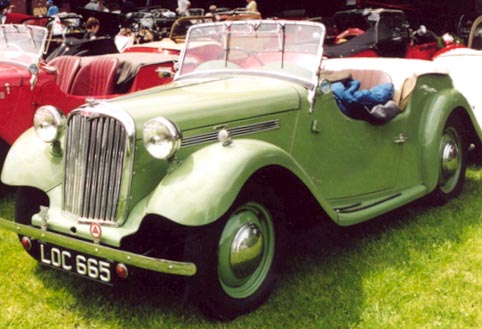
This is Bob Andrews’ 1950 4AB Roadster. This picture was taken before Bob carried out some carefully considered changes last summer. It was a highly original car, except for the paintwork, some chrome and an excellent Bill Haverly fibreglass gearbox cover. The car is an early blade bumper model built in 1950, with leatherette-covered seats (pre vynide days). These were in excellent condition but a fairly uncomfortable and unpleasant looking material, so Bob had them re-upholstered in leather. Much more comfortable, but the colour match with the other trim is not the best. Bob then fitted a narrow-slot 4AD type radiator grille, hoping for better cooling but found no perceptible improvement. Most important of all, he had a 4:44 differential fitted and the speedo recalibrated. The engine copes perfectly even with a 1 in 3 gradient and the general acceleration appears much better, but of course, making full use of the gears. Top gear acceleration, needless to say, is well down, but mpg on a run is an easy 40 at 50mph cruising, and local is almost 35, which was the best he could get on a run before!
A Model Roadster
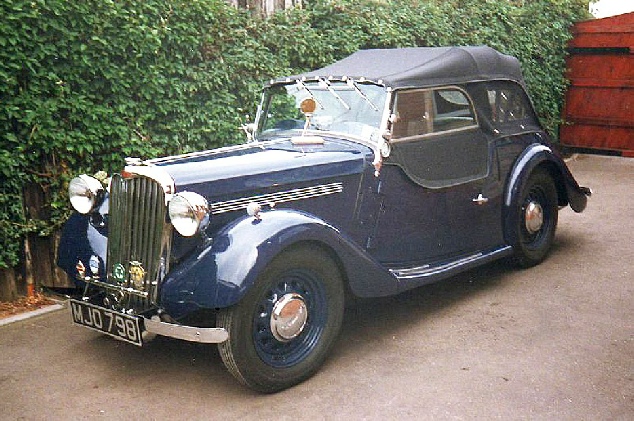
This is Dave Punnett’s 1948 A Model Roaster, which he fully restored in 16 weeks from ‘Basket Case to Show Winner ’ in 1988.
CLICK HERE for more pictures and the story of this remarkable feat.
More recently, Dave has used the Roadster for his daughters’ weddings. Sitting in the car in July 2015 is Holly and Jake, and standing by the car in August 2016 is Amy and Stef.
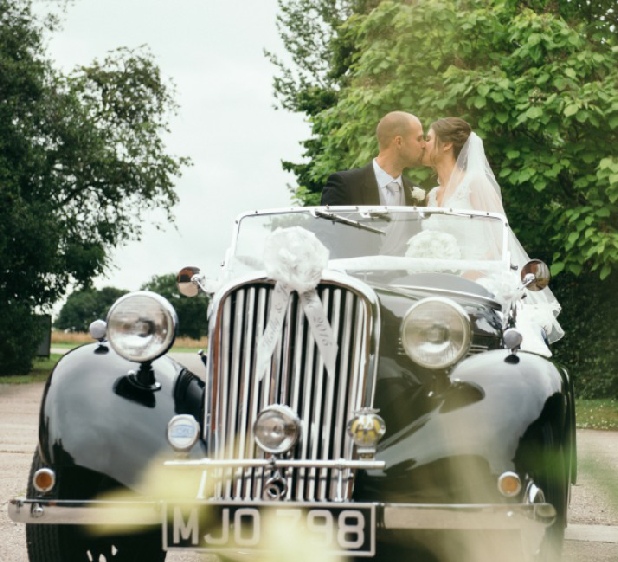
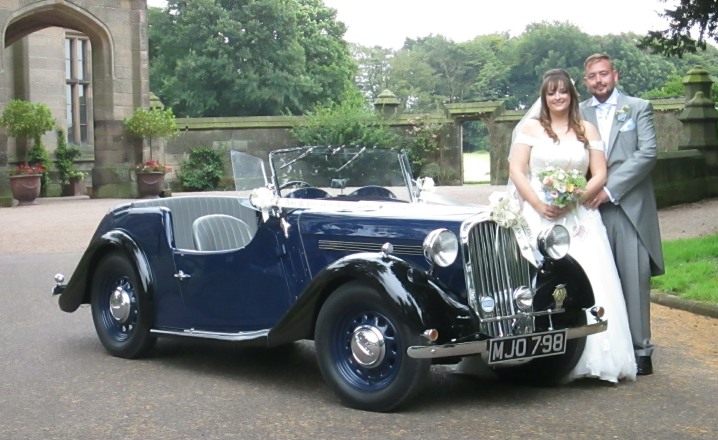
HRG 1100
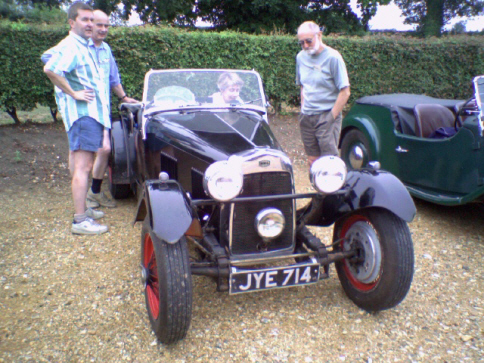
This is Matthew and Sally Bristow’s 1948 HRG 1100.
The picture was taken at Venta Icenorum during ASCO’s 2006 SNCR and 30th Anniversary celebrations. HRGs qualify as Singers because they use Singer engines – the 1100s have a Singer 9 unit with three bearing crank and improved manifolding and carburation to increase the power output.
Matthew and Sally have now taken the car to live with them in New Zealand.
Gazelle Series IIIA
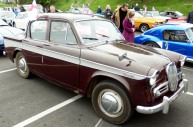
This is Andrew McAdam’s 1960 Gazelle Series IIIA.
Vogue Mk 1

This is ‘BLACK’ – Donald Lindo’s 1961 Mk 1 Singer Vogue in Bermuda
Donald’s daughter, Gina Moritz, tells us her father bought the car new in early April 1961. The story goes that as he was working one day, a shipment of cars was being driven from the docks in Bermuda to the dealership of Holmes Williams and Purvey Ltd. As they passed him he swore that right after work he would go and see about owning one of those. He followed through that afternoon and purchased the Singer for around 975 pounds, but left it at the dealership to get “backup lights” installed. Apparently the car was in the first shipment to the island – the second shipment came with them already fitted. He also had the undercarriage sprayed with “red lead” to prevent corrosion. Thus started the maintenance regime that has never wavered over all the years since.
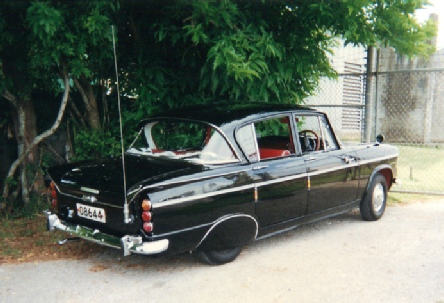
He picked her up on April 26 1961, and drove his sister to her wedding that afternoon. The car is still in its original condition. The seats still have their original red leather upholstery – he fitted white leather covers years ago to preserve them. He also removed the door panels and replaced them with varnished mahogany ones to preserve them – the originals are still hanging in the garage. Preserving older things is definitely a passion for him. The “Black”, as she is fondly referred to, is kept in a closed garage, and, even though she only gets “exercised” on the weekends, she is washed and polished once a week. The original black finish is so shiny that people often stop him to admire it as he drives around the Island.
You may have noticed the rear wheel arch covers – these were fabricated locally many years ago. You may also have noticed she has amber front flasher lenses, whereas the UK Mark 1s had white, but they have not been changed – the car came that way. The car also came without wing mirrors, so these were added, as were the backup lights, as an aid to reversing. Another interesting tit-bit is that the gentleman who now helps Dad with maintenance and repairs, is one of the original mechanics from Holmes Williams and Purvey when he bought the car.
The car has 86,028 miles on the clock as of today. She has never had any major repairs – just routine maintenance – and has never let Dad down in all her fifty-one years – he says she even knows her way home!
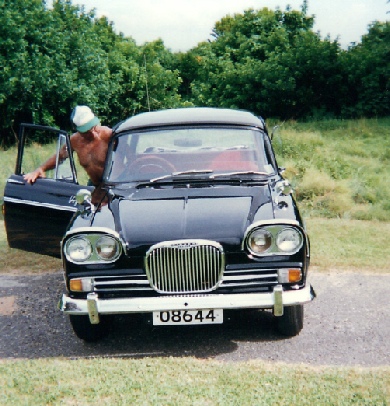
Vogue Series 2
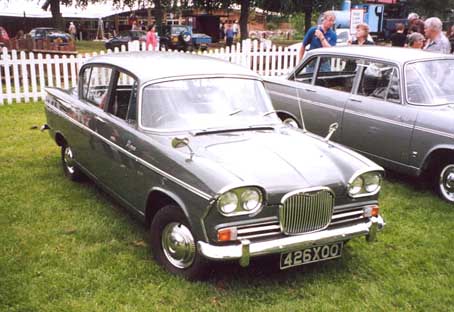
This is Steve Williams’ 1962 Vogue Series 2. He also has a Vogue Estate.
Steve is the Vogue Registrar and Area Representative for the Midlands.
Vogue Mark 1 Estate
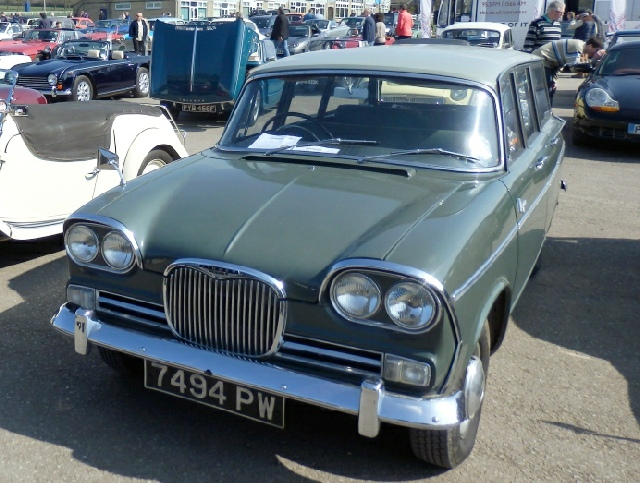
This is Barry Paine’s 1962 Vogue Mark 1 on display at the Footman James Classic Car Show in Shepton Mallet.
The car has covered a mere 17,000 miles from new. Paperwork with the car includes all documentation since purchase, plus the original sales invoice and related information. The ignition key is still on the original fob received from Singer agents, Howes of Chapel Field in Norwich.
Following minor damage resulting from contact with a garage door, the car was laid up with 14,000 miles on the clock sometime around 1969. Following the owner’s death and the passage of some years, the Vogue was rescued from its decrepit garage in 2000. Minor repairs were carried out, including the making good of the ‘garage door’ damage, and the Singer was used sparingly until it was purchased by the current owner in 2011. The car has been used for various rallies, but has suffered from fuel problems caused by ethanol ‘cleaning out’ the petrol tank and depositing debris in the fuel line. With this problem sorted the Vogue has proved utterly reliable and a pleasure to drive.
Vogue Saloon Series II
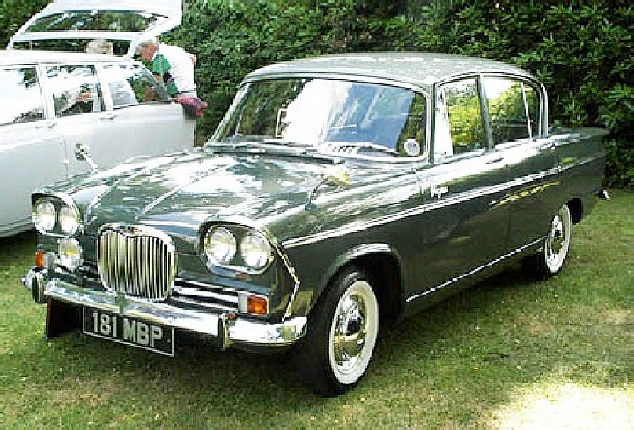
This is Peter Houghton’s immaculate 1963 Vogue Series 2 seen at the BEN rally, Lynwood, near Ascot. This car is in original condition and has never been restored. Not surprisingly it has won many awards.
Vogue Estate
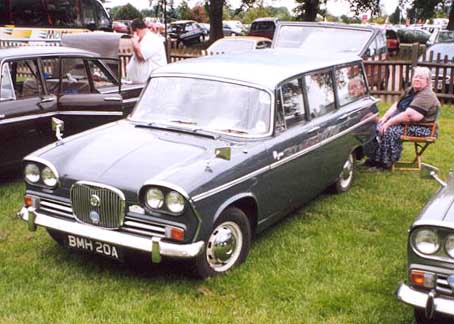
This is Brian Moreton’s 1963 Vogue Estate. The load floor makes an ideal picnic table as can be gathered from this picture taken at the Bressingham Steam Museum.
Mark II Vogue Saloon
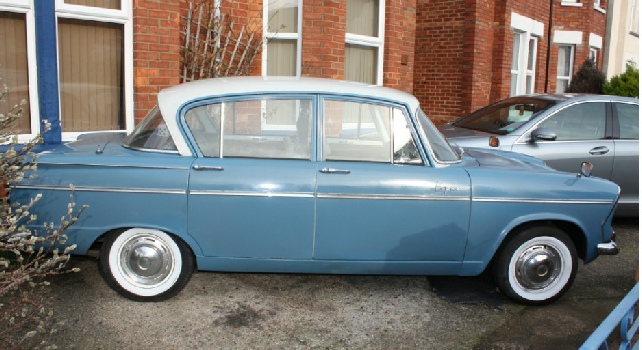
This is John Cook’s 1964 MK ll Vogue, which he has bought as a restoration project. It has 98,500 miles on the clock, and there have been three previous owners – The first was John Thomas Renham, who purchased it on 07 April 1965, followed by Brian Cooper, who bought it on 21 January 2000. Third was Martin Foot, who acquired it on 6 September 2012, the car finally coming into John’s possession on 11 February 2017.
John says its condition now is pretty bad and that it has had some very poor attention. But it has that heart of gold feeling, and John plans to spend as much time and money as is necessary to restore it to a running project.
John says the photos make it look quite reasonable, but whilst they say the camera never lies, it is a big job, although it did come with a current MOT which he will try to keep up.
John tells us he has already attended the New Forest branch ‘Noggin & Natter’ meeting, and found they all have a wealth of knowledge and are a great bunch, and that he is looking forward to the future!
We wish him good luck with his project, and look forward to meeting him and seeing the results of his labours.
John has now created his own website – singervogue.co.uk on the progress of his ‘sympathetic’ restoration, with a diary detailing the work done and a gallery of pictures taken en route.
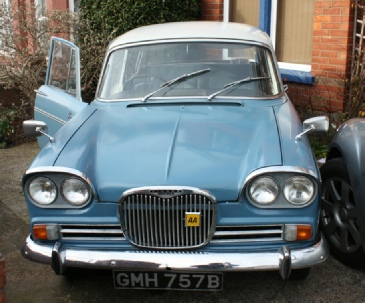
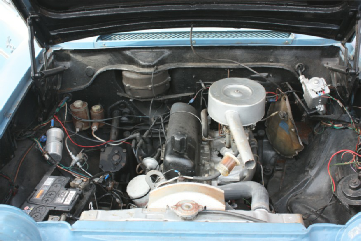
Series VI Gazelle
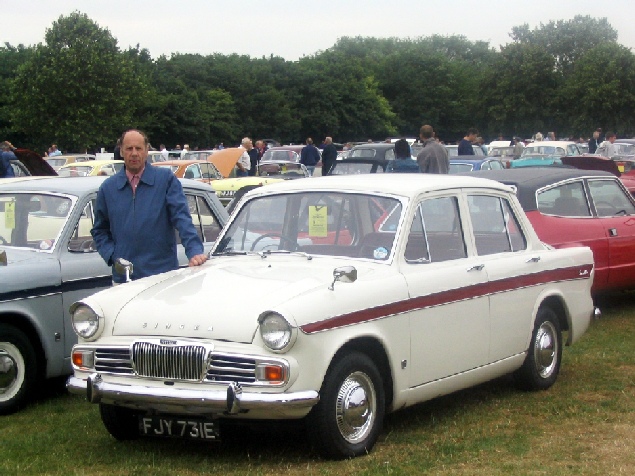
This is Brian Hauxwell’s superb 1967 Series VI Gazelle
When Brian collected it from ‘Up North’ he said it drove very well, although he was a little apprehensive about driving an unknown, 38 year old car 170 miles down the M1. He needn’t have worried, as the car did the journey faultlessly in just four hours. Of course it did – it’s a Singer.
The picture was taken at the Bromley Show in 2005.
Gazelle Series V
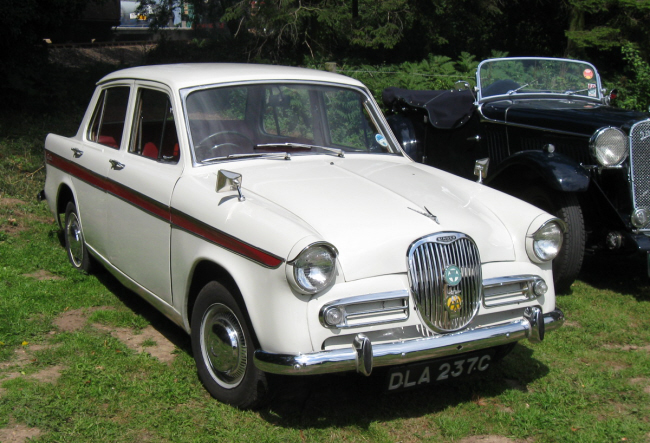
This is Paul Stinton’s 1965 Gazelle Series V. Paul tells us she does need a bit of cosmetic work, but on the whole is quite a nice car and in fairly good condition.
Paul purchased DLA 237C having seen it advertised on the Car and Classic website, when it reminded him of the very first car he had when he passed his test in 1975, which was also a Series V Gazelle. Unfortunately that one didn’t stand the test of time, so for him it was a nostalgia purchase, and he says that it’s putting a great smile on his face.
When he went to pick it up he took his two girls,
The only differences between Betty and his first Singer are that that particular car had the larger 1725 cc engine and the uprated dash, so it must have been one of the last in production, as it was registered in 1966.
Gina and Megan, with him, and although Gina was a bit concerned about the lack of seat belts in the rear, she thought it was great fun. Incidentally, they have decided to call the car Betty, after Betty Boop’s surprised expression, which they think is rather amusing looking at the shape of the grill.

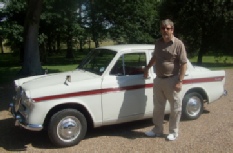
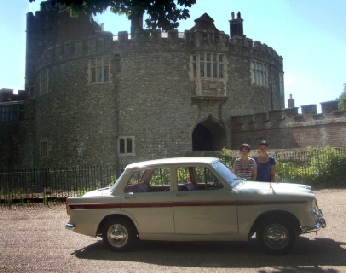
Paul also sent these pictures of Betty taken at Walmer Castle, home to the Lord of the Cinque ports
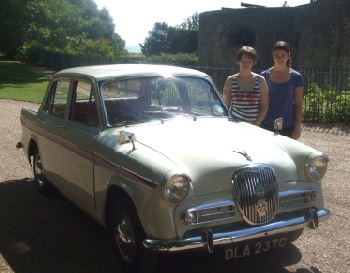
Series V Gazelle
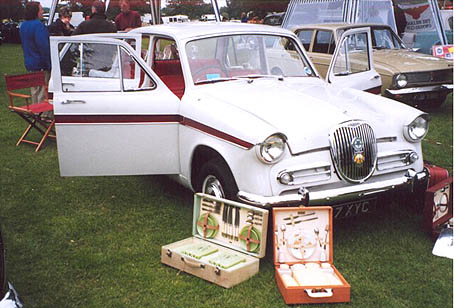
This is Richard Harris’ immaculate 1964 Series V Gazelle with equally immaculate picnic sets and other trimmings. The car won the Gazelle Bowl at the SNCR Rally at Newby Hall, Ripon.
Gazelle Series VI
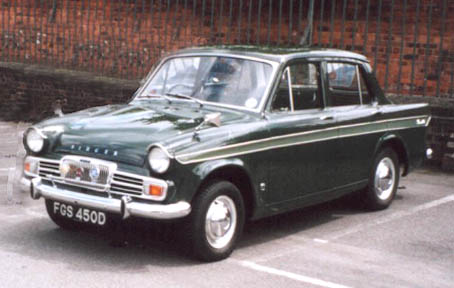
This is William Laughlin’s Fabulous green Singer 1966 Gazelle Series VI, complete with ‘personalised’ Singer number plate, pictured here outside the National Railway Museum in York, which was the starting point for ASCO’s National Rally. At the SNCR in Newby Hall, Ripon, William’s car was joint winner of the Gazelle trophy. William had driven over from Northern Ireland specially for this event.
Gazelle Series V
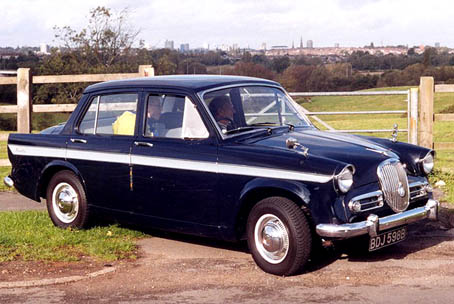
This is Gary Lewis’ 1964 Gazelle Series V seen here parked at the Midland Air Museum, Baginton, Coventry. Gary parked the car with Coventry’s famous Three Spires in the background, having seen their embossed depiction on the steering wheel and boot lid of his car!
Gazelle Series IIIB Convertible
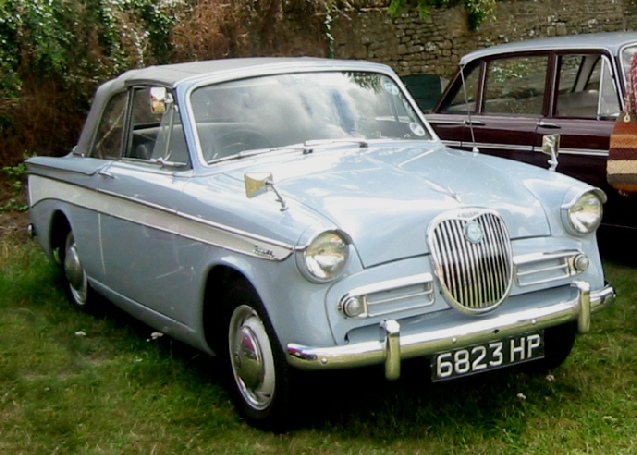
This immaculate 1960 Series lllB Gazelle Convertible, seen here at the 2010 SNCR in Laycock, Wiltshire, used to belong to Nick Warren, but he sold the car in mid 2013 and we don’t know who the lucky new owner is.
Nick had a complete history file on the car – it was an ex- Rootes Company car for the wife of the Humber Director.
Gazelle IIIC Convertible
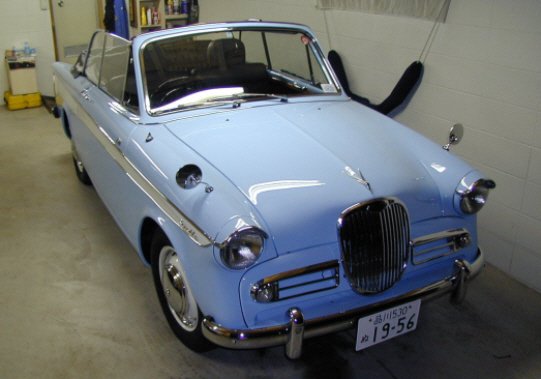
This is Yauhiko Shimusaki’s beautiful 1962 Series IIIC Gazelle Convertible, which he bought through friends in England and then had exported to Japan to celebrate their golden wedding anniversary on November 5th 2006.
Yasuhiko says: “Looking back over the fifty years, one of my many memories was the blue & white Singer Gazelle convertible we owned half a century ago. This was not particularly a luxury car, but it was definitely a vast luxury for us at the time. This was, after all, little over a decade after Japan had been resoundingly devastated and defeated in the war.
The nation was still getting back on its feet, the rapid-growth 60s were still just a gleam in peoples eyes, and not many families had cars. So we caught a lot of envious flack for owning it, but we enjoyed it immensely. We would put the top down and drive around, two youngsters out for a lark. The country roads were mostly gravel and bumpy, but we still had many hours of happy motoring.
Approaching the big five-oh, I wanted to do something special to commemorate the occasion. And what could be better than to get another Singer Gazelle like the one we used to have? So since this is a British car, I turned next to some friends in the Astin Martin Owners Club, and they found for me this red and white 1962 Singer Gazelle Series 111 convertible. We were elated. After extensive email correspondence getting first, second & third opinions, getting answers to seemingly endless questions, and even getting a friend to test drive the car and report back, we finally decided it had sufficient sentimental value to be worth buying, and wired the money. We had the soft top repaired in England and while that was going on made the arrangements to ship the car to Japan. Once it got here, we unwrapped it and played excitedly with our new toy, and I am currently having a ball working on restoring it”.
Yasuhiko has now completed the restoration from the red car to the beautiful pale blue replica of his first Gazelle. Below is a picture of the car as imported, plus some pictures of progress through the restoration process.
Gazelle IIIB Saloon
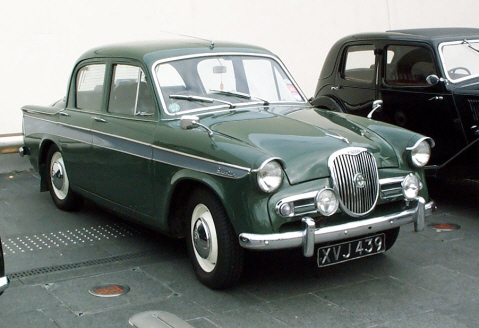
This is Roy Patten’s very clean 1961 Series IIIB Gazelle saloon, which he bought in Winchester and drove home to Cheshire with no problems at all. This picture was taken in the Millennium Place in Coventry, where it was part of the West Midlands Vehicle Preservation Society display at the Coventry Historical Society Festival.
The car is in very good condition, although Roy tells me it needs a little work on the body, including some on the underside, plus a bit of tidying up on the upholstery and some new carpet for the centre of the floor. However, its engine has been rebuilt, it has a new radiator, new exhaust system, a fairly new heater system and new tyres. Roy thinks it has also had a new propshaft at some time.
The original handbook came with the car, and Roy has managed to get hold of a 1960s Workshop Manual, which he is very pleased with.
Singer Vogue MK III

This is the story of the SINGER VOGUE Mk III, owned by Ivan Nedelev of the Plovdiv Automobile Club Retro in Bulgaria. Ivan tells us:
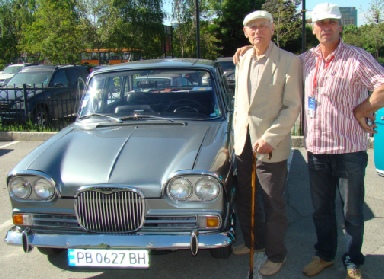
The history of the car started back in 1965. Before me it was owned by my grandfather’s brothers. This is the only Vogue Mk III in Bulgaria. The first owner bought the car on 09.01.1965 from the Rootes Group factory in Coventry, England (the invoice is still available). The car was designed with a left-hand drive. This model is the third of the Vogue series (Singer Vogue Mk III), with a total of 10,000 copies manufactured from 1964 to 1965. The car was driven to Bulgaria under its own power and registered there in August 1966. During all the years up to 1974, the car was kept in a perfect condition due to its daily use. After 1974 it experienced serious engine failure because of the systemic use of substandard fuel, and an overhaul was required. In those years this was a difficult task due to the lack of even the most basic spare parts, especially those needed to repair the engine. Nevertheless, the repair was completed thanks to the technical skills of the owner, whereby cylinder liners were fitted, pistons were cast, segments and bearings were adapted. Consequently, technical solutions were found for each mechanical failure
At the same time, all original parts were preserved and were subsequently restored and reinstalled. Just a year before 2004 the car was out of operation. It was carefully covered with tarpaulin and installed on raised logs. The chrome elements were preserved and oil was poured in the cylinders. Restoration began in September 2004.
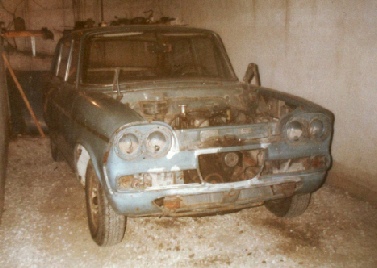
We started a gradual disassembly, making a full inventory of every bolt and part. The process was facilitated by the presence of the complete set of the repair documentation, specifications of spare parts and operating instructions. At the same time we started looking for information on any available original spare parts to maximize the effect of the restoration. We resolved the rubber seal problem, an issue faced by every restorer, only in part, by managing to locate just the windshield seal in the original, which was completely destroyed and it took one full year until we found a replacement in the autumn of 2006. The rear window seal was kept in perfect condition thanks to its specific design. We have yet to find replacements for the front and rear quarter windows. We resolved the problems which occurred during the restoration of most of the chrome parts by buying the most distinctive of the original chrome elements from ebay.co.uk. Thus we managed to replace all the engraved side strips, the unique chrome hubcaps and wheel rings, the very difficult to find and restore front grille, as well as most turn signals and chrome-plated lights. The long hours spent in e-bay allowed us to obtain original reversing lamps and the missing rear emblem. Some of the valuable items bought on e-bay are still in the process of restoration and installation (original radio and Smiths clock). The headlights are in a very good state and despite the available replacements (also bought on e-bay), we have not changed them. We were surprised to find working original Lucas lamps while dismantling the lighting system. All dashboard and electrical installation devices work flawlessly and did not need restoration, except for the starter (Lucas inertia starter). A structural disadvantage of this type of starter causes frequent failure of the inertia mechanism, which requires very precise tuning. This was fully repaired (collector, brushes, stator winding and bushings).
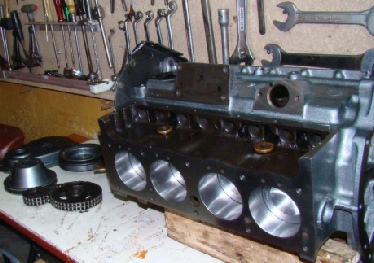
The next stages of the restoration took place a year later (after the car was already in operation and had taken part in several retro races, testing its performance) and, naturally, they were related with the operation of the engine and braking system. We had already found one Dutch website for ordering a wide range of spare parts for Rootes Group vehicles, and we decided to do a complete overhaul of the engine, including fitting new, standard-size cylinder liners, replacing pistons, segments, main and rod end bearings, camshaft bearings, valves, timing chain and timing gears, as well as replacement of all gaskets. We performed a thorough check of the carburettor by replacing some of its elements. The distributor, all brake and clutch cylinders were also replaced.
8000 km after the overhaul (now), several car races and long-distance rides, we can safely say that the car works perfectly. The car has won prizes and distinctions at each race and exhibition, but so far only in Bulgaria.
About me: Ivan Ivanov Nedelev, DOB 21/06/79. Ever since I was a child I have been a fan of cars and motorbikes. Restoring the Singer was one of my childhood dreams come true. Apart from this I am also a fan of vintage guitars. I have been interested in music since I was 17 and I have managed to collect some unique guitars. For 14 years I play the guitar in my band, the FREE STYLE (www.myspace.com/bgfreestyle).
The Singer automobile inspired the production of one of the band’s videos. For the last three years I have been a member and organizer of the Plovdiv Automobile Club Retro.
Vogue Series III Automatic
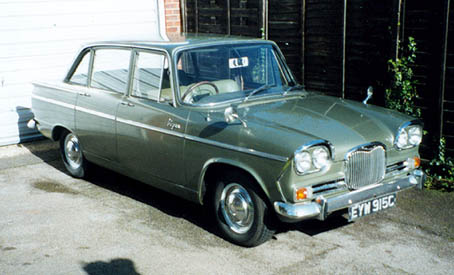
This is John McGrath’s 1965 Series III Vogue Automatic, which previously belonged to SMC Editor Mike Hyman. John also has a 1962 Series II Vogue.
Series IV Vogue Saloon
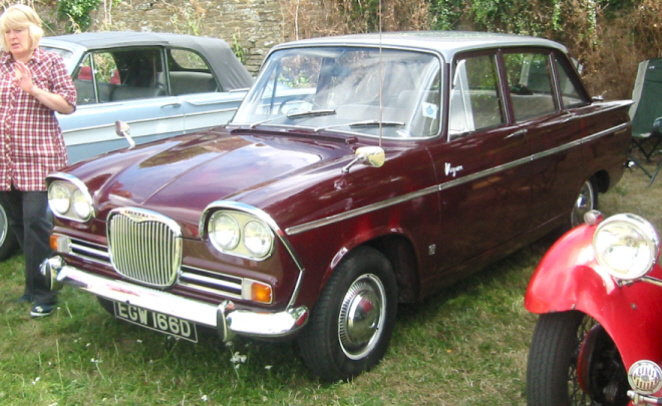
This is Alan and Val Carter’s beautifully renovated 1966 Series lV Vogue Saloon, seen here at the 2010 ASCO SNCR at Lacock in Wiltshire.
Alan and Val purchased the car in October 2009, it just having had a reconditioned engine after lying in a field for two years. The paintwork was blistered, the woodwork inside was in very bad condition and the black plastic facia split through exposure to the sun.
The bodywork being in very good condition, we therefore, over the winter, had a complete respray, Liz Heyer reconditioned all the woodwork, and an upholsterer put a leather facia and new head lining in. The work was completed a few days before taking part in the Dutch Lustrum in the Arnhem area of Holland in May 2010.
Vogue Estate IV – 1725cc
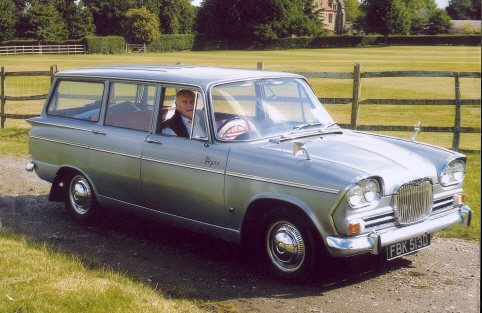
This is Alan and Val Carter’s superb 1966 Series IV Vogue Estate 1725 cc , seen here arriving at Stoneleigh Abbey for the Singer Centenary celebrations in August 2005.
Alan had bought the car only the previous month – it was basically sound, but in need of some TLC and a paint job. It has now had a respray, new carpets and a general tidy up, since when it has been on the Geseke Rally in Germany, won the Vogue Trophy at the SNCR in Norfolk, taken part in the Granville Rally in France, and several other local rallies. Alan is now in the process of fitting an overdrive gearbox.
Vogue Series IV
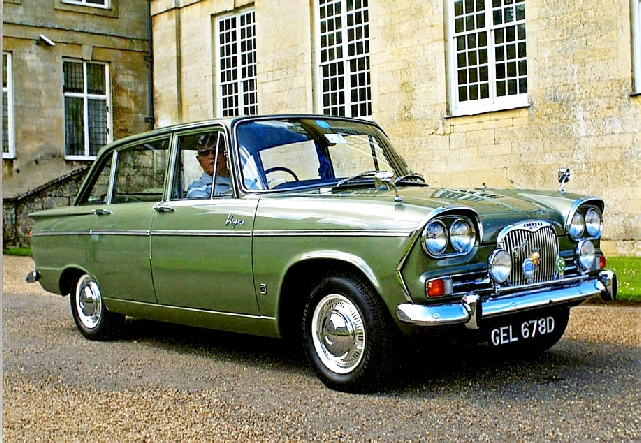
This is Brian Rich’s 1966 Vogue Mk IV. The vehicle was supplied new to Brian’s father and the keys were passed on in 1987. Apart from those components replaced under normal maintenance, a cosmetic respray in 1995, some tidying up in the engine bay and some re-chroming, the car is original, with a mileage of less than 54,000. A glimpse under the bonnet shows just how tidy it is. But no, that isn’t a tray from which to eat your picnic – it’s a heat shield to protect the carburetter from exhaust heat and reduce the possibility of vaporisation.
In addition to taking part in Road Runs and raising money for charity, the car appears at a number of local shows and events, where it attracts much attention because it is something different. The car has also takem part in a number of National Rallies.
The Vogue will stay in the family – son Nick also shares a keen interest.
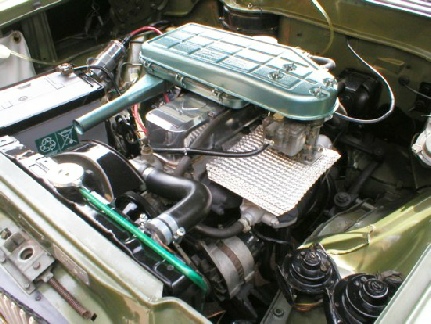
Vogue Estate

This is Jim Edington’s 1966 Vogue Estate
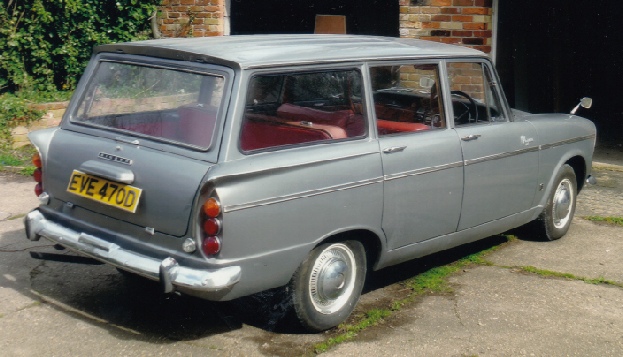
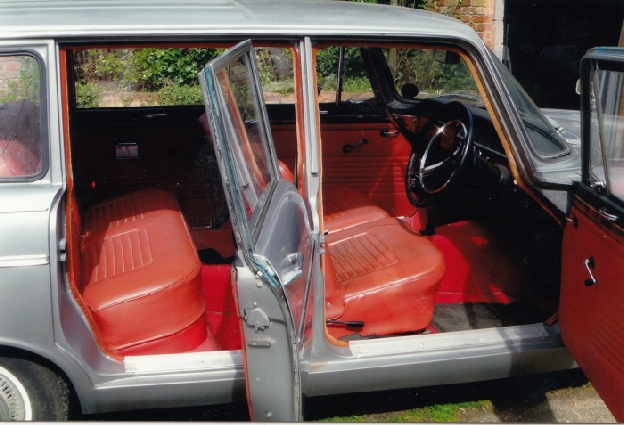
Arrows Vogue Estate
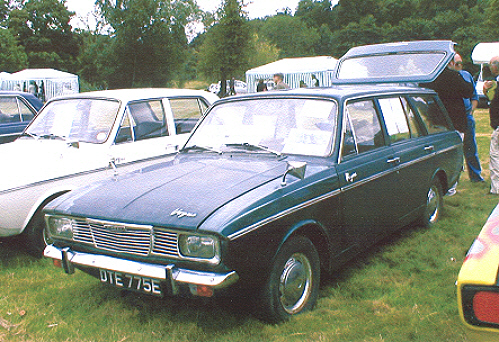
This is Andrew McAdam’s 1967 Arrows Vogue Estate – DTE 775E
It is the earliest known surviving Vogue Arrows Estate. The original supplying dealer was Tarleton Engineering Co. Ltd, Liverpool Road, Tarleton. The car was delivered on 13 June 1967 to Mr Alfred T Thewlis from Liverpool. On 10 March 2002 Mr Thewlis sold the car to his son, Richard (who lives in Cambridge), and he subsequently put it through an auction near Cambridge in May of that year, the mileage by this time being only 68,267. The car attracted no bids at the auction, but a keen young enthusiast – Robert Kruger of Royston, Herts – approached the auctioneers and made a nominal bid, which was accepted. Andrew supplied a number of parts and panels over the next year and was pleased to hear it had been saved from the scrap man. At the beginning of August he had a phone call from Robert offering him the car, as he was moving to Cumbria and couldn’t take it with him. He collected the car on Monday 8 August – just 6 days before the Centenery Rally, where this picture was taken. The mileage then was 74,316. The car will be restored to her former glory over the coming year. It is a very practical classic, known affectionately as ‘The Hearse Mk 2’ on account of her ‘boxy’ looks and dark green coachwork – and it does have an exceptionally large load carrying area that would put some modern estate cars to shame!
Arrows Vogue Estate
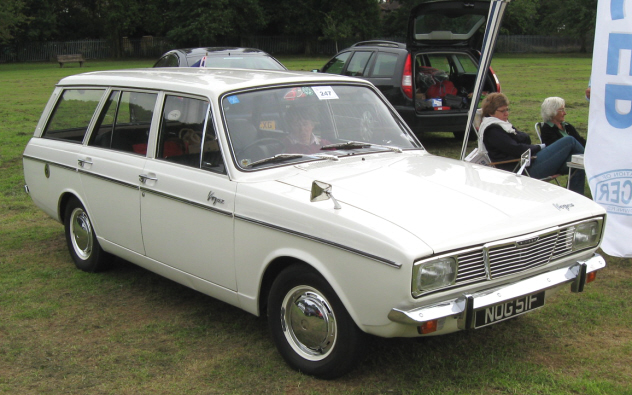
This is Rodney Cane’s 1968 Singer Vogue Estate (Arrows model).
Rodney tells us: “It is manual + overdrive, reg NOG 51F, in Alpine White, with a (genuine) mileage of 40,985.
It is the top of the range of one of the last Singers to be produced, and, being an estate produced only from 1967 – 1970, quite rare – particularly in this condition.
It replaces a 1968 Saloon Auto that I have since sold. My interest was in vehicles produced whilst I worked at Humber, Rootes, Chrysler, Talbot, Peugeot from 1967 – 1998.
In 1976 I visited Iran where the Peykan was assembled. I must have had 35 – 40 different cars in the Rootes Management Role Car scheme since 1970, and went on my honeymoon to Cornwall in 1973 in a Hunter Estate.
As to the car’s history, it was supplied new by Vaughan Motors (1941) Ltd, Sheldon, Birmingham, to Mr Hickling of Shenstone. He later retired to Upton, Dulverton and kept it until he died in 2001. His widow sold it to Thomfalcon Car Sales in Taunton, whose workshop, Hatch Beauchamp Garage, put two new front wings on and resprayed it. I imagine they may well also have put some sills on it – I was told that at one stage it was in a poor state. Thomfalcon sold it to Arthur Tyle of Knowle, Bristol, who, I understand, needed to raise some cash for medical purposes, so he sold it back to Thomfalcon, from whom I bought it in September 2006 as a bit of nostalgia from my working life.
All I have had to do to it is clutch master & slave cylinders. a bit of welding in a rear inner wheel arch and fit two new front tyres.
‘Arrows’ Vogue Estate
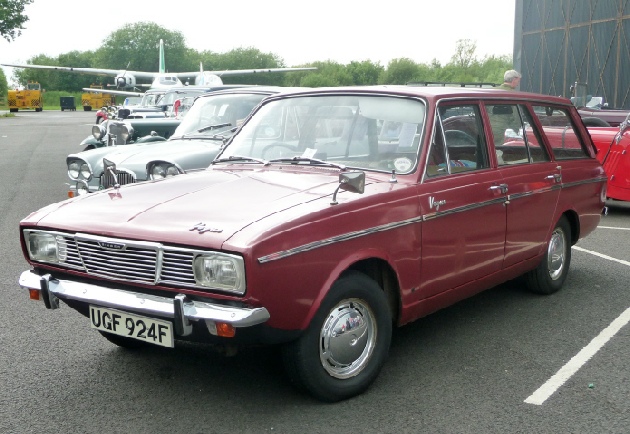
This is the late Michael Gardner’s 1968 Vogue Estate –
now tended by his wife Margaret
Mike said that having decided they needed an estate car as a back-up vehicle for his ‘9’ Sports, a Mark IV Vogue Estate would seem to meet his requirements. But as usual there were none to be found. Six months later, whilst having a drive with John Payne, he mentioned he had been asked for advice on selling a Singer estate car. But it was an Arrows model – problem? A week later they met at Crowthorne.
Mike was introduced to Malcolm MacDonald, who took them into his back garden, where, under some pine trees, was an estate car on blocks, covered with a tarpaulin. A detailed inspection showed the car to be in good condition, with only two small rust spots, and after a short discussion we agreed a price. How to get the car home? He was persuaded by his associate Richard Heaton (Super ‘9’ Saloon, 1937) that trying to drive it home with seized brakes and no tax or insurance, was not a good idea. A mutual friend ‘Jim’ had a 4 x 4 with a four wheeled trailer, and for a reasonable sum was available the following Saturday. Early Saturday morning, he and Richard set out for Crowthorne, complete with two trolley jacks, support plates, boxes of tools and the proverbial kitchen sink, in anticipation of a full day’s work. When they arrived they found that Malcolm had lowered the car from the blocks and removed an access panel in his garden fence to enable removal. Three pushes backwards and forward aligned the car, and with a long tow rope they pulled it out onto the road. All within 45 minutes of their arrival, which left them twiddling their thumbs waiting for Jim and the trailer to arrive.
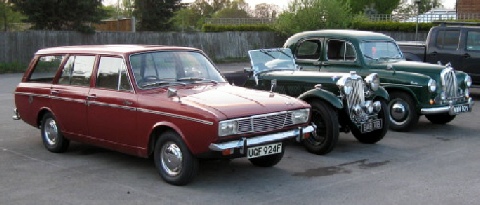
Whilst they were waiting, Malcolm asked Mike if he would like the spares he had for the car. These consisted of two cylinder heads, an inlet/exhaust manifold, alternator, brake servo, exhaust system and lots more. Well it would be impolite to say no wouldn’t it?
After a shampoo and hoover, the car looked good, but it would not start.
Mike was advised to buy numerous spares to solve the problem. Two days later he found the needle valve in the float chamber was blocked, and when cleared the engine started. Memo – don’t buy spares until you know the problem! With the help of some good friends, the brakes were rebuilt, the electrical wiring sorted and new brushes fitted to the alternator – and everything worked. Not bad for a car that had been standing outside for 18 years. The interior trim and seats are covered in very up-market ”Ambilair” soft vinyl, and a gentle scrubbing with ‘Swarfega’ brought these back to pristine condition, with no signs of wear or damage. Time for an MOT attempt. The main comment from the inspection pit of his friendly test station was: “Am I inspecting the car or the cobwebs?” The car passed first time with only two small advisory points.
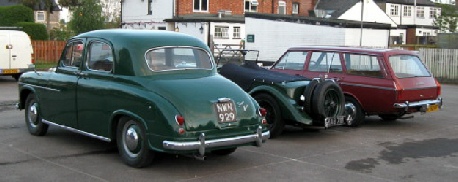
With the car now legal, Richard and Mike set off on its first test run – to the May meeting of the Thames Valley Singer Owners Group at the White Hart, near Maidenhead, where these pictures were taken. The return journey of some 60 miles proved the car to be very comfortable and powerful, the only problem being the headlights were set too high. A few minutes tinkering in the pub car park soon sorted that.
By this time even Margaret was impressed, and insisted they use the car to go to the Singer National Weekend in York, a 400 mile return trip. Normally she would drive their modern car as a back-up for their 1933 Nine Sports.
Loaded with luggage and spares for sale, they set off for York. This proved to be a very pleasant drive, but the carburettor was off tune, which limited the top speed to 55 mph, although they still managed the journey in 4½ hours. A very enjoyable five days were spent in the York area, (see main picture), with the car proving reliable and water proof, despite several heavy rain storms and flooded roads. After some ‘tinkering’ with the carburettor by fellow club members, the car ran better on the way home – they were even able to overtake lorries on the motorway!
Chamois Mk 2
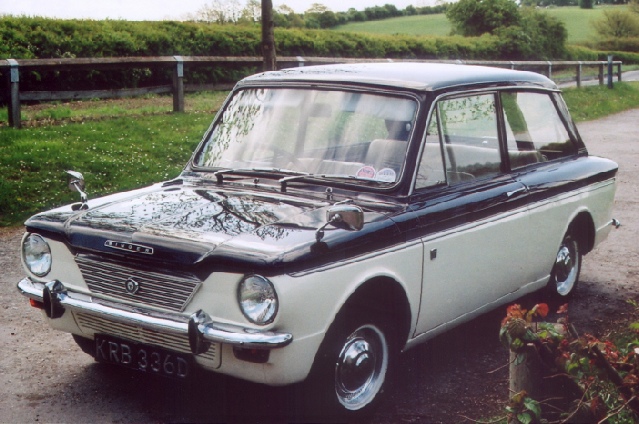
This is Colin Eagle’s 1966 Chamois MK 2, which he bought from Peter Rogers Car Sales near Huddersfield. Colin had wanted a Singer ever since he saw a 1960s Gazelle, which he always thought were the best looking cars one the road – and still does. But it was too big for his garage and he didn’t like the front bench seat. He liked the Chamois because it was two-tone, but the price was way over what it should have been, and although Colin pointed out that it had rust in places, the paintwork was not as good as it should have been and one of the seats had a broken spring sticking out at the back, the dealer would not come down – said Colin was being fussy! But he bought it anyway!
The Chamois was first registered on 18 March 1966 in Ripley, Derbyshire. She was all black in those days – which cost extra. From the bills and MoTs he has, Colin knows the mileage was a genuine 59700. He has had a lot of troubles with the car, the main one being when the engine seized due to a coolant leak just before he was due to set off for the ASCO weekend at Lacock. The engine has now been reconditioned and all appears to be well, so Colin is now looking forward to the SNCR weekend in Norfolk in July.
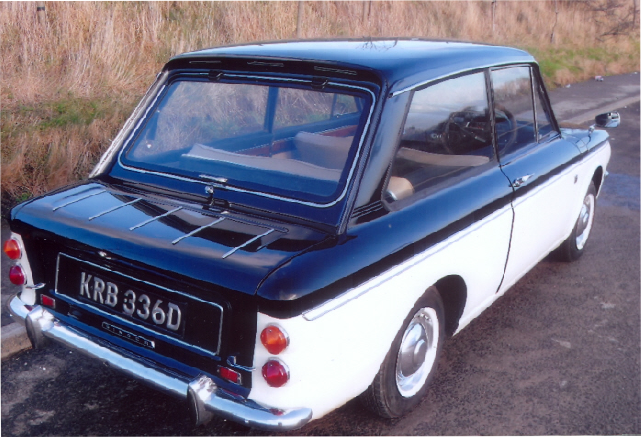
Chamois Sport
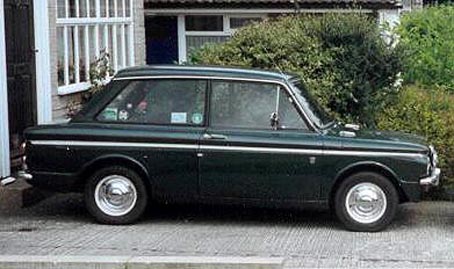
This is Graham Smith’s 1966 Chamois Sport. Graham bought it in 1990 to add to the Roadster he already had, but by then it had a standard 975cc engine which reduces the performance somewhat, although the car still benefits from other Sport features such as servo-assisted brakes.
Mark V (Arrow) Vogue
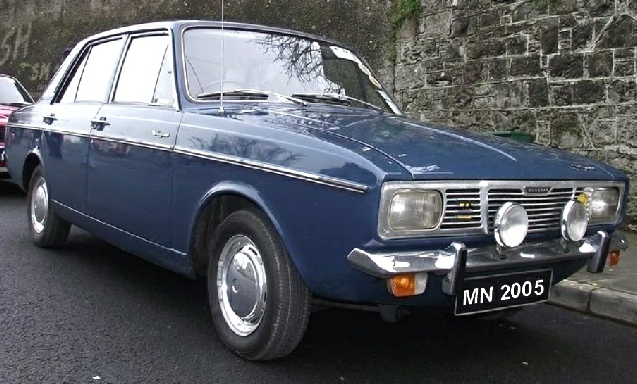
This is Nigel Hughes’ 1970 Mark V (Arrow) Vogue. This was the very last Singer ever built, and it rolled off the line at Rootes’ Ryton plant on 28 March 1970.
Its journey along the assembly line was witnessed by Brian Swann, the ex-SOC Gazelle and Vogue Registrar, and it was he who told Nigel it was for sale in the summer of 1979.
Unfortunately it is in poor condition, but Nigel says he will get round to restoring it one day!
Arrows Gazelle
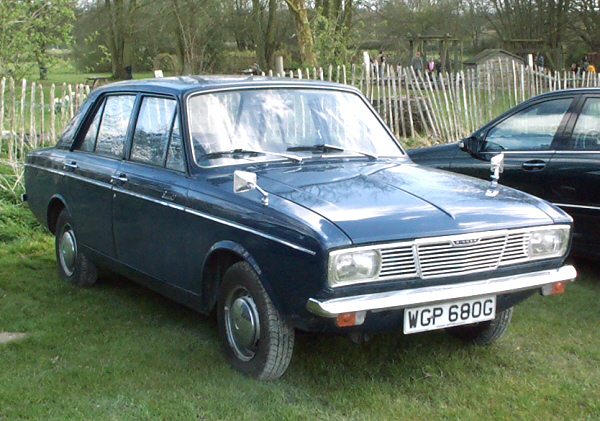
This is a rare 1968 Arrows Gazelle seen at the Bentley Museum and Wildfowl Reserve near Lewes in Sussex when it was owned by Roland Foster. Roland now has a 1966 Series V Gazelle
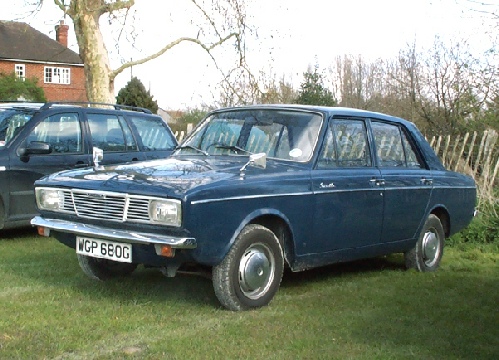
HRG 1500

This is Barry Paine’s 1948 HRG 1500 at three very different stages of its career.
The picture below marks a low point in its life in a Northumberland scrap-yard in the 1980s, and above is the car as it is now, in Barry’s back garden, having been rebuilt as a traditional square rigger. Most of the work to save the car from its derelict state was carried out by the late Brian Lovell of Playden, East Sussex, to whom much credit needs to be attributed.
Barry is very pleased that, with the kind assistance of the HRG Association, he has managed to have the original registration number re-allocated by DVLA Swansea.
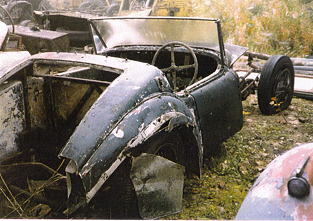
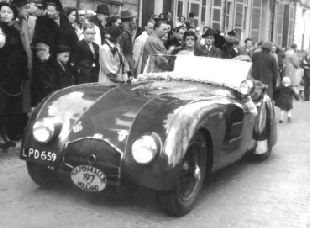
The above picture shows the car in its heyday, in aero-dynamic form, taking part in the Tulip Rally in the Netherlands in 1950 driven by Robert Holroyd.
Bantam Saloon
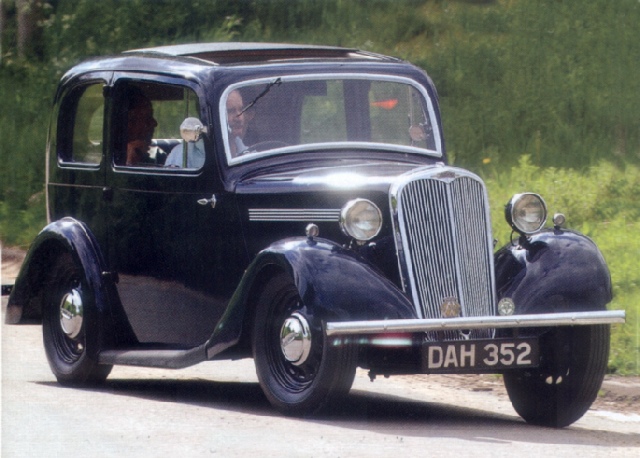
This is Charles Sumser-Lupson’s beautifully restored 1939 Bantam. In July 2005 the car featured in the magazine ‘Classics Monthly, and below is a brief summary and some more pictures from the feature article.
It was 1969, and Norwich engineer Charles was looking for an old car as the basis for his hot-rod project, when he saw a Singer Bantam just down the road, and thought it would do nicely. The owner was going to cut it up for scrap and wanted only a fiver for it. Charles could raise only half this from the pocket of his flared trousers, so it was his girl friend Jenny who stepped in with the other £2.10s. Like so many projects, however, life got in the way, and the Singer got no further than being partially stripped down. The car languished in a garage and then a lock-up for some 20 years, and Charles began to give serious thought to selling it. Jenny, however, didn’t want to lose her investment, so she offered £2.50 to buy out Charles half of the car. By the end of the 1990s the Singer had become a very rare car indeed, and at last Charles took the decision to restore it, not as a hot-rod, but as close to the original as possible. So he and his friend David Long set about locating all the bits stripped off all those years ago, taking copious photos as the rest of the car was dismantled. The main problem was that the engine block was badly cracked. But Charles hit on the idea of joining ASCO, and sure enough a contact in the club found them a complete engine that was sound, albeit in need of reconditioning.
The wings and some of the body panels were like pepper-pots when they were bead-blasted, but these were all welded up, the body was repainted in as close to the original colour as could be found, and the car was completely re-trimmed and reupholstered.
All the hard work was finally rewarded when DAH 352 won best pre-war car at the 2004 Singer national day.
David Long has set up a website with lots of pictures taken during the search for bits and the restoration process. CLICK HERE to go to his site. The site also includes pictures of ASCO’s recent Singer National Car Rally weekend in North Norfolk.
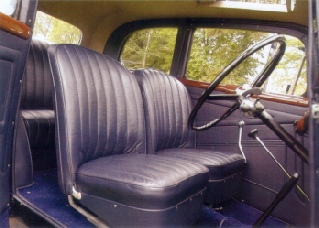
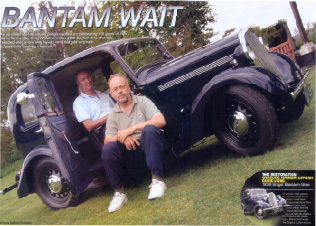
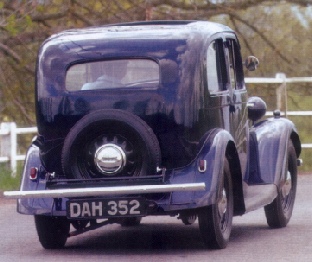
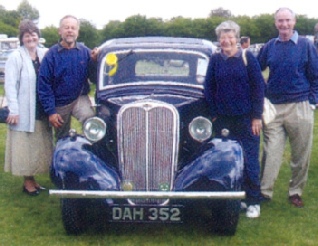
Le Mans Long-Tail
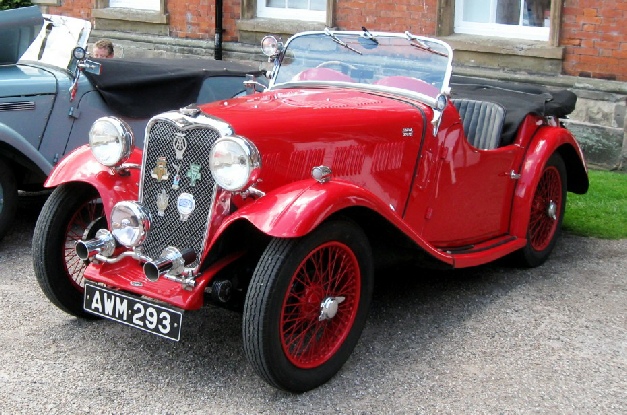
This is Ian Sandham’s superb 1935 Le Mans Long-Tail. The car was manufactured in 1935 and has Body Number C149 and Car Number 65252, but the engine is not the the original.
During February, March and April 2008 Ian scoured the motoring press and ebay for a pre-war sports car. Finally he found just what he was looking for – Dave Roberts of the Bell Inn Benington, Herts, was selling his 1935 Singer Le Mans on ebay. Dave had purchased the car from his cousin, who had stored it in a barn in East Coker, Somerset, for several years. Not surprisingly, the car was in ‘barn find’ condition and needed total restoration. It had arrived at Dave’s house in 1982 on a trailer, the bigger parts being tied on and the rest nestling in boxes. The car was about 95% complete. Dave spent some time sorting the boxes and parts before sending the the lot to Trevor Cornelius in 2002. Trevor set to work and in 2003 the car was completely restored and back on the road.
At some point in the car’s life it was supplied by Denmead Motors Hambledon Road, Denmead, Hampshire, and a plaque on the dashboard gives proof to this. The garage has now gone, and flats occupy the site. Ironically, Ian’s brother lives just 60 yards away.
Since buying he car from Dave, Ian has done very little to the bodywork, apart from cleaning it. The hood needed to be modified and Ian had side screens made, which were certainly needed. Dave Roberts had chosen the red paintwork, but Ian believes the original colour was dark blue. The engine that came with the car was a ‘bentwire crankshaft’ model. The shaft was new in 2006, the previous one having broken, and the block had an Ian Blackburn repair plate bolted to the side. This engine ran very well but Ian was concerned about potential failure in one form or another. So in 2010 he purchased a reconditioned speed block, and persuaded Dave Hardwick to sell him one of the new heads he had had manufactured, and it is this engine which is now in the car.
Ian says the gearbox is getting noisy now, and new bearings are on the menu this winter. He has already had a new propshaft made, so long winter nights and darker days will find him cocooned in the garage getting her ready for the first rays of spring sunshine.
Le Mans Sports Special Speed 2 seater
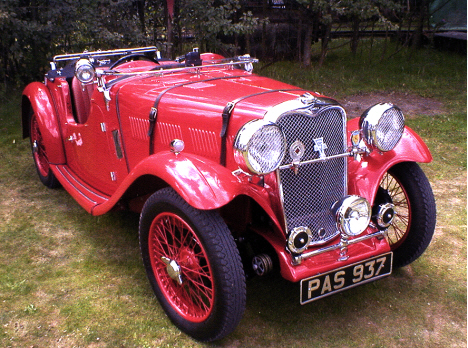
This is Bob Francis’ immaculate 1935 Le Mans Sports Special Speed 2-seater seen here in 2003 at the Singer National Rally at the Rural Life Centre at Tilford near Farnham, where not surprisingly it won the Mrs Johnson Memorial cup in the class for the best Le Mans and Sports 1933-37. Not only does it look good, but Bob had driven it from the Wirral with no problems.
4AB Roadster
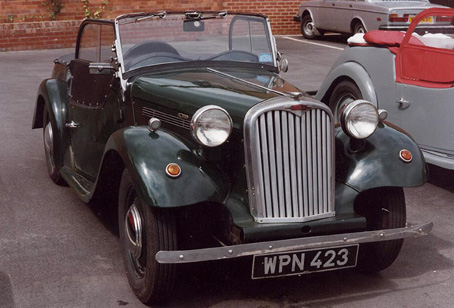
This is the late Bill Haverly’s 1951 4AB Roadster which he bought in 1971 in poor condition with seized brakes, a frost damaged block and several rogue parts. Bill eventually found a spare engine and four years passed before a painstakenly restored, roadworthy and near original Roadster made a historic trip to the Singer centenary celebrations in Coventry. he car is still in regular use and now lives in the North Lincolnshire area, having been sold at auction.
4AD Roadster
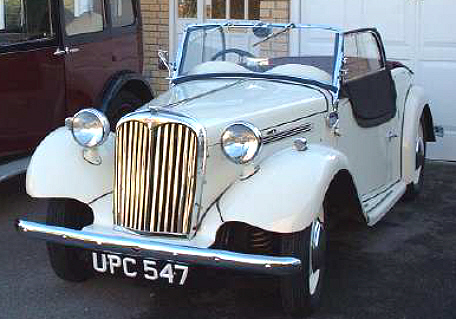
This is Allan and Cathy Jones’ 1954 4AD Roadster. Allan bought the car from Roadster registrar Bill Haverly in the mid 90s. It was a complete basket case and needed a full body-off restoration.
His good friend Ken Mellor, who had helped with Allan’s 1932 Junior restoration, came in to help once again. The aluminium skin had to be removed and repaired. Probably 90% of the wooden frame had to be remade and a lot of the metal panels.
Again, Allan painted the car in his driveway, and had it retrimmed and re-chromed etc. Bill Haverly was also a great help with supply of remanufactured parts, other spares, and much technical advice. Allan and Cathy have taken the car to many parts of the country, including Yorkshire for the ASCO National Rally in 2007.
Hunter
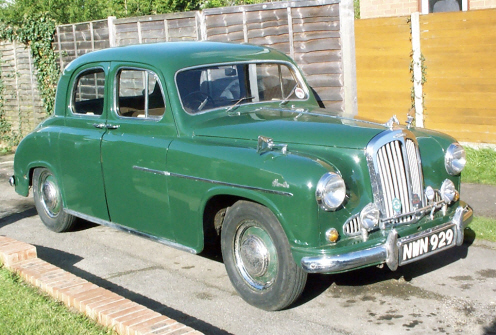
This is Selwyn, Mike Hyman’s 1956 Hunter. Selwyn had lived in Swansea for most of his life and was suffering from sea-salt corrosion, which had devoured most of his rear body mountings. These have now all been rebuilt and Selwyn took Mike and Trish to the Centenary Celebrations in Coventry in2005, and to France on the Granville Rally in 2006. In 2007 Selwyn went to Harrogate and the SNCR at Newby Hall, and in 2008 arrived at the SNCR in Fort Nelson just in time to be awarded the Talbot-Rootes Cup.
SMX Roadster
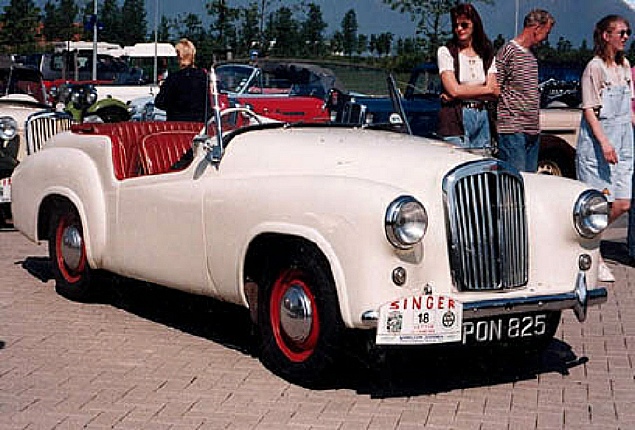
This is Ashley Crossland’s 1954 SMX Roadster, the only known survivor of five prototypes. This one was prototype no. 2 .
The car has a fibreglass body and is built on a Roadster 4AD chassis with an SM1500 engine. Ashley acquired the car in 2016 – this picture was taken on the Dutch Lustrum Rally in 1995.
Previous owner, the late Bill Haverly said: “When is a Roadster not a Roadster? Singer’s answer to this little riddle was “When it’s an SMX”. And to prove the point they made the first of these prototype fibreglass bodied cars for display at the 1953 Motor Show.
Having been in production since 1939, the traditionally styled Roadster was showing its age, and a replacement was needed if the ailing company was to survive.
The Hunter saloon car was on the drawing board, and experimental GRP body panels were to be incorporated in some cars. Why not take these developments a stage further and make Britain’s first glass fibre bodied car? The new convertible would be based on the SM Roadster’s rolling chassis, so protocol demanded it retain the old name. In reality, its lines clearly show that, had it reached the production stage, there would be no mistaking it as a soft topped companion for the Hunter. But the market response to the new car was disappointing, and only a handful of SMX Roadsters ever left the factory, so the experiment was shelved.
This example, with right hand drive, was made in 1954 to further promotion, and was sold off in early 1955.”
Chamois
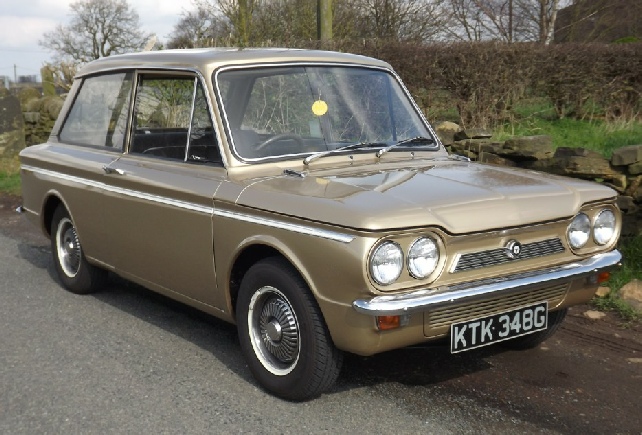
This is Graham Smith’s 1969 Chamois, which he purchased in March 2017 having been alerted by an ASCO e-Bulletin that it was for sale on the ‘Car and Classic’ website.
It is one of the now quite rare four-headlight Singer Chamois models introduced a year earlier, when a facelift was given to the Imp range. It had been lovingly restored by its previous owner Ian Ridewood, who acquired it in 2011 after it had been lying in a garage since 1992, when the original lady owner gave up driving, so we are the third owners of the car. It has done around 60,000 miles. Ian was kind enough to pass on all the documents that came to him with the car, including a full service and repair history dating back to its purchase when new, and its original sales brochure and handbook. It still has the original engine (it carries the same number as the car body), which bills show was reconditioned in the 1980s.
Its longest trip so far was to the ASCO National weekend in Northumberland, where it was rewarded at the SNCR at Bamburgh Castle by being awarded the President’s Trophy.
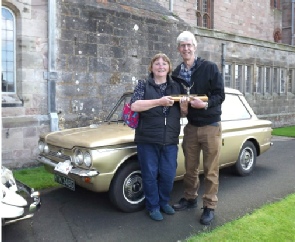
The picture is of Gill and myself with the Trophy, and, of course, the winner.
Vogue Mk I
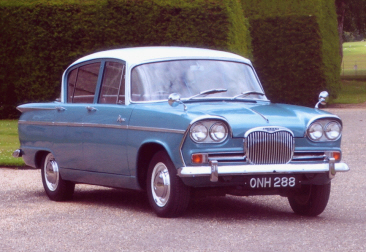
This is Paul Butler’s superb 1961 Vogue Mark l. Paul tells us:
“I always wanted a Singer Vogue, and as soon as I saw ONH 288 I fell in love with her. She was first registered in Northampton (Borough) on 24th August 1961, which was only about one month into production, so I guess she may be one of the earliest known survivors, having now been ‘In Vogue’ for over 50 years. I hadn’t realised just how rare she was until our editor asked if I could possibly help Eamonn Galligan by taking my Vogue to the SOC SND at Boughton Hall in June, for a photo-shoot to commemorate the 50th Anniversary of the Vogue, mine being the only roadworthy car of this year in the UK known to the Singer clubs. What a great day that was – the whole family went and we had a fantastic time. Now we’re looking forward to seeing the results, which I gather will be a 5-page spread in the Nov 2011 Classics.
I have owned ONH for about three years – she was advertised locally, which proved to be a good thing, as the engine was running awfully, and getting her home was a real challenge. Over the next few days, my dad helped me give her a thorough check-over, and we found a lot more nasties that needed sorting, so we decided that before we used her we would do all the necessary repairs.

That took care of the next twelve months! The repairs included making and replacing the rear jacking points, which were totally shot, as were the outriggers, which we also had to make. There were also small holes in the driver’s side footwell and in one of the ‘chassis’ side rails. The petrol tank had numerous pin-holes, so we cleaned it and soldered the holes, then used one of those tank sealers, which worked a treat. Having a pipe flaring tool, we replaced all the steel brake and fuel pipes with copper/cunifer. Dad took out the engine and gave it an overhaul, and while it was out we cleaned and painted the engine bay. But the worst job was scraping off all the old underseal and recoating with Dinitrol – what a horrible job, but it looks great and should protect her for years. There are still a few things to do, but she’s now at a stage where I can use and enjoy her. In the picture my dad and I are on a day out fishing at Elan Valley Lakes in Mid-Wales
I don’t know any of her history prior to my ownership, so if anyone recognises the car or remembers seeing her about over the last 50 years, I would love to hear from them. ”
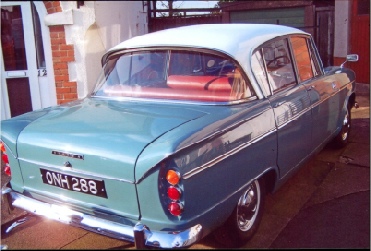
Nine ‘A’ Roadster
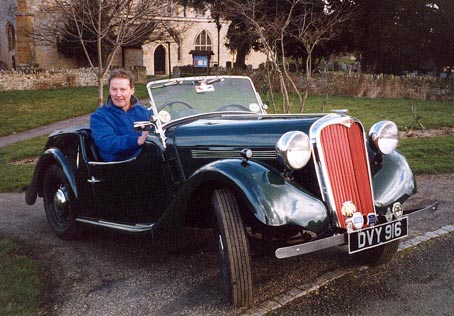
This Singer belonged to Keith and Margaret Hogben. It is a 1949 Nine “A” Roadster, which they owned from 1976. The car has the 1074cc ohc engine which gives a top speed of around 70mph. It has rod operated brakes, trafficators, beam axle, fold-flat screen, but NO heater! Keith and Margaret used to enjoy using the car regularly through the summer and drove it to the Netherlands and France on Singer Rallies. During their ownership they attended most classic car shows in their locality and, in 2000 they completed the Elfsteden Old-timer Rally in the north Netherlands.
14hp Saloon
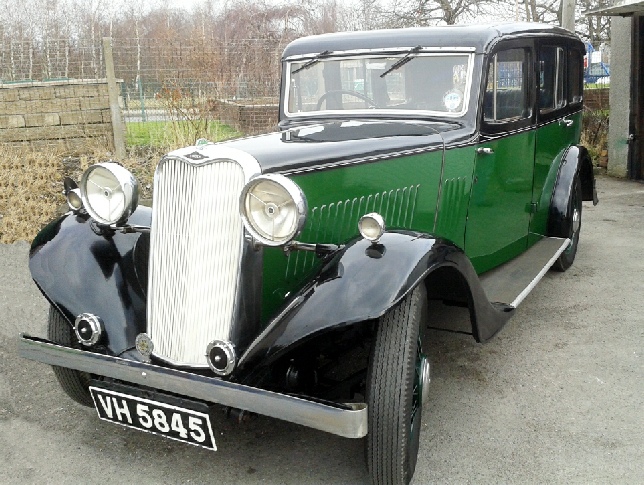
This is Arthur Judge’s well-loved 1934 Model 14hp Saloon, first registered on 1st December 1933. It is a very rare model, having been made for only I year, and is probably the only one of its kind in the UK. The car has 86,000 miles recorded, and its six-cylinder engine was overhauled in 1997. The car has had only two former owners and, not surprisingly, has won many shows over the years. It has also appeared in films – ‘The Yanks’ in 1978; ‘TV Thunder Clouds’ and ‘Omnibus’.




2 Litre Sports Coupe deluxe

This is Paul Luce’s 1933 Two Litre Sports Coupé DeLuxe. Paul inherited the car from his father, and it has stood in a garage on the island of Jersey and not been run for over twenty years, with the result that the paintwork has suffered badly, although the basic car is reported to be in a very good condition.
At last, with the car now out in the open, we can see its majestic lines and the promise of what is to come when Paul gets it back on the road.
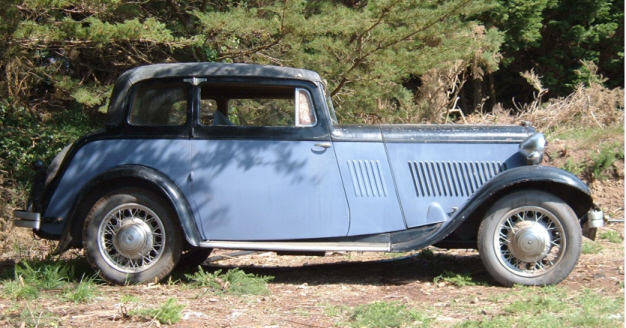
9hp Sports Tourer
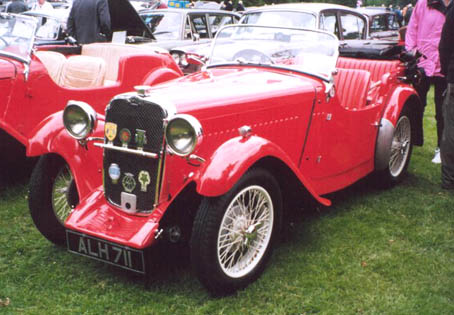
This is Viv Littlewood’s 1933 9hp Sports Tourer which was first registered in Somerset on 15th July 1933. Viv tells us:
“The car came into my possession in 1982 as a ‘Barn Find” in the village of Fiskerton, Nr Lincoln, the owner being a Mr D Gibson. The car was completely dismantled – just a jumble of parts in tea-chests and tomato trays. Not too far into the restoration I found that the ‘kit of parts’ was by no means complete. Fortunately, that summer, I had been on holiday to the Isle of Man, where I had found a wrecked 1934 ‘9’ Coupe (ANX740) in a bramble patch. The photographs I took showed that the parts I required were there for the salvaging. The owner agreed to let me have them and they were brought back to Yorkshire by other holiday makers. Returning from holiday in the Isle of Man the following year, I recovered all remaining salvageable parts-engine, axles, gearbox etc, and four years later the job was finished, I have since rebuilt two ’9’ LMs and am well into a third – my supposed retirement project!”
Gazelle Series IIIA Convertible
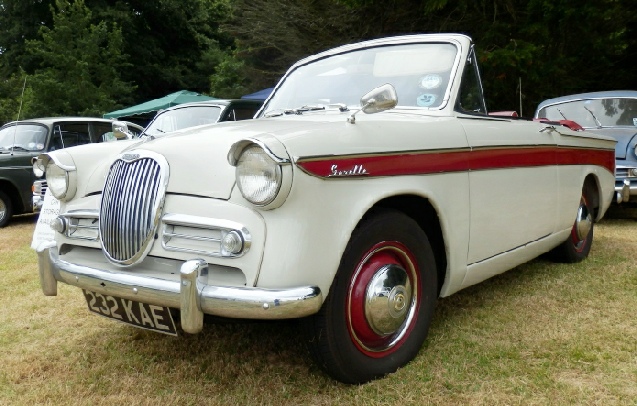
This is Barry Paine’s 1960 Gazelle Series llla Convertible, pictured on display at Powderham Castle. Following its purchase in 2011, and the subsequent eradication of some electrical gremlins, this attractive vehicle has proved an extremely capable performer. It has a 1494cc overhead valve push-rod engine, fitted with twin Solex carburettors and Lucas electrical equipment.

On the right is a picture of Barry with his car taken during a visit to George Singer’s grave in the London Road cemetery, Coventry.
Gazelle Series IIIA Saloon

This Gazelle Series lllA used to belong to Alyson Cheetham, but she reluctantly sold it and thinks it now lives in Ireland. And yes, this is the original colour which is called ‘Cloud Rose’ – Rootes Paint Code 049, with a Foam White flash. (Although the words “Shocking” and “Pink” come to mind!)
The car was in superb condition and was a joint winner of the Gazelle Trophy at the 2002 ASCO National Rally (SNCR) held at Newby Hall, Ripon, where this picture was taken.
1089 HP is also the original number, but since 1977 it has had 3 others – AUB 3 (1981), AOA 242A (1984) and 855 CKL (1989), which was someone’s personal plate. Fortunately, when this was taken off to sell the car, DVLA reissued the original “age-related” number, albeit, on a non-transferable basis.
The colour raises so many comments that Alyson had a pink sheet which she put in the car window. This politely (?) points out that it is the original colour, states the colours and codes, and finishes on the lines that if they still don’t believe it, they are welcome to crawl underneath and inspect her bottom, which is exactly the same shade of pink.
When Alyson got the car, the plush trim around the doors was in a terrible state, and of course, it was impossible to match it as the pink was obviously done just for the paint colour. Anyway, Alyson had been a lab technician in her father’s dyeworks, so they raided Dad’s dye stock, picked out the appropriate colours and set to work in the laundry room at home to make a dye recipe to match. They were very lucky and hit on the right combination fairly quickly using little sample pieces cut off the yards of beige plush trim they had started off with. However, the trim is pretty springy and trying to force yards of it into a bucket of boiling water and keep it there was a job and a half, but they eventually managed it and were really pleased with the result. Alyson wasn’t so pleased with the nicely pink-dyed floor, washing machine, tumble drier and freezer, and the black, white and pink Cocker spaniel she ended up with, but it wore off eventually!
One of the funniest comments on the colour came on the way home after buying the car, when it ran out of petrol on the M6. Of course, before long, having nothing better to do on a quiet Sunday, she was treated to the presence of the local Trafpol, who approached along the hard shoulder with blue lights a-flashing. She explained she had sent for fuel and would be away shortly, but they were quite excited by the sight of this pink car and had to get out and have a quick look. They were most intrigued and kept pointing out exciting features of the car to each other but she could hardly contain herself when one said in the broadest Brummy accent you could imagine: “It’s even got dongling doice (dangling dice – furry variety) in the window and bloimy, lewk at it’s number. Yow could sell it tew the Sauce Factoray” !!
Enough said!
Gazelle Series IIIA Convertble
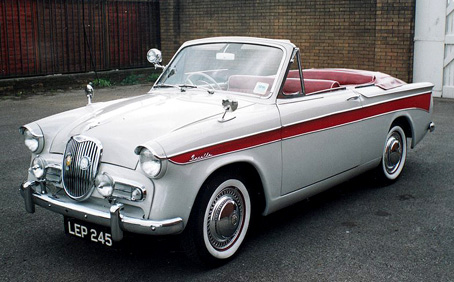
Jean Jacques Solero has bought this beautiful 1960 Gazelle IIIA Convertible. Jean lives in Perpignan in the South of France.
HRG 1100
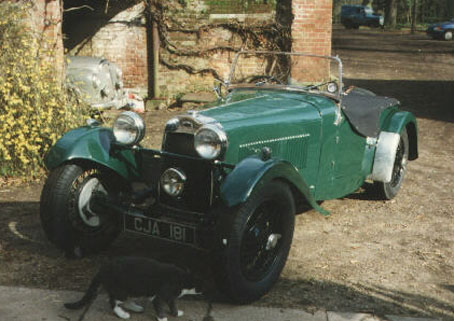
This is Barry Paine’s first HRG. It is one of 49 cars fitted with the sturdy Singer 1074 cc three-bearing crankshaft ohc engine originally fitted to the Singer Bantam in 1938.
HRG improved the manifolding and carburation to increase the available bhp. Built on traditional lines HRG sportscars were very handsome and had excellent roadholding and cornering abilities, which made them very competitive in sporting activities. Barry used it as much as possible and has driven it on the continent.
HRG also used modified Singer Twelve engines in their 1500 models. Barry’s current HRG is such a vehicle and can be seen here (below) in a part restored state.

Super Ten Saloon
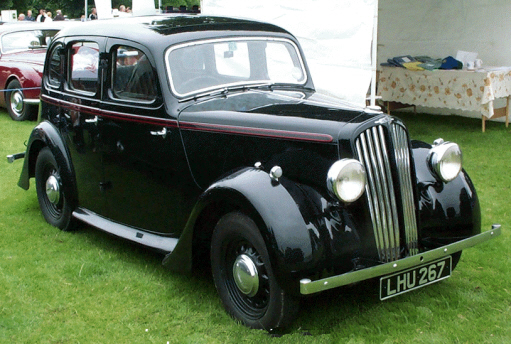
This 1948 Super Ten saloon originally belonged to Barry Paine.
It has a 1193 cc overhead camshaft engine and will cruise comfortably at around 50mph. It was purchased by Barry via eBay in2007. Although the body has been repainted to a high standard, the upholstery, carpets and headlining are original. Whilst in Barry’s ownership It took part in its first Singer rally at Newby Hall, Yorkshire in 2007, having been driven from Norfolk in rather poor weather conditions. During this event, the fuel system proved troublesome as there was 59 years’ worth of sediment in the fuel tank.
Gazelle IIIA Convertible

Chris Hayward with his superb 1960 Gazelle series IIIA Convertible at BEN Rally, Lynwood, Near Ascot. Chris, with raffle prize of sponge and shampoo, is talking to previous ASCO chairman and Gazelle Registrar, the late Dennis Page, himself a Gazelle fanatic.
Series III Gazelle
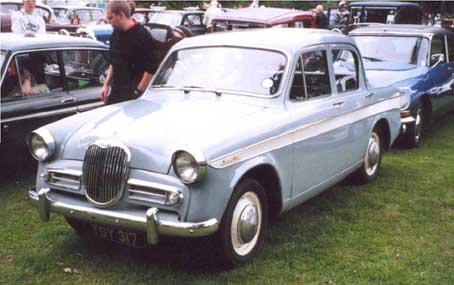
This is Barry Maclean’s 1959 Gazelle Series III, seen here at Newby Hall where ASCO held their Annual National Rally.
Series IIIB Gazelle Estate
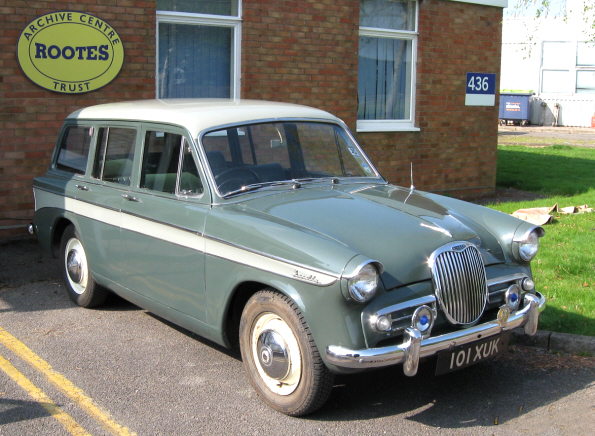
This is the late Rowena Heath’s attractive 1960 Series lllB Singer Gazelle Estate, which, as far as can be ascertained, is the only example of this model currently on the road in the UK, having spent most of its life on the Isle of Man.
Rowena was looking for an historic vehicle that would serve more than one purpose and was told about a Gazelle Estate for sale near Rugby. “The car had good paintwork and the underside appeared original – the paint was still even in the rear wheel arches!”
Rowena found that the car handled in an assured manner and could pull away strongly from roundabouts at 20-30mph without dropping into 2nd gear, and its climbing capability was fantastic. Rowena told us – “The Gazelle was equal in performance and handling to a Nissan Note I once hired – pretty good for a car 48 years older!”
Does anybody know where this rare car is today?
Junior Tourer
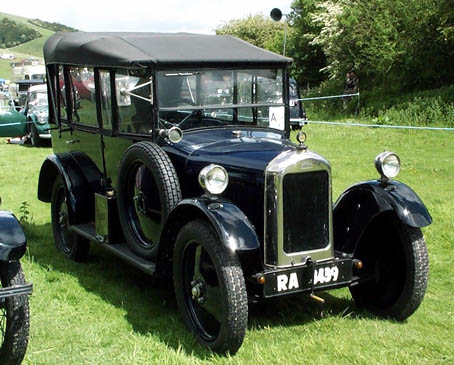
This is Dr James Anderson’s 1927 Junior Tourer, pictured at the Queen Elizabeth Park, near Winchester. This was the first of the Singer Junior models, with rod operated brakes on the rear wheels only, and featuring the 848cc overhead camshaft engine, the basic design of which powered the Singer range through the very successful Le Mans cars right up to the 1957 Gazelles. Thereafter, Rootes engines were used.
The car has magneto ignition and runs very well, with a top speed of 45 – 50 mph. Currently it is fitted with an SU side-draught carburettor, but Doctor Anderson still has the original brass, prettier looking, Solex for exhibition purposes. He also has the original engine numbered 2846, as listed in the buff log-book, which gives the date of first registration as 30th June 1927, and lists the previous owners back to 1946, when the car belonged to Mary T. O’ Donaghue from Castle Donnington. Mary sold it to Ronald Jeffries of Leicester in 1957. There were four or five more owners before Doctor Anderson bought Pearl in 1992.
14/34 Two Seater
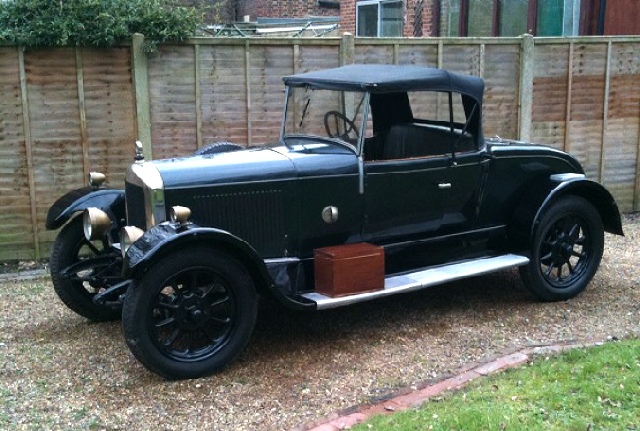
Back in the late 1980s, when I worked in the City of London, one of my colleagues’ father was a member of the Coir of Commissionaires, and from time to time acted as doorman at the Honourable Artillery company barracks at Armoury House, City Road, not far from my office. What has this got to do with Singers? you may well ask. Well those of us of a certain age may remember that Sotheby’s used to run regular vintage/veteran car sales there using the main parade hall. As is the practice today, entrance to the sale was by catalogue – a very glossy affair which at that time cost £10.00 each. My colleague and I would walk down at lunch time from the office and his father would give us a couple of catalogues – ‘Great’. On one occasion there was a Singer included in the sale. I didn’t know it was entered and anyway did not have the money. The car was sold for a hammer price of £7,200 – I still have the Catalogue!
The car was a rare, 1927 14/34 six cylinder. I had never seen one before, and at the time I thought it would be a nice car to have. I tried to trace the car a couple of times, but as far as I could find out it didn’t belong to an ASCO or SOC member, and no trace could be found through the VSCC lists – it seemed to have disappeared completely.
Time went by, and it was some time in 2003 that I heard Jim Edington had found and bought a 1920s six cylinder Singer. I was sure it was the same car, and was pleased that it had ended up in the hands of a Singer enthusiast. Jim had a 10/26 Senior and a Junior, and had helped me out with some bits when I had suffered a broken half shaft on my 10/26 many years earlier. I was pleased to meet Jim again at the 2005 Centenary and to confirm it was the same car I had seen all that time ago.
Unfortunately, in the intervening years somebody had stolen the registration number, but otherwise it looked good. At the end of last year I heard the Jim was thinking of selling.
Now the last thing I needed was another car, but you know how it is. I called Jim, and before I knew where I was, had arranged to view. The upshot is that the car is now in my garage (just enough room). Jim had not used it much since the centenary, but I have been going through it slowly and methodically, and the car is now back on the road.”
10-26 2-Seater

Alan tells us RO 2371 was first registered on 19th January 1926 by Mrs Filia Parker of Bennington House, Bennington, Hertfordshire and subsequently passed to her two spinster daughters. It appears the car remained at Bennington House until purchased by Mr George Brittain in 1966, and subsequently ended up in his Museum of Rural Life near St Neots, Cambridgeshire. The 10/26 remained in the museum until it closed in 1993 and was subsequently purchased by a local enthusiast before eventually passing to me in 2016.
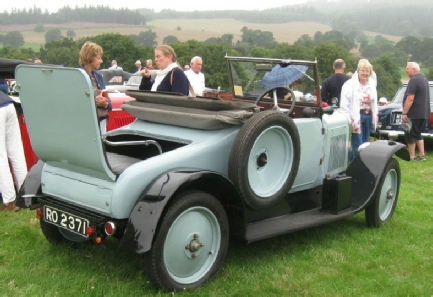
10-26 Tourer
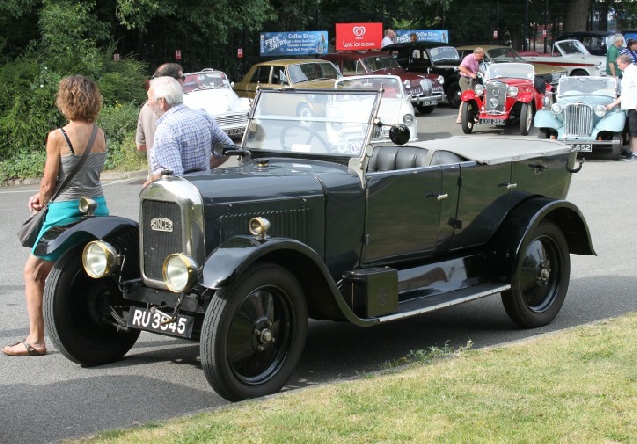
This is John and Jana Taylor’s 1926 10-26 Tourer (at Anderton Boat Lift in July 2014) who they fondly call George after George Singer who founded the Singer Company in 1875. Little is known of its history except that it was owned for two years in the early 1950s by a London solicitor, Sir Simeon Bull, who recalls that he had it maintained by a garage in Streatham run by Bill Cameron who operated at the ‘sawdust in the sump’ end of the market, which may explain why the car came to be in a pretty poor state. When George was restored in 1979 by Gerry Barr’s workshop in Fordingbridge, its original maroon and black colours were changed to smoke grey and black. George then had owners in Hampshire, Dorset and Frome, Somerset from whence John and Jana bought him in 1993. The drawing of George (below)

was by artist Richard Wheatland.
10/26 Saloon
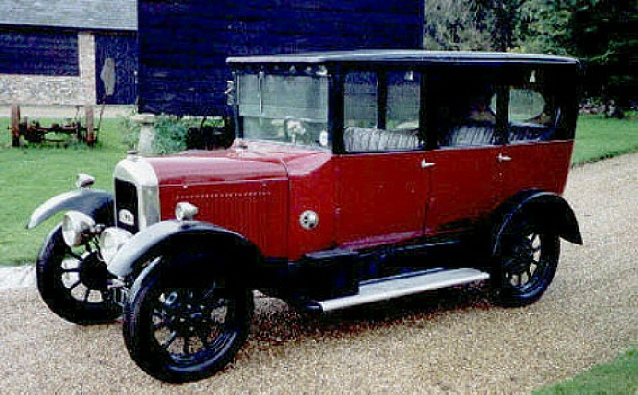
This Alan Baker’s lovely old 1925 Singer 10/26 Saloon, previously owned by SMC chairman Barry Paine
Bantam and Bantam Tourer
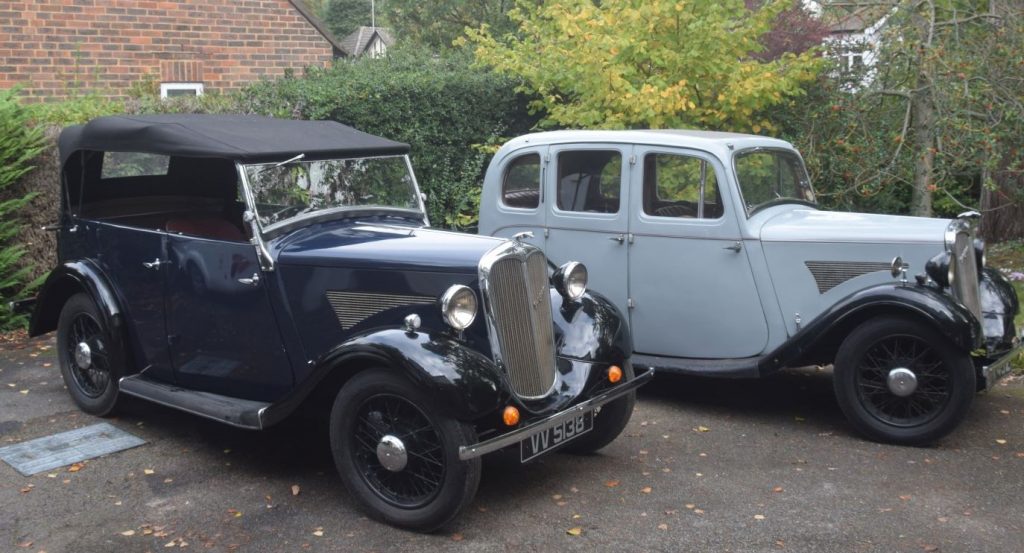
This is David Garn’s delightful pair of Bantams – his 1936 grey Bantam 4 door saloon and his dark blue Bantam Tourer. The 4 door Bantam Saloon was bought new in June 1936 by Albert Brown a grocer in Reigate. When Albert became ill sometime in the 1950s, the car was left in his lock-up until his wife died in 1983. It was then sold to a Mrs Shelley in Reigate who stored it in a barn with the intention of putting it back on the road.

The Bantam, pictured at Brooklands in 2001.
In 1989, the Bantam was bought by Phillip Isherwood in Redhill, who stored it outside whilst he had a garage built. Unfortunately he became very ill and the car was sold again. This time it was taken to Littlehampton, where a Morgan enthusiast, Anthony Lindus, dismantled the car completely, repainted the bodywork and reassembled the vehicle before putting it back on the road in 1990. He used it for a couple of years, including taking his daughter to her wedding. Over the next 15 months the Bantam covered just 90 miles, before it returned to Littlehampton in part exchange for another motorbike.
For the next two years the Bantam was driven regularly, taking children to school, before it was once again offered for sale, this time to finance a loft extension.
David has owned the Bantam since 1998, and he has driven and displayed it around the country. This is one of only 14 Singer Bantam cars currently roadworthy in England and the only 4-door 972cc saloon in regular use. Despite being 71 years old this car has driven a total of only 40,000 miles from new.
CLICK HERE to view David’s Singer Bantam Register Site
4AB Roadster
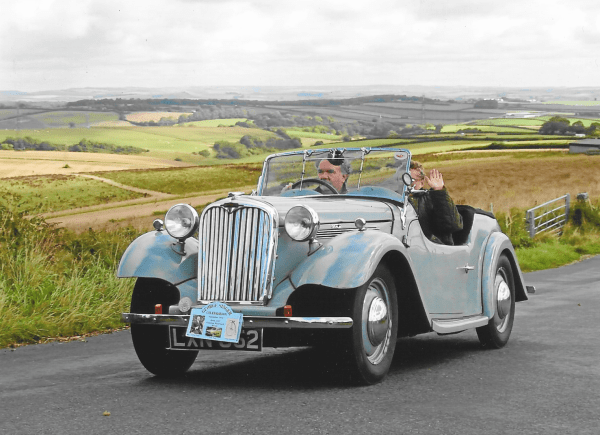
This is Ronnie Johnston’s superb Salvador Blue 1951 Roadster 4AB, which he purchased as a stable-mate for his Morris 8 2-seater. The car had been fully restored in 1988 and is now gracing the streets and attending rallies around Glasgow, where Ronnie says there are very few Roadsters. It will doubtless attract many admiring glances.
Gazelle Series III Convertible
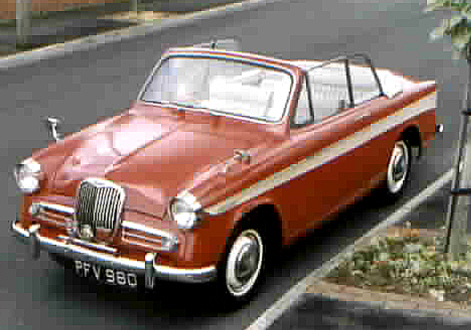
This delightful Singer Gazelle belonged to a club member, Nigel Morley, some years ago. It is a 1959 Gazelle Series III Convertible. This car had only one owner before Nigel bought it in Lytham St Annes. It is still 100% original and has done only 40,000 miles. Unfortunately its first owner did not take the option to have a heater fitted – that was an extra, and may explain why the car is still in such excellent condition – it didn’t go out much in the winter weather! Does anybody know where the car is today?
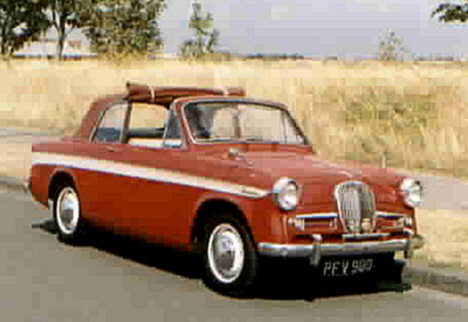
Gazelle Series 1
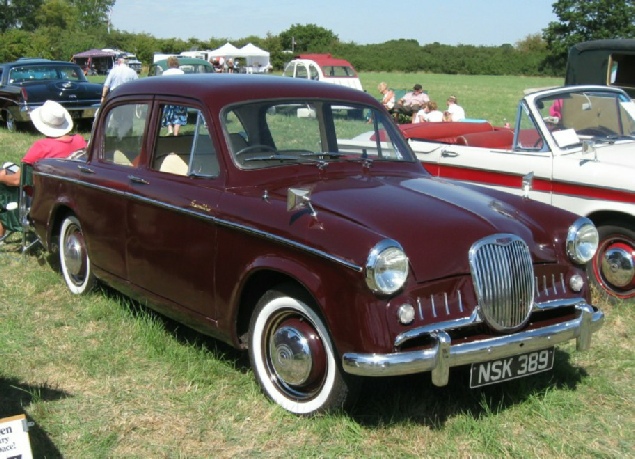
This is Rory Angus’ 1957 Gazelle Series 1, which he bought on e-Bay from a garage on the west coast of Scotland. It was not running and in quite a sorry state, so he had it brought down to its new home in the New Forest and spent a about a year renovating it. John Bramwell found that it was at an ASCO event at Losely about 20 years ago when it was owned by Ron Forey. It came came 2nd in the Gazelle class. Ron then sold it and it’s not known what happened to it until it turned up on e-Bay.
Ten hp
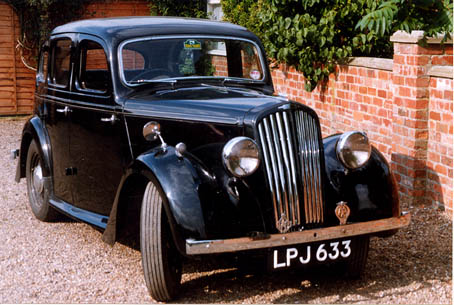
This is Bill Tull’s 1947 10hp Saloon called Liza. Liza was bought new by Bill’s father and has been in the family ever since. Bill has completely rebuilt her over the years and in 1975 gave her a full respray – he remembers using 16 pints of cellulose @ 10s 6d (52 1/2p) a pint! The car is still running well – on unleaded fuel with no modifications – and cruises at 50 – 60 mph, giving 36mpg.
Roadster A
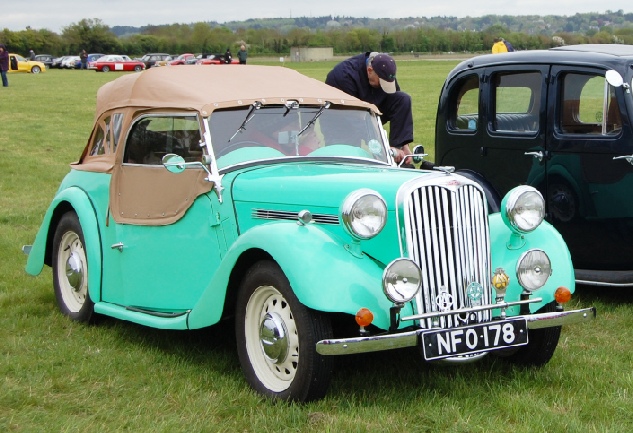
This delightful Singer was for a number of years in the possession of Richard and Pat Heaton. It is a 1946 Model A 9hp Roadster, produced for the post-war export drive, having been developed from the 1939 Roadster. They named her Letticia, or ‘Lettuce’ for short, due in no short measure to her colour.
This one is Mint Green, a colour which they believe was developed for the American market. However, this car was originally delivered in black, with red upholstery, to Mr R Benbow from Gordan Cars of London. It has a 1074cc engine with a 3 speed manual gearbox, giving a lusty performance for its age and size, with 36 bhp at 5000 rpm. Maximum speed was 65 mph, almost 40 mph being achieved in 2nd gear!
The brakes are mechanically operated by rods, and are surprisingly efficient. The ‘Nine’ is neither a placid saloon nor a sports car, and she gave Richard and Pat great pleasure. They had comfortable, if not incident free, tours to North Norfolk and a variety of other venues. She’s even been a much admired wedding car, although the bride opted for the ‘Hood up’ option after a trial run with the hood down.
The car was previously owned and partially rebuilt by Brian Hawksbee of Swindon, who sadly lost his battle with cancer. When Richard and Pat first acquired her she had a seemingly insoluble fuel starvation problem. They tried (almost) everything, even installing an electric auxilary fuel pump. In desperation the fuel tank was removed to inspect its interior, which was sound, then a friend asked if they’d ever blown through the fuel pipe? They hadn’t, so, no expense spared, they did, and out popped a slug of cobweb and gloop – problem solved!
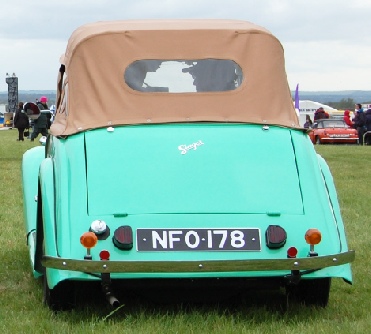
Having replaced the gear box, the rear axle was also found to be noisy. This was when they found there was no oil in the diff. So having also now replaced the diff, Richard’s motto is: “Never assume anything has been done when you acquire a car!
A load of other jobs have also been done around the car, and she now drives like a dream, especially since having the steering box refurbished – with less free play at the steering wheel, she is much easier to point in the right direction.
The current owner is unknown.
9 Sports
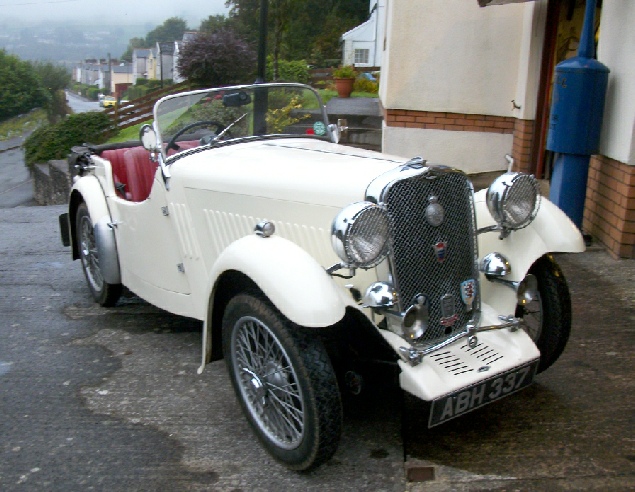
This lovely 1933 Nine Sports 4-Seater belonged formerly to Jim Keniston. It was first registered on 19 May 1933. From the old log books Jim has, it would appear ABH 337 had at least 18 previous owners, including a spell with the Harold Ruger at the British Army of the Rhine HQ in 1950, and another with the RAF at Dunsford, Cambs, in 1954. In 1963 it was bought by Bob Alexander for £5, which turned out to include a partially dismantled LM Sports Coupé for spares! Bob got it on the road in 1965 and ran it until 1967, when it became unreliable and he sold it for £50 to Kenneth Matthews in Southampton, from whom Jim bought it.
Jim says: “In 1976 I saw a 1934 Singer Sports for sale in Exchange and Mart for £260. When I saw the car in Southampton later that day it turned out to be a 1933 Four-seater. The vendor said if he had put that in the advert no one would have answered the advert! (I know I wouldn’t.) But we liked the pathetic looking heap, and bought it, together with a Land Rover full of spares for £300. After a lot hard work, money and, well you all know what I mean, it was back on the road in 1980, and won every show it entered. That was pay back for the hard work done, and after that we just drove the car and enjoyed it.
One afternoon in 1988, there was a remarkable co-incidence – Bob Alexander was looking for a Unit on the Westbury Trading Estate, when he saw a Singer 9 like his old one, on the forecourt of TT Services where I worked. As he got closer he could see it was ABH 337 – his old car! He called in and was told it belonged to a member of their staff. Initially, I was a bit doubtful, but then Bob pointed out a chassis repair that only he and I would know about. And I was able to show Bob the original log book with his name in it! Also remarkable was when we found we both lived in Trowbridge, and less than a mile apart!
Over the last 34 years we have travelled about 70,000 miles all over the UK and Europe with the Singer Car Clubs, and just going on holiday, sometimes with the car full of camping gear. The car has had several types of engine in it to keep it going, as I like to use it and can’t afford to be a purist. It now creaks and groans a bit, or is that me?”
ABH 337 is currently in the capable hands of Nigel Hughes.
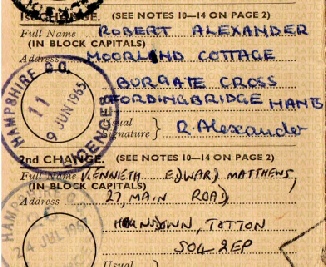
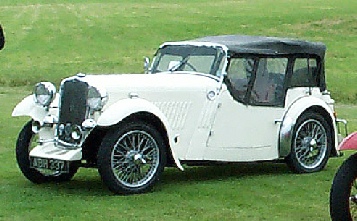
9 Saloon
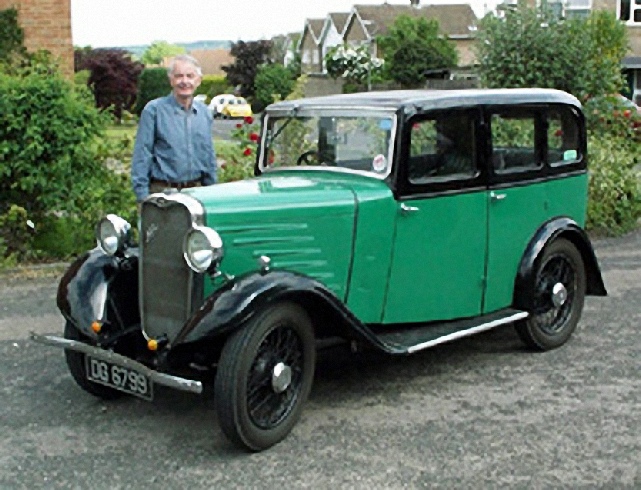
This is John Price’s 1933 9hp Saloon which John fully restored over a period of some 17 years. John’s longest journey in the car so far was when he drove it to Derbyshire for his daughter’s wedding, with no problems at all.
John also has a 1924 Ten hp Two-Seater, which he has also fully restored.
10/26
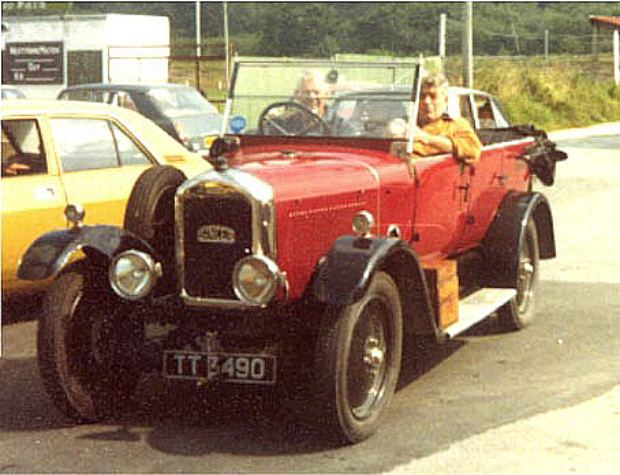
Simon Bishop’s 1925 Singer 10-26 Tourer
Simon’s not sure exactly when he took this picture, but thinks it was in the summer of 1978. The two gentlemen in the car are Jack and Arthur Bennett and the location is opposite their garage in Par, Cornwall.
Jack and Arthur’s father purchaesed the car when it was about a year old from someone in Plymouth, as evidenced by a theatre ticket for the Plymouth Hippodrome dated 1st Jan 1926 found in a door pocket. Mr Bennett senior, who was the local blacksmith, started making his own bicycles in the cycling boom of the 1890s. This progressed to the repair and maintenance of motor cycles and eventually to all sots of motor vehicles, agricultural implements and even steam engines. The 10/26 was his own personal car and was not used for business – they had a cheap old Austin for that! However, Jack and Arthur were allowed to use the car socially, which for two working class teenagers in the 1930s was quite something. The car was used continually until September 1939 (Simon still has the tax disxc), when she was taken off the road to repaint the front wings. This of course coincided with the outbreak of the second world war, so the Singer was put in a shed at the back of their garage premises and forgotten about.
After the war she was considered to be too out f date to be bothered with, so it was not until 1972 that he pushed TT 3490 out of the shed. She was very rusty, due surely to the seea air, her resting place being only a stones throw from the beach. For the record, Simon drove the car down to Par in one day, taking about 10 hours. Jack and Arthur were delighted to see the Singer again, as were a lot of the locals, who kept stopping and saying “is this your old car Jack … do you remember the time we …”
The car was first registered on 23rd April 1925 and was described by the Singer Owner’s Club at the time as ‘Historically Indecent’, due to it having front wheel brakes. However, it later transpired that some time in the 1930s the king pins were found to be very worn, and rather than fit new pins and bushes, Jack and Arthur fitted a whole axle the had lying around, unwittingly updating the spec to late 1925.
Ten hp
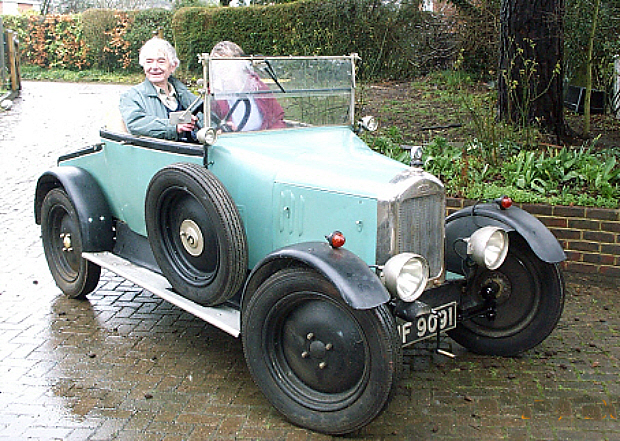
This is John Price’s 1924 10hp with Dickey Seat. John bought the car at the Singer Centenary at Stoneleigh Abbey in August 2005, and by March 2006 had completed a full mechanical restoration. John has left the body, however, virtually as when the car was found after having been laid up for 40 years. By July 2006 Audrey had made a new cover for the hood, which went on display at the Bordon Garrison Church Fete – as you can see from the picture, it is a very professional looking job.
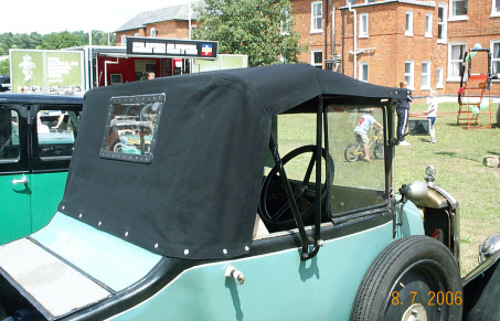
Ten hp
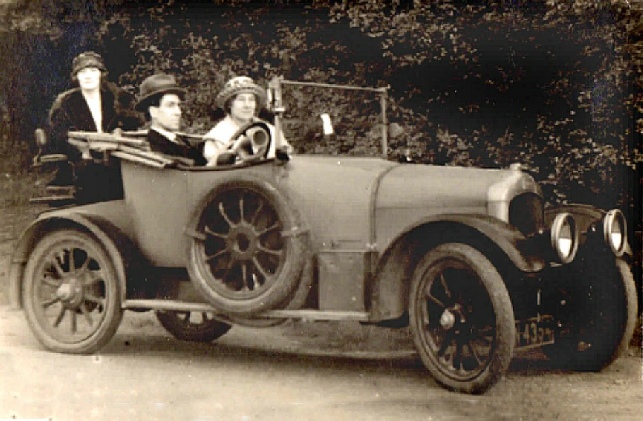
This is Colin Borley’s 1919 Ten HP as it was around 70 years before Colin acquired it as a pile of bits. Colin tells us:
The car was all there, including the second spare wheel visible in this 1920s picture, but minus the steering column to dash board mounting bracket, which I had to make. The rest had been scattered around several garages and sheds. If I’d hunted long enough I bet I would have found this bracket too! The engine was in a wheel barrow and the body perched on a shopping trolley. I finally found the exhaust manifold in the bottom of a 45 gallon oil drum full of alternators, and when I described the missing magneto to a guy who was hovering about, he said: “Oh I think I put that in the shed on my allotment.” And sure enough, there it was – a genuine BTH ML made at the BTH factory in Coventry, which was right next door to Singer’s Read Street works.
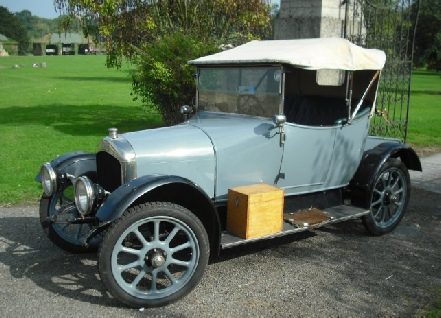
The rebuild took me 15 months, since when the car has won a prize at Alexandra Palace Classic Car Show in 2002, been to several NEC shows, driven on the Brooklands banking and attended many events annually, including ASCO’s 2014 Singer National weekend in Cheshire.
I bought the 1920s card from E-Bay, but there was nothing written on the back, and despite several articles in the Romford papers, where we think it lived most of its life, nothing has surfaced to establish any links.
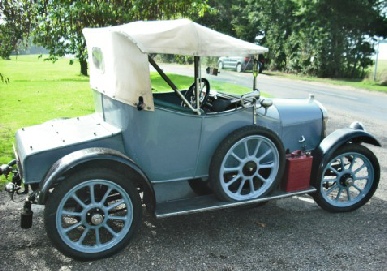
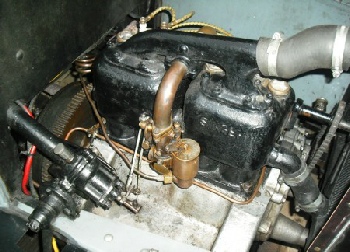
Model 11
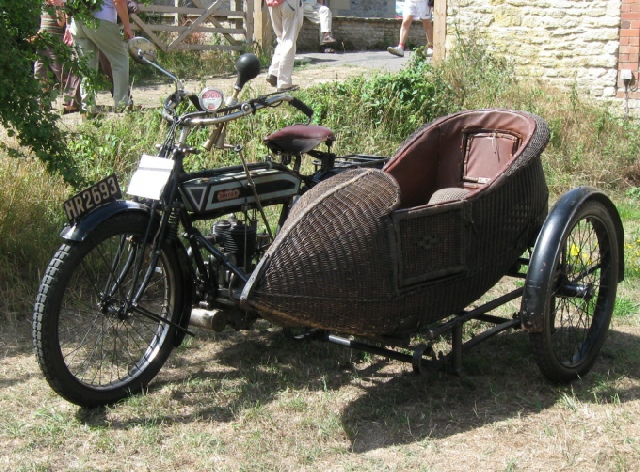
This is Stuart Bramwell’s 1912 Model 11 Motorcycle with Side-car, seen here on display at our 2010 SNCR held in Lacock in Wiltshire
12-14 hp
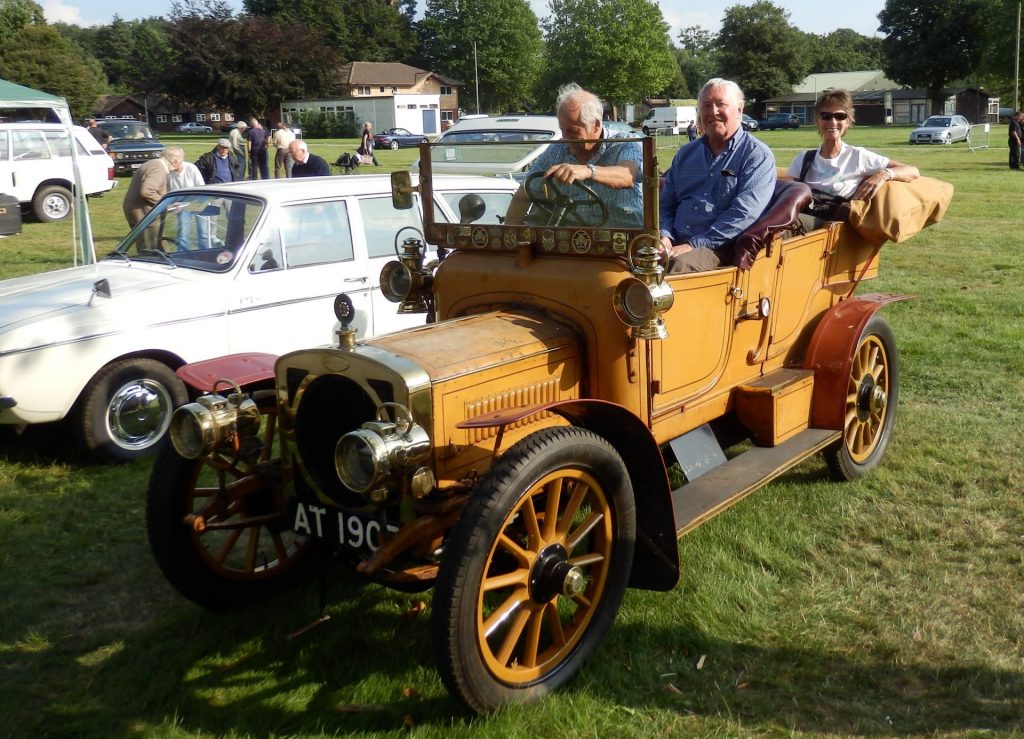
This is Simon Bishop’s 1907 Singer four seater 12-14 HP.
In 1907 Singer offered a new range of four wheeled cars the smallest being a 7HP 2 cylinder two seater powered by a White & Poppe engine also a 12-14 HP four seater four cylinder also powered by a White & Poppe power unit. They also offered a 15 HP and a 20-22 HP both powered by Aster engines .
The car you see here is an example of a 1907 12-14 HP White & Poppe engine car. White & Poppe were proprietary engine manufacturers who supplied to may car manufacturers in the early part of the century including Dennis, who eventually took over the company. With the exception of the engine the remainder of the car is of Singer design with the gate change gearbox giving three forward speeds plus reverse driving through a leather and metal cone clutch via a propeller shaft to a substantial rear axle. Brakes are internal expanding in the rear axle with the addition of a transmission brake.
The car was discovered by a Singer agent Nicholls and Sons Ltd Bedford in 1938 in a cart shed, the agent thought it would be a good idea to use it for promotional purposes to advertise the Singer name. With this in mind it made an appearance at the Singer Motor Car Club rally in Leamington Spar in June 1939. At the outbreak of the second world war Nicholls stored the car in the paint shop which was warm and dry. After the war the car was again used for promotional events and in the 1950’s acquired by C.B. North of Northwood Motors (Hull) Ltd who were also Singer agents. The car stayed with the North family until recently when acquired by the present owner.
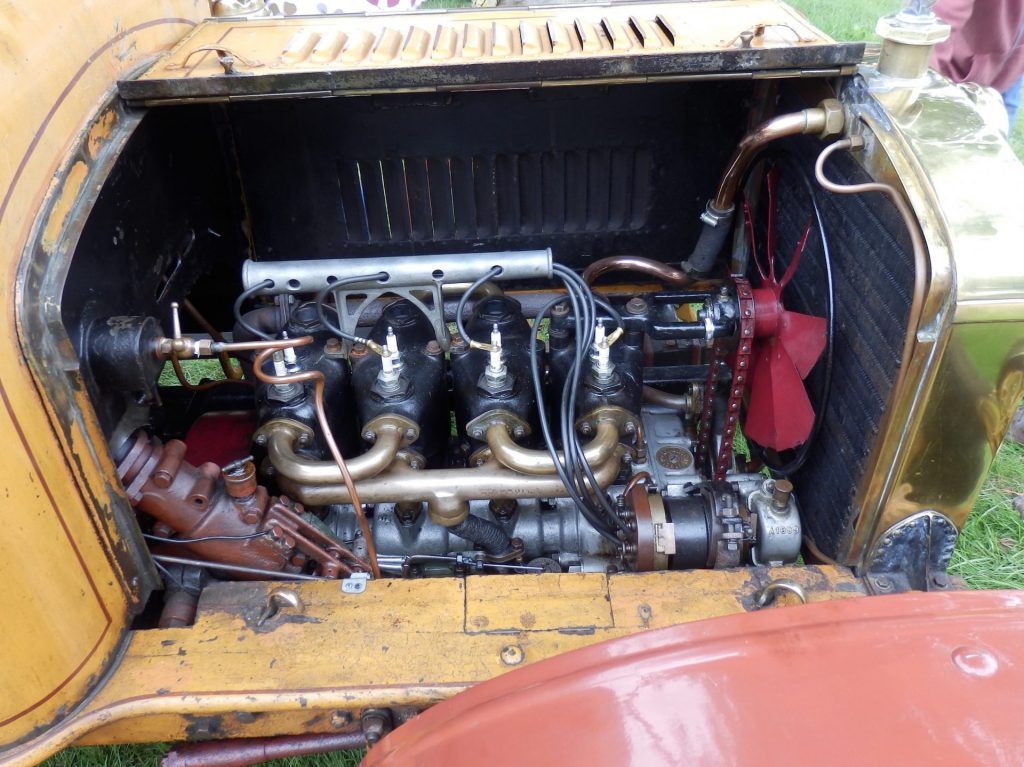
De Luxe Gentleman’s Tricycle
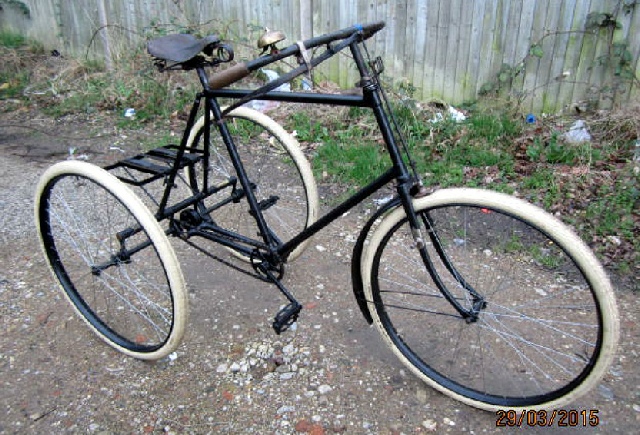
This is Robert Berry’s 1896 De Luxe Gentleman’s Tricycle, which he purchased in 2010 from a dedicated cycle auction based in Reading. All the auction lots were the property of Air-Marshall Sir Freddie Sowrey.
After getting the machine home he realised it was only about 50% original – the rest had been added in the 1960s & ’70s. He eventually managed to find, make or have made the correct parts, and the machine has since completed two London to Brighton runs, attended several local shows, and in Nov 2016, was displayed on the ASCO stand at the NEC in Birmingham. – See picture – right.
As you can see, the Trike now has a period Picnic Basket and 1895 H Miller & Co Ltd, “The Bell Rock” front lamp.


